Unfinity Release Notes
Compiled by Mark Rosewater and Jess Dunks
Document last modified: October 7, 2022
PDF Download Links:
English
The Release Notes include information concerning the release of a new Magic: The Gathering set, as well as a collection of clarifications and rulings involving that set's cards. They are intended to make playing with the new cards more fun by clearing up the common misconceptions and confusion inevitably caused by new mechanics and interactions. As future sets are released, updates to the Magic rules may cause some of this information to become outdated. Go to Magic.Wizards.com/Rules to find the most up-to-date rules.
The "General Notes" section includes information about card legality and explains some of the mechanics and concepts in the set.
The "Card-Specific Notes" sections contain answers to the most important, most common, and most confusing questions players might ask about cards in the set. Items in the "Card-Specific Notes" sections include full card text for your reference. Not all cards in the set are listed.
GENERAL NOTES
Mark Would Like to Say a Few Words
For previous Un- sets, I've written a lengthy document answering as many questions as I could think of about the new cards in the set. Unfinity is going to be a little different. Because the set includes both acorn and eternal cards (see below), I've enlisted some help. As Un- Rules Manager, I'll be providing answers for the acorn cards. Rules Manager Jess Dunks will be providing answers for the eternal cards.
I tried to answer every question I could think of, but Un- sets are breeding pools for cool questions, so if I missed anything (acorn, at least), feel free to write me at Blogatog with more questions. You can find me at MarkRosewater.Tumblr.com.
Acorn, Eternal, Un- Games, Silver Borders, and Card Legality
Starting with Unfinity, we are retiring silver borders to denote cards that aren't tournament-legal and don't conform to the rules of traditional Magic. In their place, we're introducing a new acorn symbol to indicate Un- ness. Cards that would previously have been silver-bordered will now have an acorn-shaped symbol or security stamp at the bottom instead.
From a rules perspective, acorn symbols and silver borders mean the same thing. Cards with acorn symbols on them aren't legal in most Constructed tournament formats. Notably, they aren't legal in Standard or Commander. Effects that previously referred to "silver-bordered games" now refer to "Un- games." An Un- game is any game that includes at least one player using cards with acorn symbols or silver-bordered cards (from previous Un- sets or promotions). Note that the effects of cards that refer to a card's border, like Border Guardian, aren't changing: they'll still refer to the border on the actual printed card. Older silver-bordered cards still have silver borders, and new acorn cards have black borders.
But with Unfinity, acorn cards are only half the story. Not every card in the set has an acorn symbol. The other cards, known as "eternal cards," are just like cards in any other expansion. They conform to the Comprehensive Rules, although in many cases they necessitated new rules being written. Unfinity eternal cards are legal in the Commander, Legacy, and Vintage formats. Unfinity cards printed at common rarity are also legal in the Pauper format.
Go to Magic.Wizards.com/Formats for a complete list of formats and their permitted card sets and banned lists.
Go to Magic.Wizards.com/Commander for more information on the Commander variant.
Go to Locator.Wizards.com to find an event or store near you.
The Un- Game Golden Rule
Each acorn card* has definitive Oracle text that tells you how the card plays, listing its current rules text, creature types, and so on. However, if a card refers to features of the printed card (such as what's in its art, what watermark it has, or how many lines of flavor text it has), look at the printed card you're playing with to figure out the results. In games without acorn cards, all cards with the same English name are treated the same, no matter which version of a card you're playing with (Shivan Dragon is Shivan Dragon is Shivan Dragon). In Un- games? Not so much.
*A few cards in this set and cards from Unstable have variants with the same name but different characteristics. And there are also Attractions and their lights (see below). What can you do?
Special Rule for Drafting Unfinity
As a special rule while drafting Unfinity, when each pack of Unfinity is opened, the person who opened the pack takes out the sticker sheet, a borderless land (either a full-art basic land or a borderless “shockland”), and the token card. If there are multiple borderless lands in the pack (such as when one appears in traditional foil), the player may choose one of them to take out, leaving any remaining ones in the pack. The land that they took out is added to the player’s card pool and they may put it in their deck.
UNFINITY KEYWORDS AND OTHER MECHANICS
Stickers!
What better way to commemorate your visit to Myra the Magnificent's Intergalactic Astrotorium of Fun than some bright, colorful, game-altering stickers? Each Unfinity booster pack includes a sticker sheet with three name stickers, three art stickers, two ability stickers, and two power and toughness stickers. There are 48 unique sticker sheets.
Stickers can be placed only when an effect specifically tells you to. Each ability sticker and each power and toughness sticker has a ticket cost. Tickets are a new kind of counter that players get, denoted by {TK} in this document. As you place a sticker, if that sticker has a ticket cost, you must pay that many ticket counters. If a sticker doesn't have a ticket cost, you don't need to pay anything.
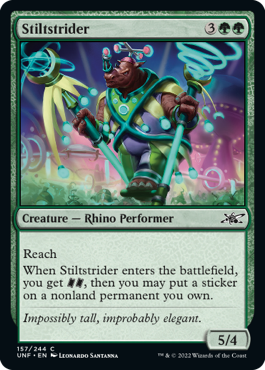
Stiltstrider (eternal)
{3}{G}{G}
Creature — Rhino Performer
5/4
Reach
When Stiltstrider enters the battlefield, you get {TK}{TK}, then you may put a sticker on a nonland permanent you own.
Stickers remain on a card in any public zone, even if the card is put into a graveyard, is exiled, or is put into the command zone. Stickers are removed from a card if the card is put into a player's hand or library. Stickers are removed from a token if the token leaves the battlefield and ceases to exist. The game ending will also do a pretty good job of removing stickers. After a sticker is removed, it goes back to the sticker sheet it came from. It can be stuck again if an effect allows it. When instructed to place a sticker, you must take a sticker from a sticker sheet. You can't take one that's already stuck to a card.
During each game, you have access to a maximum of three sticker sheets. Here's how to determine which sheets you have access to each game:
- In Constructed events, if you choose to include sticker sheets in your decklist, you must include a minimum of ten sticker sheets, and all of them must be unique. Before each game, choose three of them at random. Those are the three sheets you have access to that game.
- In Sealed Deck events, before each game, choose up to three sticker sheets from among those you opened. You can use the same sheets from game to game or switch it up.
- In Booster Draft events, sticker sheets aren't drafted. After you open an Unfinity booster pack, remove the sticker sheet before drafting any cards. Each game, choose up to three sticker sheets from among the ones you opened. Again, you can use the same ones each game or switch it up.
General rules for stickers:
- The four types of stickers are name stickers (which add to a card's name), art stickers (which add to a card's art), ability stickers (which add to a card's abilities), and power and toughness stickers (which set a card's base power and toughness).
- You can never put a sticker on a card (or other item) you don't own. Even if an effect appears to allow this, you still can't do it.
Tips for name stickers:
- Name stickers change a card's name. This is a text-changing effect.
- When placing a name sticker, you can place the sticker before, after, or in between words in a card's existing name. A name sticker can't replace a word in a card's name. For example, if the name sticker is "Dark" and you're placing it on Runeclaw Bear, the result is a creature named either Dark Runeclaw Bear, Runeclaw Dark Bear, or Runeclaw Bear Dark. Words are separated by spaces, not punctuation—meaning, for example, that you can't insert a name sticker between "Sol" and "Kanar" in Sol'Kanar the Tainted.
- When placing a name sticker on a non-English card, if you're not playing an Un- game, refer to the card's English name in order to determine where the sticker goes and what name the card will have afterward. If you are playing an Un- game, just use the non-English name of the card. Thus, a German Runeclaw Bear might become Dark Runenklauenbär or Runenklauenbär Dark.
- A few cards in this set include blank lines in the name, inviting you to fill them in with name stickers. Those blank lines are just suggestions—for rules purposes, they are not words that make up part of a card's name and you are not required to place your stickers in those blanks. Rather, you can put stickers anywhere in those cards' names as long as you follow the rules outlined above.
- In many cases, a sticker won't physically fit where you intend it to go, which is fine. Simply announce the new name to all players as you're placing the sticker.
- Name stickers can't be used to change any text on a card other than its name. Notably, they can't be used to change a creature's creature types. Similarly, stickers other than name stickers can't be used to change a card's name.
- In most instances where a card's rules text refers to that card by its printed name, that text still refers to that card, even if the name has been changed by a name sticker. A notable exception to this rule is phrasing in the form of "[permanents/cards/other group] named [card name]," which continue to refer only to the specific name the phrase identifies, regardless of the card's current name. For example, if Juggletron is renamed Dark Juggletron because of a name sticker, its ability "Whenever Juggletron attacks" will still trigger each time Dark Juggletron attacks. On the other hand, if Genasi Enforcers is renamed Dark Genasi Enforcers, its ability "Creatures you control named Genasi Enforcers get +1/+0 until end of turn" will no longer affect itself, because its name is no longer Genasi Enforcers.
- If an effect instructs you to choose a card name, you must choose an existing (unmodified) card name that appears on a printed card. Dark Runeclaw Bear and Dark Juggletron unfortunately aren't on the list.
- If a card with a name sticker on it later changes its name to a different name (usually because it became a copy of something else), the name sticker continues to modify the new name. The name sticker maintains its relative position in the new name based on how many words came before the sticker in the old name. For example, if Runeclaw Bear Dark became a copy of Birds of Paradise, the "Dark" name sticker would continue to modify the creature's name after the second word, becoming Birds of Dark Paradise. If it instead became a copy of Realmwalker, which is only one word, the name sticker would just go to the end of the name, becoming Realmwalker Dark.
Tips for art stickers:
- Art stickers add to a card's existing art. Art stickers don't remove any elements that are part of a card's unmodified art. For example, if a creature is wearing a hat in its art, it's still wearing a hat, even if you cover the hat with a sticker.
- In Magic games that don't use acorn cards, art has no effect on gameplay. The specifics of the art stickers won't matter, but some effects may still care if a permanent is stickered or not.
Tip for ability stickers:
- Ability stickers always add abilities. They never remove abilities or other text, regardless of their physical placement. An ability sticker doesn't have to be placed in a card's text box. It will function no matter where it is on the card.
Tips for power and toughness stickers:
- Power and toughness stickers set the base power and toughness of a creature to new values. The sticker will overwrite the printed power and toughness of the creature, as well as any earlier effects that set its base power and toughness. After the sticker is put on, any new effects that change the creature's base power and toughness will apply as normal, and when those effects expire, the creature will revert to the base power and toughness set by the sticker. If multiple power and toughness stickers are put on the same creature, the most recent one applies.
- Effects that modify the power or toughness of the creature without setting it to specific values will apply to its new base power and toughness no matter when they started to take effect. The same is true for counters that change its power and toughness.
- If a creature card has a star (*) in its power and/or toughness as well as a characteristic-defining ability that sets its power and/or toughness, any power and toughness stickers on it will overwrite the ability. For example, if Tarmogoyf has a 3/3 power and toughness sticker on it, its base power and toughness is 3/3.
- You can put a power and toughness sticker on a noncreature permanent. The sticker won't do anything immediately—noncreature permanents don't have power or toughness. If a Vehicle with a power and toughness sticker becomes crewed, it will use the new base power and toughness while it's a creature. The same is true if a noncreature permanent with a power and toughness sticker turns into a creature through any other means, but most effects other than crew that turn a noncreature permanent into a creature also state what its base power and toughness will be, and those values will overwrite any power and toughness stickers that were already on that permanent.
Attractions!
The rides. The shopping. The food. Space carnivals really do have it all, and there's no time to waste. Let's head to the midway!
Attractions are a new artifact type. Attractions don't go in your main deck. They don't have normal Magic card backs. Rather, they are played in their own deck called the Attraction deck. To get the most out of Attractions, we first need to get them onto the battlefield. Several cards in this set have abilities that instruct you to open an Attraction.
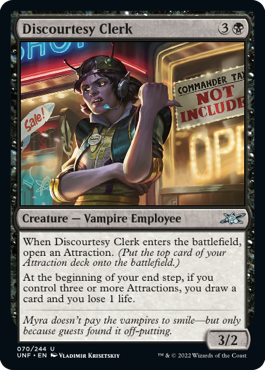
Discourtesy Clerk (eternal)
{3}{B}
Creature — Vampire Employee
3/2
When Discourtesy Clerk enters the battlefield, open an Attraction. (Put the top card of your Attraction deck onto the battlefield.)
At the beginning of your end step, if you control three or more Attractions, you draw a card and you lose 1 life.
As the reminder text indicates, to open an Attraction, put the top card of your Attraction deck onto the battlefield face up. Each Attraction has lights numbered 1–6 on the right side of its text box, some of which will be lit. Different versions of the same Attraction can have different numbers lit, but 6 will always be lit and 1 never will. At the beginning of your first main phase on each of your turns, if you control one or more Attractions, you roll a six-sided die. This is called "rolling to visit your Attractions." You "visit" each Attraction you control that has a lit number matching the result of that roll. You must roll the die every turn as long as you control any Attractions (they're just too irresistible!).
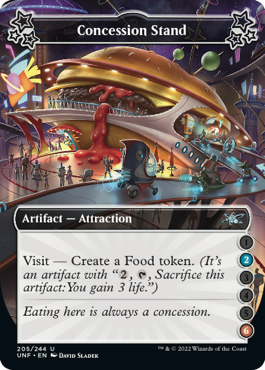
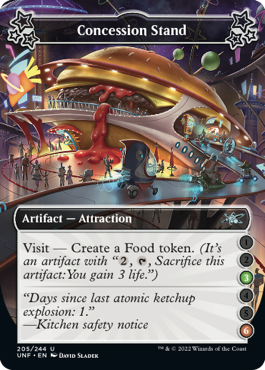
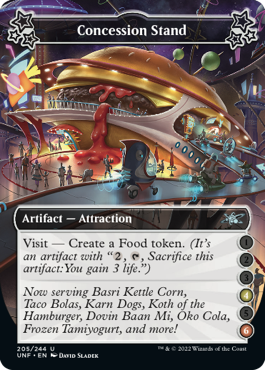
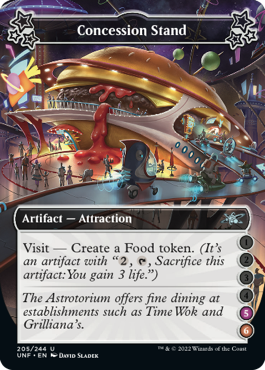
Concession Stand (eternal)
Artifact — Attraction
Visit — Create a Food token. (It's an artifact with "{2}, {T}, Sacrifice this artifact: You gain 3 life.")
Each visit ability is a triggered ability. Whenever you visit that Attraction, the ability goes on the stack. When it resolves, you perform the actions after the dash. If multiple visit abilities trigger simultaneously, you can put them on the stack in any order. You can't choose to skip any visit abilities that trigger (in the Astrotorium, fun is mandatory!). Effects can also instruct you to roll to visit your Attractions. Note that only rolls to visit your Attractions will cause visit abilities to trigger—rolling a six-sided die for another effect won't do it.
If an Attraction would leave the battlefield and go to any zone other than exile, it instead goes to the junkyard, the Attraction deck's version of the scrapyard, which is the Contraption deck's version of the graveyard. Attractions never actually hit the graveyard, so cards that care about artifacts being put into a graveyard, for example, won't see them. Things that affect the graveyard do not affect the junkyard. You can exile Attractions from the battlefield as you would any other artifact.
If you want to use Attractions in Limited formats (Booster Draft and Sealed Deck), your Attraction deck must contain at least three Attraction cards and may contain duplicates. In Booster Draft specifically, Attractions are drafted like other cards in the booster pack. If you don't draft at least three Attraction cards, you won't be able to use an Attraction deck. In Constructed formats, if you want to use Attractions, your Attraction deck must contain at least ten Attraction cards and it must be "singleton"—that is, it can contain no more than one card with any specific name (even if two Attractions of the same name have different text or lights).
Some Attractions represent minigames and even offer prizes!
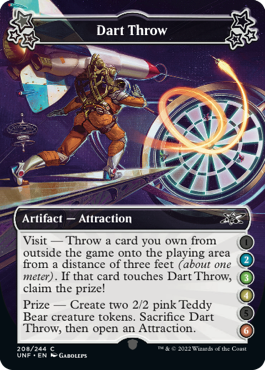
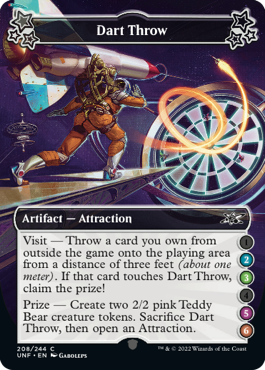
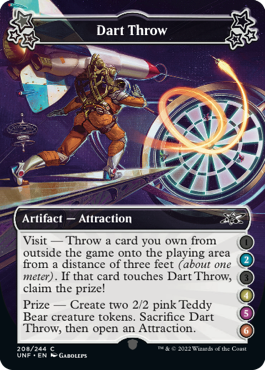
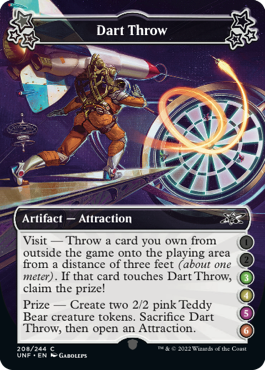
Dart Throw (acorn)
Artifact — Attraction
Visit — Throw a card you own from outside the game onto the playing area from a distance of three feet (about one meter). If that card touches Dart Throw, claim the prize!
Prize — Create two 2/2 pink Teddy Bear creature tokens. Sacrifice Dart Throw, then open an Attraction.
Visiting Attractions like Dart Throw allows you to play the minigame and try to claim the prize. The prize is a reward listed at the bottom of the card. Prizes are part of their respective visit abilities, even though they're separated to make them easier to read. Prizes have you sacrifice the Attraction, placing it in your junkyard; however, you do get to open a new Attraction to replace it. If you fail the challenge and don't claim the prize, the Attraction remains on the battlefield, waiting for you to visit and try again.
Hats!
Everyone here at the Astrotorium appreciates a stylish hat, no cap. Oh no, wait. Cap! Also, beret, bowler, sombrero . . . you name it, we love it. Several acorn cards in Unfinity care about hats.
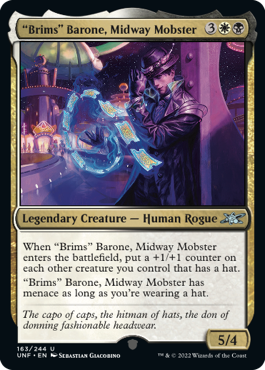
"Brims" Barone, Midway Mobster (acorn)
{3}{W}{B}
Legendary Creature — Human Rogue
5/4
When "Brims" Barone, Midway Mobster enters the battlefield, put a +1/+1 counter on each other creature you control that has a hat.
"Brims" Barone, Midway Mobster has menace as long as you're wearing a hat.
- A hat is a garment worn on the head that's not part of another garment. Hoodies, for example, are not hats. Items that cover only the face and not the top of the head, such as a face mask, are also not hats. Hats are purposely decorative. Simply balancing a thing on your head doesn't make that thing a hat.
- Key in this set—space helmets are not hats, although some creatures with space helmets also are wearing hats underneath those helmets.
- Wigs and headbands count as hats. There are wig and headband stickers.
- The above information pertaining to hats for creatures also pertains to actual hats for players.
- A creature "has a hat" if the creature depicted in the art is in possession of a hat. That creature doesn't need to be wearing the hat. A background character such as a scale bird having a hat won't count.
- You "have a hat" if you have a hat with you, not if you own one somewhere. You don't have to be wearing the hat. But if you have a hat with you, why wouldn't you be wearing it? Does it not fit? Is it for a sports team that's bad? Did you just get your hair done? We're just curious. You don't have to explain.
- You're "wearing a hat" if you're wearing a hat.
- No player can remove another player's hat. That's unsporting conduct.
Wordplay!
Several Unfinity cards have abilities based on wordplay. These care about specific words or letters that appear in card names, in rules text, and elsewhere. For the most part, these effects are limited to Un- games. However, abilities that look solely at stickers (which appear only in English) may appear on eternal cards.
Alpha Strike
- Alpha strike is a static keyword ability. A creature with alpha strike has first strike as long as it's blocking or being blocked by a creature whose name comes after it alphabetically.
- A creature with alpha strike that is blocking or being blocked by multiple creatures has first strike as long as it has alphabetic primacy over at least one of those creatures.
- Numbers come before letters alphabetically, in ascending order by value. Ignore all spaces and punctuation, including blank lines.
What's in a Name?
- In Un- games, to determine the name of a nontoken permanent or a card that's not on the battlefield, use the actual card you're playing with, not the card's Oracle text or its name in other languages.
- In other games, a nontoken card's name is based on its Oracle text, regardless of what version of a card it is.
- In all games, unless a token is copying something else or given a specific name by the effect that created it (such as "Voja," "Voja, Friend to Elves" "Voja, Betrayer of Mortals," or "Voja, Wolflord of Machines"), the token's name is its subtypes followed by the word "token." For example, an effect that creates a Clown Robot artifact creature token creates a token named "Clown Robot Token."
- In Un- games, use the source that created the token to determine which language the token's name uses. It doesn't matter what you use to represent the token.
- In other games, the token's name will be based on the Oracle text of the card whose effect created the token.
Counting Words
- A word is any connected string of letters, numbers, and punctuation. Words are always separated by spaces from other words. The only exceptions are blank lines in card names (such as in "Wizards of the _____"). These lines represent suggested places to put name stickers, but they are not words.
- A word can be a single letter. It can also be a number. Just look for where spaces are located. For example, "Phone a Friend," "Borrowing 100,000 Arrows," "Queen Kayla bin-Kroog," and "Wizards of the _____" all have three words in their names.
Letter Perfect
- Some abilities instruct you to choose a letter. You may choose any letter from any language, including Spanish, Phyrexian, and that secret language that only you and your twin sister know. The ability will have varying levels of effectiveness depending on your choice and your collection.
- Some abilities refer to the number of unique vowels in a name or a sticker. An upper-case instance and a lower-case instance of the same vowel are counted as a single unique vowel. For example, if a creature's name is Serra Angel, that name contains two unique vowels: A and E.
Savor the Flavor
- Some cards care about how many lines of flavor text a card has. It doesn't matter how many words a line of flavor text has. As long as there's at least a single letter or number there, it counts as a line.
- Most tokens don't have flavor text. A few official tokens do have flavor text, such as the Boo token from Adventures in the Forgotten Realms. In Un- games, effects that care about flavor text will see flavor text on a token only if it's being represented by an official printed token that has flavor text, or if that token is a copy of something else that has flavor text.
People!
Myra is not only building the galaxy's preeminent entertainment, retail, dining, and performance art complex—she's building a community! And a community is nothing without its people. Some acorn cards in this set require assistance from a person outside the game.
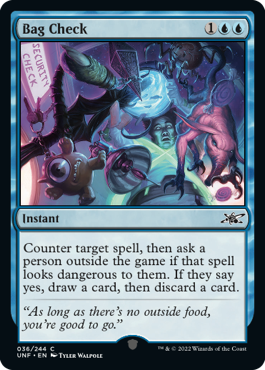
Bag Check (acorn)
{1}{U}{U}
Instant
Counter target spell, then ask a person outside the game if that spell looks dangerous to them. If they say yes, draw a card, then discard a card.
- You can choose any player not currently in your game. This includes people who used to be in your game but left it.
- It doesn't have to be someone who plays Magic. It's often more fun if they don't.
- If there's no one around to make a decision, you can call or text someone if you need to. If there's a physical action required, such as high-fiving, you'll need someone there.
- If the outside person you've chosen just refuses to play along, try to choose another person. There's an Un- rule that says if you just can't get an outside person to make a choice, an opponent gets to choose, but please make every effort to avoid invoking that rule.
Dice!
I see you've visited the cafeteria here at the Astrotorium, so you're clearly not afraid to take a chance. Perfect! Un- sets are no strangers to dice, and Unfinity keeps the good times rolling with a selection of eternal and acorn cards that instruct you to roll six-sided dice.
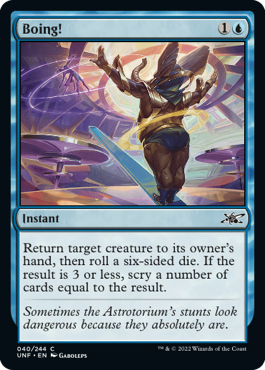
Boing! (eternal)
{1}{U}
Instant
Return target creature to its owner's hand, then roll a six-sided die. If the result is 3 or less, scry a number of cards equal to the result.
- Each die is identified by the number of faces it has. A six-sided die is a die with six equally likely outcomes: 1, 2, 3, 4, 5, and 6. The roll must be fair. Although physical dice are recommended, digital substitutes are allowed except in cases where the physical die is required for the effect.
- If an ability triggers "whenever you roll a die," it will trigger whenever you roll any die, including the planar die. This is a change from previous Un- rules. Some abilities use the result to determine part of the effect. If you get a non-numerical result (currently just the planar die, but the future is long), that part of the effect won't do anything.
- Something in the game must tell you to roll a die. If you roll a die for any other reason (to simulate a coin flip, to choose pizza toppings, to create alternate timelines), that roll doesn't count.
- Some effects may modify the result of a die roll. This may be part of the instruction to roll a die, or it may come from other cards. Anything that references the "result" of a die roll is looking for the result after these modifications.
- If a die is rerolled, the original roll essentially never happened: it doesn't cause any abilities to trigger, and no effect that cares about die rolls will consider it.
- Results can be numbers not ordinarily possible on a six-sided die. Spells like Scooch can change the result to 0 or 7, for example.
A Note About Physical Challenges
Several acorn cards in this set ask the player to perform feats of dexterity or other physical actions. If, for any reason, you're unable to perform such an action, we encourage you to discuss equivalent tasks with your playgroup. If you can find a suitable substitute that upholds the spirit of the card, you should use it. You are also allowed to designate another person to act in your place for that action.
UNFINITY MAIN SET CARD-SPECIFIC NOTES:
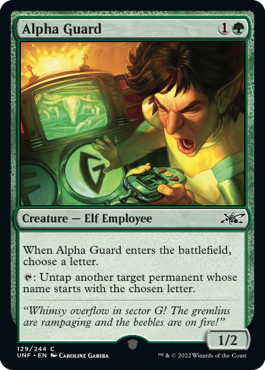
Alpha Guard (acorn)
{1}{G}
Creature — Elf Employee
1/2
When Alpha Guard enters the battlefield, choose a letter.
{T}: Untap another target permanent whose name starts with the chosen letter.
- When determining what a name starts with, ignore all spaces and punctuation, including blank lines.
- Because Alpha Guard appears only in Un- games, you may run into situations where cards that would normally have the same name—for example, an English-language Forest and a German-language Forest—now have different names. In Un- games, the name printed on the card is that card's name (unless modified by stickers or other effects). Thus, if you were to choose F for Alpha Guard, you would be able to untap a Forest, but you would not be able to untap a Wald, Forest's German equivalent.
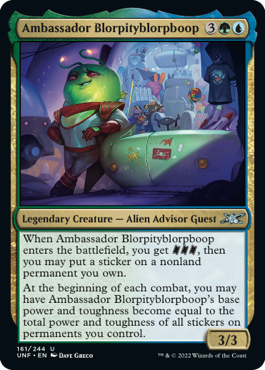
Ambassador Blorpityblorpboop (eternal)
{3}{G}{U}
Legendary Creature — Alien Advisor Guest
3/3
When Ambassador Blorpityblorpboop enters the battlefield, you get {TK}{TK}{TK}, then you may put a sticker on a nonland permanent you own.
At the beginning of each combat, you may have Ambassador Blorpityblorpboop's base power become equal to the total power of all stickers on permanents you control and its base toughness become equal to those stickers' total toughness.
- Ambassador Blorpityblorpboop has received a minor update to clarify its function. Specifically, its ability causes its base power to match the total power of stickers you control, and its base toughness to match the total toughness of stickers you control. The updated wording appears above.
- It doesn't matter if the stickers are on creatures. Any power and toughness stickers on noncreature permanents you control will also count.
- Count only the powers and toughnesses of the stickers on permanents you control, not the actual powers and toughnesses of those permanents. For example, if a creature you control has a 4/4 sticker on it, but it also has three +1/+1 counters on it, it's a 7/7 creature, but Ambassador Blorpityblorpboop's base power and toughness would become 4/4.
- Ambassador Blorpityblorpboop counts all power and toughness stickers on all permanents you control, even if those power and toughness stickers don't currently have any effect (possibly because you placed another power and toughness sticker on the same creature).
- If Ambassador Blorpityblorpboop has a power and toughness sticker on it, that sticker is included when calculating for the last ability.
- Although Ambassador Blorpityblorpboop's last ability considers the power and toughness stickers of permanents you control, the card itself is not considered to be stickered unless there's actually a sticker on it.
- The base power and toughness change doesn't end at end of turn; it lasts indefinitely, until Ambassador Blorpityblorpboop either leaves the battlefield or its base power and toughness changes again from another effect (for example, a power and toughness sticker being placed on it or its ability triggering again).
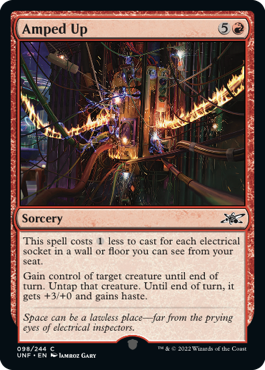
Amped Up (acorn)
{5}{R}
Sorcery
This spell costs {1} less to cast for each electrical socket in a wall or floor you can see from your seat.
Gain control of target creature until end of turn. Untap that creature. Until end of turn, it gets +3/+0 and gains haste.
- Any electrical socket that you can plug a device into to get electricity counts. Note that the socket has to be in a wall or floor.
- Also note that you have to remain in your seat while looking around the room. No, you can't pick up your seat and walk around to get a better discount.
- Most outlets have two electrical sockets. A surge protector, extension cord, or similar device doesn't increase the number of electrical sockets in a wall or floor that an outlet has.
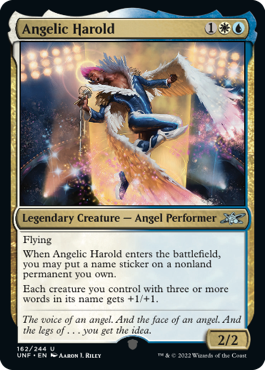
Angelic Harold (acorn)
{1}{W}{U}
Legendary Creature — Angel Performer
2/2
Flying
When Angelic Harold enters the battlefield, you may put a name sticker on a nonland permanent you own.
Each creature you control with three or more words in its name gets +1/+1.
- A creature token that was created with two or more creature types will (usually) qualify for the bonus bestowed by Harold's last ability because its name is those types plus the word "Token." It doesn't matter what you're using to represent the token.
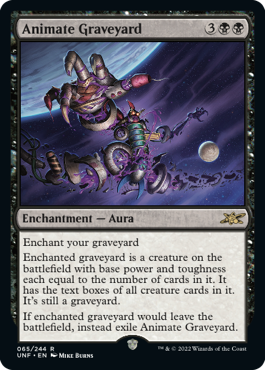
Animate Graveyard (acorn)
{3}{B}{B}
Enchantment — Aura
Enchant your graveyard
Enchanted graveyard is a creature on the battlefield with base power and toughness each equal to the number of cards in it. It has the text boxes of all creature cards in it. It's still a graveyard.
If enchanted graveyard would leave the battlefield, instead exile Animate Graveyard.
- Your graveyard is still a graveyard. I know the card says that, but it really bears repeating. Cards that would go to your graveyard still will, even while your graveyard is a creature on the battlefield.
- While you'll use the cards in your graveyard to determine the stats and abilities of your graveyard-that's-a-creature, those cards aren't themselves on the battlefield. For example, if you mill a card while your graveyard is animated, the milled card doesn't enter the battlefield. This isn't quite as wild as Yet Another Aether Vortex.
- Once enchanted, your graveyard behaves like any other creature. It can attack or block. You can enchant it with other Auras, equip it, use it to crew Vehicles, and so on. It won't naturally have any creature types—the text box doesn't include the type line.
- Your graveyard-creature will have all the text boxes of all creature cards in it. This means it will have all rules text, flavor text, and watermarks of those creature cards. If a creature card is put into your graveyard, the graveyard-creature will gain its text box. If a creature card leaves your graveyard, that text box will be lost. Phoebe can steal any of these text boxes, but she must do so one at a time.
- If a creature card in your graveyard is a double-faced card, your graveyard-creature only gains the text box on its front face. Your graveyard-creature is not a double-faced card and can't transform, no matter how many double-faced cards are in it. Similarly, if a creature card in your graveyard has an Adventure, your graveyard-creature only gains the text box of the creature card, not the Adventure card.
- If there's a creature card in your graveyard with an ability that defines its power and toughness, such as Tarmogoyf (Maro: He means Maro), the ability of Animate Graveyard will apply after that ability. The base power and toughness of your graveyard-creature will still be equal to the number of cards in your graveyard.
- If the enchanted graveyard would leave the battlefield for any reason, instead Animate Graveyard is exiled. This will cause the graveyard to give up its dreams of being a creature and return to being only a graveyard. The graveyard doesn't die. It just goes back to being a graveyard. No abilities that trigger whenever a creature dies will trigger.
- Similarly, if Animate Graveyard leaves the battlefield or becomes unattached from your graveyard, the animated graveyard will return to being just your graveyard.
- If another player gains control of your graveyard, Animate Graveyard will be put its owner's graveyard. This immediately causes your graveyard to stop being a creature and return to just being your graveyard.
- You can't animate your junkyard or your scrapyard. Though they may aspire to be graveyards, they are not.
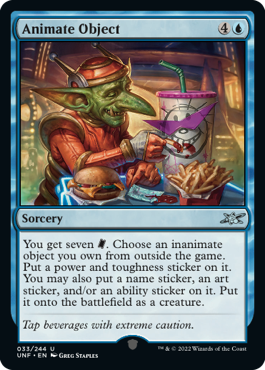
Animate Object (acorn)
{4}{U}
Sorcery
You get seven {TK}. Choose an inanimate object you own from outside the game. Put a power and toughness sticker on it. You may also put a name sticker, an art sticker, and/or an ability sticker on it. Put it onto the battlefield as a creature token.
- Animate Object has received a minor update to its wording to add a word that we probably should have had there from the outset. Oopsie. The resulting creature is a token. If it leaves the battlefield, the game object ceases to exist. The actual object presumably continues to exist (Wizards of the Coast makes no claims, promises, or guarantees that ordinary household objects may not disappear into the fathomless void at any spacetime).
- For the purposes of this card, an inanimate object is one not currently being used in the game. It must be small enough to be practical. You must legally be allowed to possess it. We really do mean inanimate, as in "not alive." Why do I feel the need to be more specific? Not even formerly alive. Like a deck box or something.
- If you use a Magic card, ignore all its in-game qualities, including art. The creature doesn't have its printed name, any of its printed text, etc. It's the same as if you had used a five of spades.
- If you use a five of spades, or any other object with numbers or text, ignore those numbers and text. The creature initially has only the characteristics given to it by the stickers you put onto it.
- If you animate a hat, the resulting creature is not wearing a hat. Being a hat is not the same as wearing a hat or having a hat.

Art Appreciation (acorn)
{1}{R}
Sorcery
Put an art sticker on a nonland permanent you own. Then ask a person outside the game to rate its new art on a scale from 1 to 5, where 5 is the best. When they rate the art, up to that many target creatures can't block this turn.
- The outside person is rating the new art, considering the way the sticker synthesizes with the original art. Does it produce a harmonious aesthetic? Does it make a worthwhile commentary on society? Does it present a fresh viewpoint in a landscape rife with imitation and vapid regurgitation? Or, if they must . . . is the sound effect funny? Sigh.
- Art Appreciation doesn't target the nonland permanent. You choose which one is getting the sticker as the spell resolves.
- If you don't put an art sticker on the permanent because you don't have any available, the outside person should rate the card's existing art. Perhaps they should dock you a point or two for your lack of originality. Who are we to say?
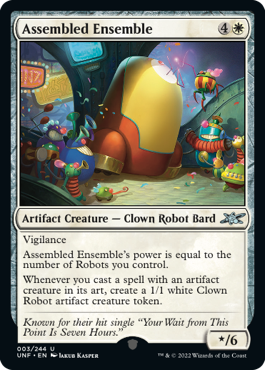
Assembled Ensemble (acorn)
{4}{W}
Artifact Creature — Clown Robot Bard
*/6
Vigilance
Assembled Ensemble's power is equal to the number of Robots you control.
Whenever you cast a spell with an artifact creature in its art, create a 1/1 white Clown Robot artifact creature token.
- Robot is a creature type. There may be creatures that appear to be robotic in nature that don't have the Robot creature type. They won't contribute to Assembled Ensemble's power.
- Assembled Ensemble will count itself as long as it's on the battlefield and remains a Robot, so its power will usually be at least 1.
- A spell that causes the last ability to trigger doesn't have to be an artifact creature spell. It only needs to have an artifact creature in its art. It also doesn't matter how many artifact creatures are in its art, as long as there is at least one.
- Artifact creatures that appear in the art of other cards qualify. For example, if Assembled Ensemble appeared in the art of another card, casting that spell would cause the Assembled Ensemble's last ability to trigger.
- Creatures that are clearly artificial in nature also qualify, even if they aren't their own card. The artifact must be clearly animated in the art in question. For example, Dancing Scimitar is definitely an artifact creature, but that doesn't mean every sword is an artifact creature. Most aren't.
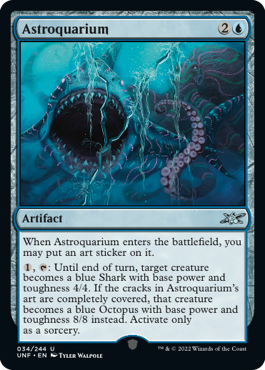
Astroquarium (acorn)
{2}{U}
Artifact
When Astroquarium enters the battlefield, you may put an art sticker on it.
{1}, {T}: Until end of turn, target creature becomes a blue Shark with base power and toughness 4/4. If the cracks in Astroquarium's art are completely covered, that creature becomes a blue Octopus with base power and toughness 8/8 instead. Activate only as a sorcery.
- You can use any kind of sticker to cover the cracks in Astroquarium's art, not just art stickers. Name, ability, and power and toughness stickers will function no matter where they are physically positioned.
- After the activated ability resolves, the creature will not retain any of its previous colors or creature types—it will be only a blue Shark or a blue Octopus. Its other card types (such as artifact) and supertypes (such as legendary), if any, will remain unchanged.
- Effects that modify the creature's power or toughness (such as the effect of Giant Growth) will apply no matter when they started to take effect. The same is true for counters that change its power or toughness (such as +1/+1 counters).
- Once the activated ability resolves, it doesn't matter what happens to Astroquarium or its . . . um . . . cracks. If the creature becomes a 4/4 Shark and then the cracks become completely covered later in the turn, the creature won't spontaneously become an 8/8 Octopus.
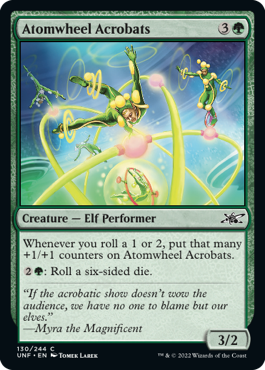
Atomwheel Acrobats (eternal)
{3}{G}
Creature — Elf Performer
3/2
Whenever you roll a 1 or 2, put that many +1/+1 counters on Atomwheel Acrobats.
{2}{G}: Roll a six-sided die.
- The die roll caused by the activated ability has no inherent effect: you just roll a six-sided die, but any ability that triggers whenever you roll a die will trigger. Abilities that trigger whenever you roll a specific result, such as Atomwheel Acrobats' first ability, may also trigger.
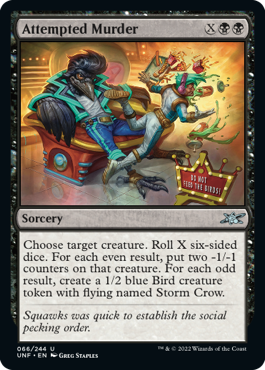
Attempted Murder (eternal)
{X}{B}{B}
Sorcery
Choose target creature. Roll X six-sided dice. For each even result, put two -1/-1 counters on that creature. For each odd result, create a 1/2 blue Bird creature token with flying named Storm Crow.
- If X is a very large number, you may be required to roll more dice than you physically can in a reasonable time frame. In such cases, we encourage you to use digital resources for simulating die rolls or generating random numbers.
- In an Un- game, if X is actually infinite (Urza's Fun House is a pathway to many game states some consider to be unnatural), you can assume that every natural result on a six-sided die is rolled infinite times, leading to infinite -1/-1 counters and infinite Storm Crows. If abilities trigger from you rolling those results, they will each trigger infinite times. Have fun!
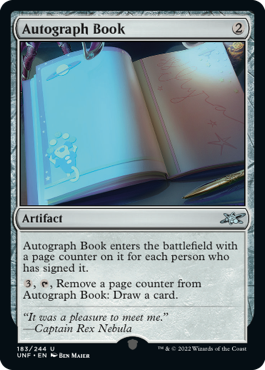
Autograph Book (acorn)
{2}
Artifact
Autograph Book enters the battlefield with a page counter on it for each person who has signed it.
{3}, {T}, Remove a page counter from Autograph Book: Draw a card.
- People can sign anywhere on the card, but each autograph must be distinct so they can be counted.
- People can sign Autograph Book more than once, but it's one page counter per person, not per autograph, so they're just taking up space where other people could be signing.
- You can (and should) sign your own Autograph Book to get things rolling.
- People can sign Autograph Book during the game, but signing it once it's on the battlefield won't add more page counters.
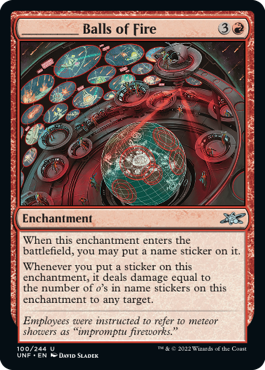
________ Balls of Fire (eternal)
{3}{R}
Enchantment
When this enchantment enters the battlefield, you may put a name sticker on it.
Whenever you put a sticker on this enchantment, it deals damage equal to the number of o's in name stickers on this enchantment to any target.
- The last ability will trigger whenever you put any kind of sticker on this enchantment, not just name stickers, although only o's in name stickers will count towards the amount of damage dealt. Notably, o's in ability and art stickers won't count.
- Count the number of o's in name stickers on this enchantment as the last ability resolves to determine how much damage is dealt. If this enchantment is no longer on the battlefield at that time, use the number of o's its name stickers had when it was last on the battlefield.
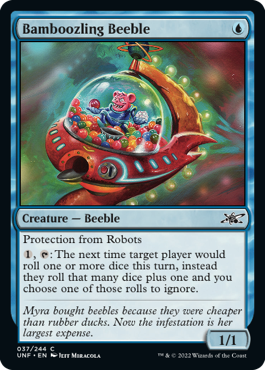
Bamboozling Beeble (eternal)
{U}
Creature — Beeble
1/1
Protection from Robots
{1}, {T}: The next time target player would roll one or more dice this turn, instead they roll that many dice plus one and you choose one of those rolls to ignore.
- You choose which roll to ignore after seeing all the results. The ignored roll is considered never to have happened. It can't cause any abilities to trigger, and no effect will see its result.
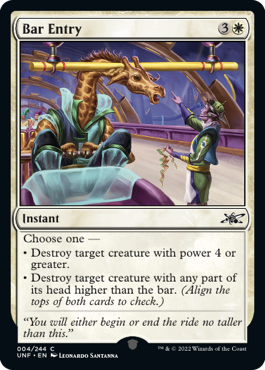
Bar Entry (acorn)
{3}{W}
Instant
Choose one —
• Destroy target creature with power 4 or greater.
• Destroy target creature with any part of its head higher than the bar. (Align the tops of both cards to check.)
- To check if a creature is a legal target for the second mode, put the cards side-by-side, right side up, such that if you had a ruler, the top of both cards would be lined up against it. If any part of that creature's head is higher than the bottom of the bar (that is, if it would hit the bar), the creature is a legal target.
- If there are multiple creatures in the art, only compare the one that represents the actual creature on the card. For example, Tarmogoyf (MMA) has the tarmogoyf itself and an elk in the art, and you need only consider the tarmogoyf.
- If there are multiple creatures in the art that each match what the card is representing, then you can target that creature if any of them has any part of its head higher than the bar. For example, Llanowar Elves (M19) has three figures in its art, all of whom are Llanowar elves. The creature can be destroyed if any of those elves has a part of their head higher than the bar.
- Only a creature's head counts. Other body parts (such as tails) being above the bar doesn't make a creature a legal target. If a creature is wearing a hat on its head, treat the hat as part of its head.
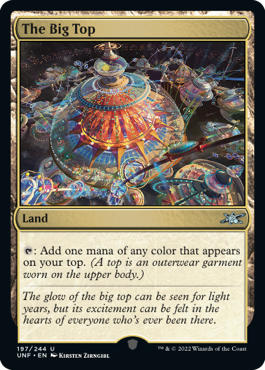
The Big Top (acorn)
Land
{T}: Add one mana of any color that appears on your top. (A top is an outerwear garment worn on the upper body.)
- If you're wearing layers, you can count any garment that other players can see.
- There's wide latitude for what counts as the five colors of mana. Any shade of red qualifies as red, and so on. Some dark shades of purple can likely pass for black mana, and some light shades of yellow can pass for white. We do those on cards sometimes.
- You can add any color of mana in Un- games, though, so if you really want turquoise mana, go for it.
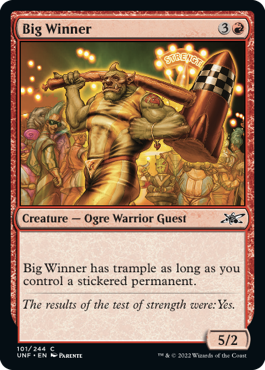
Big Winner (eternal)
{3}{R}
Creature — Ogre Warrior Guest
5/2
Big Winner has trample as long as you control a stickered permanent.
- The stickered permanent could be Big Winner itself or another permanent you control.
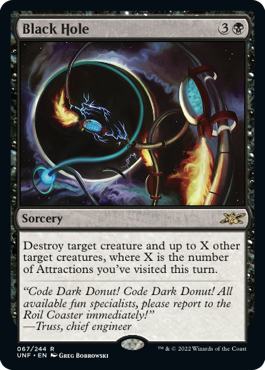
Black Hole (eternal)
{3}{B}
Sorcery
Destroy target creature and up to X other target creatures, where X is the number of Attractions you've visited this turn.
- Count the number of Attractions you've visited this turn as you cast Black Hole to determine how many targets you may choose. Those Attractions don't have to still be on the battlefield as you cast Black Hole.
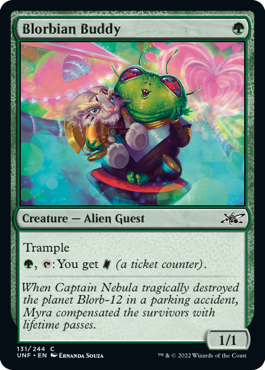
Blorbian Buddy (eternal)
{G}
Creature — Alien Guest
1/1
Trample
{G}, {T}: You get {TK} (a ticket counter).
- The last ability gives you a ticket counter, but it doesn't enable you to put a sticker on anything. That ticket can be spent if another effect later allows you to put a sticker on something.
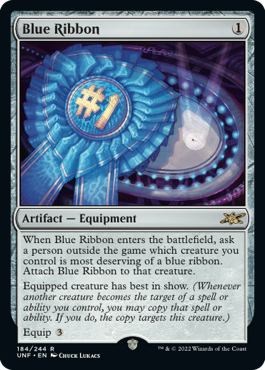
Blue Ribbon (acorn)
{1}
Artifact — Equipment
When Blue Ribbon enters the battlefield, ask a person outside the game which creature you control is most deserving of a blue ribbon. Attach Blue Ribbon to that creature.
Equipped creature has best in show. (Whenever another creature becomes the target of a spell or ability you control, you may copy that spell or ability. If you do, the copy targets this creature.)
Equip {3}
- If you control no creatures when Blue Ribbon's enters-the-battlefield ability resolves, the outside person won't be able to choose the most deserving one. Blue Ribbon will just stay unattached.
- If you control more than one creature with best in show, one of them becoming a target of a spell or ability you control (or a creature you control without best in show becoming such a target) will start a chain reaction. Say you control two creatures with best in show. The first becomes the target of a spell you control. That causes the best in show ability of the second creature to trigger. If you copy the spell, the second creature becomes the target of the copy, causing the best in show ability of the first creature to trigger. If you copy the spell, the first creature becomes the target of the copy causing the best in show ability of the second creature to trigger. And so on. Copying the spell or ability is optional, so the player may stop the award ceremony at their discretion.
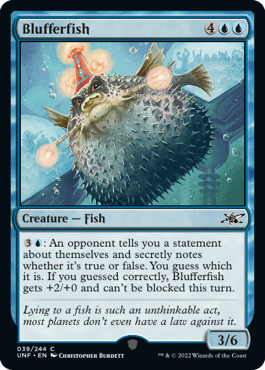
Blufferfish (acorn)
{4}{U}{U}
Creature — Fish
3/6
{3}{U}: An opponent tells you a statement about themselves and secretly notes whether it's true or false. You guess which it is. If you guessed correctly, Blufferfish gets +2/+0 and can't be blocked this turn.
- The statement the opponent makes doesn't need to be very personal, but it does need to be about themself. Something like "I had eggs for breakfast" is fine.
- The opponent is the authority on whether the statement they make is true or false. That said, lying isn't allowed, and they should be sporting about it.

Boing! (eternal)
{1}{U}
Instant
Return target creature to its owner's hand, then roll a six-sided die. If the result is 3 or less, scry a number of cards equal to the result.
- If the result is 0 or less because of modifications to the result, you don't scry at all.

"Brims" Barone, Midway Mobster (acorn)
{3}{W}{B}
Legendary Creature — Human Rogue
5/4
When "Brims" Barone, Midway Mobster enters the battlefield, put a +1/+1 counter on each other creature you control that has a hat.
"Brims" Barone, Midway Mobster has menace as long as you're wearing a hat.
- Whether or not Brims has menace matters only as blockers are declared. After that point, a gust of wind removing your hat or blowing a new hat onto your head won't change which blockers have already legally been declared.
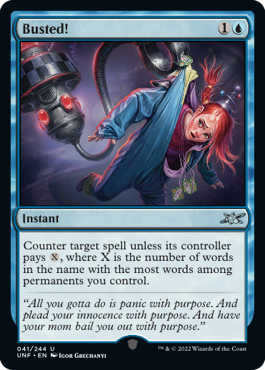
Busted! (acorn)
{1}{U}
Instant
Counter target spell unless its controller pays {X}, where X is the number of words in the name with the most words among permanents you control.
- Look at permanents you control as Busted! resolves to determine the value of X.
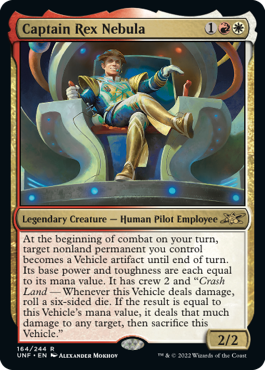
Captain Rex Nebula (eternal)
{1}{R}{W}
Legendary Creature — Human Pilot Employee
2/2
At the beginning of combat on your turn, choose target nonland permanent you control. Until end of turn, it becomes a Vehicle artifact with base power and toughness each equal to its mana value, and it gains crew 2 and "Crash Land — Whenever this Vehicle deals damage, roll a six-sided die. If the result is equal to this Vehicle's mana value, sacrifice this Vehicle, then it deals that much damage to any target."
- Captain Rex Nebula has received an update to its wording to clarify that the abilities it grants to the target nonland permanent last until end of turn. In addition, the Crash Land ability now causes the Vehicle to be sacrificed before it deals damage. The updated text appears above.
- The target of Rex Nebula's ability will become a Vehicle artifact until end of turn. It will lose all of its previous card types and subtypes, but it will keep any supertypes (such as legendary) it previously had. If the target of Rex Nebula's ability is a creature, it will lose all creature types (such as Zombie) it had until end of turn, and becoming crewed will not cause it to regain those subtypes.
- The Vehicle will retain any abilities it previously had, as well as gaining crew 2 and the ability to crash into stuff.
- The Crash Land ability will trigger whenever the Vehicle deals any damage, not only combat damage.
- The Crash Land ability will trigger once for each instance of damage, no matter how many players or permanents the Vehicle deals damage to. For example, if the Vehicle is blocked by two creatures and it deals damage to each of them at the same time, the Crash Land ability will trigger only once.
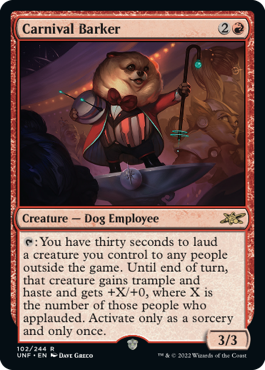
Carnival Barker (acorn)
{2}{R}
Creature — Dog Employee
3/3
{T}: You have thirty seconds to laud a creature you control to any people outside the game. Until end of turn, that creature gains trample and haste and gets +X/+0, where X is the number of those people who applauded. Activate only as a sorcery and only once.
- The thirty seconds starts as the ability starts resolving and you start lauding. Someone should be ready to time you before you activate the ability.
- Lauding means singing the praises of the creature in question. Complimenting it. Telling everyone of its awesomeness, that kind of thing. Don't stray off-topic. And resist the urge to say "Please clap"—86% of audiences don't respond well to desperation.
- "Only once" means once for that particular creature. If a different copy of Carnival Barker enters the battlefield, or if Carnival Barker leaves the battlefield and returns, it's a new object and its ability can be activated. Please be considerate of others around you before designing a deck around blinking and activating Carnival Barker three times each turn.
- If another player gains control of a Carnival Barker whose ability has been activated, they won't be able to activate it. That Barker's all barked out.
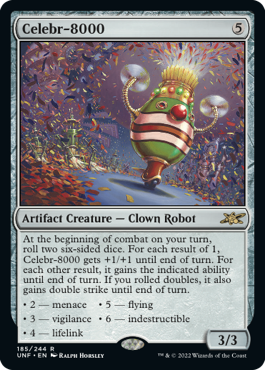
Celebr-8000 (eternal)
{5}
Artifact Creature — Clown Robot
3/3
At the beginning of combat on your turn, roll two six-sided dice. For each result of 1, Celebr-8000 gets +1/+1 until end of turn. For each other result, it gains the indicated ability until end of turn. If you rolled doubles, it also gains double strike until end of turn.
• 2 — menace
• 3 — vigilance
• 4 — lifelink
• 5 — flying
• 6 — indestructible
- If you roll a result higher than 6 because of modifications to the results, Celebr-8000 won't gain any ability from that roll. If you roll doubles of such a number, it will still gain double strike until end of turn.
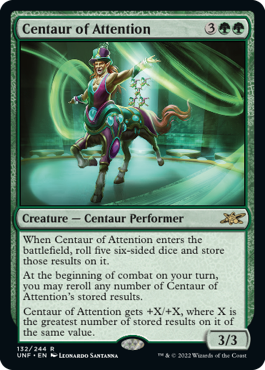
Centaur of Attention (eternal)
{3}{G}{G}
Creature — Centaur Performer
3/3
When Centaur of Attention enters the battlefield, roll five six-sided dice and store those results on it.
At the beginning of combat on your turn, you may reroll any number of Centaur of Attention's stored results.
Centaur of Attention gets +X/+X, where X is the greatest number of stored results on it of the same value.
- To store a result means to note the result, ya see. You can do it by keeping a die with that result on Centaur of Attention, or just by writing down the result. To reroll a noted result, roll a die with the same number of sides and replace the noted result with the new result.
- To get the largest bonus from the last ability, you want all five dice to have the same result. It doesn't matter what result that is. The value of X is the largest number of dice that match, not what number they're showing. For example, if your five results are 1, 1, 3, 3, and 4, Centaur of Attention would get +2/+2.
- You may reroll any results stored on Centaur of Attention, even those you chose not to reroll on previous turns.
- If Centaur of Attention's enters-the-battlefield ability is copied or triggers multiple times somehow, it's possible to store more than five results on it. This is awesome. The last ability will consider all stored results and look for any that match each other.
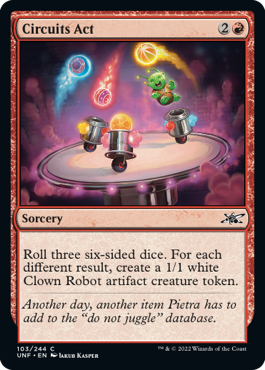
Circuits Act (eternal)
{2}{R}
Sorcery
Roll three six-sided dice. For each different result, create a 1/1 white Clown Robot artifact creature token.
- For example, if you rolled 1, 4, and 4, you'd create two Clown Robots. If you rolled triples, you'd create one Clown Robot.
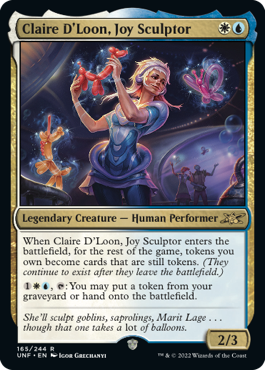
Claire D'Loon, Joy Sculptor (acorn)
{W}{U}
Legendary Creature — Human Performer
2/3
When Claire D'Loon, Joy Sculptor enters the battlefield, for the rest of the game, tokens you own become cards that are still tokens. (They continue to exist after they leave the battlefield.)
{1}{W}{U}, {T}: You may put a token from your graveyard or hand onto the battlefield.
- After Claire D'Loon's enters-the-battlefield ability resolves, any token you own that leaves the battlefield will remain in existence in whatever zone it goes to. This means you must continue to represent that token with a physical object wherever it is. This applies to all tokens on the battlefield when the ability resolved, as well as all tokens you create for the rest of the game.
- Thanks to Claire, tokens can end up in your hand. Thanks, Claire. Most tokens don't have a mana cost (though see below), so a token that ends up in your hand can't be cast unless you find a way to cast it without paying its mana cost.
- A token that's created as a copy of another object will remain a copy of that object after it leaves the battlefield. Assuming it copied something with a mana cost, the token will still have that mana cost, so it can be cast as normal from wherever it is if you have permission to do so. Note that this is different than a token that becomes a copy of another object and then leaves the battlefield. In that case, the copy effect wears off as the token leaves the battlefield.
- If a token under Claire's influence ends up in your hand or library, the token needs to be indistinguishable from the other cards in that zone. If you're using printed tokens, great! Make sure you're matching the sleeves of the other cards in that zone, if any. If the token is represented by another object, such as a body part, a phone, a cat, some food, or a toy, use a Magic card (preferably a token) as a stand-in.
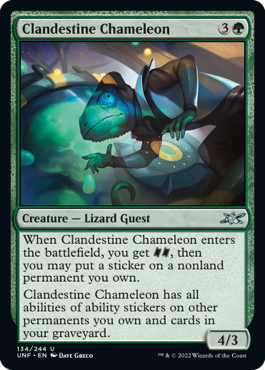
Clandestine Chameleon (eternal)
{3}{G}
Creature — Lizard Guest
4/3
When Clandestine Chameleon enters the battlefield, you get {TK}{TK}, then you may put a sticker on a nonland permanent you own.
Clandestine Chameleon has all abilities of ability stickers on other permanents you own and cards in your graveyard.
- Although Clandestine Chameleon has the abilities of ability stickers on other permanents you own and cards in your graveyard, it is not stickered unless there's actually a sticker on it.
- As ability stickers are added to other permanents you own or cards in your graveyard, Clandestine Chameleon will gain the corresponding abilities. Similarly, Clandestine Chameleon will lose abilities as those stickers are removed or those permanents and/or cards go to zones other than the battlefield or graveyard.
- It doesn't matter if the permanent or card with the ability sticker has lost the ability due to another effect. As long as it still has the sticker on it, Clandestine Chameleon will have the ability of that sticker anyway.
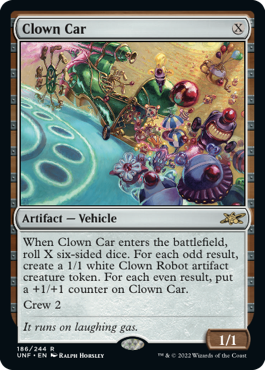
Clown Car (eternal)
{X}
Artifact — Vehicle
1/1
When Clown Car enters the battlefield, roll X six-sided dice. For each odd result, create a 1/1 white Clown Robot artifact creature token. For each even result, put a +1/+1 counter on Clown Car.
Crew 2
- If X is a very large number, you may be required to roll more dice than you physically can in a reasonable time frame. In such cases, we encourage you to use digital resources for simulating die rolls or generating random numbers.
- In an Un- game, if X is actually infinite (Urza's Fun House is a pathway to many game states some consider to be unnatural), you can assume that every natural result on a six-sided die is rolled infinite times, leading to infinite Clown Robot tokens and infinite +1/+1 counters on Clown Car. If abilities trigger from you rolling those results, they will each trigger infinite times. Have fun!
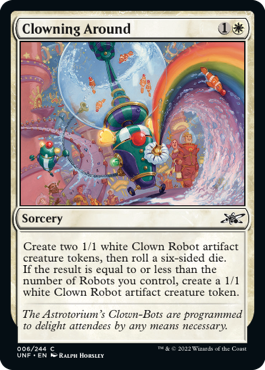
Clowning Around (eternal)
{1}{W}
Sorcery
Create two 1/1 white Clown Robot artifact creature tokens, then roll a six-sided die. If the result is equal to or less than the number of Robots you control, create a 1/1 white Clown Robot artifact creature token.
- Robot is a creature type. There may be creatures that appear to be robotic in nature that don't have the Robot creature type. They don't count.
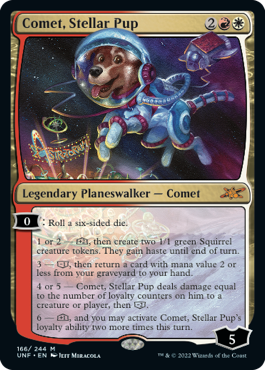
Comet, Stellar Pup (eternal)
{2}{R}{W}
Legendary Planeswalker — Comet
5
[0]: Roll a six-sided die.
1 or 2 — [+2], then create two 1/1 green Squirrel creature tokens. They gain haste until end of turn.
3 — [−1], then return a card with mana value 2 or less from your graveyard to your hand.
4 or 5 — Comet, Stellar Pup deals damage equal to the number of loyalty counters on him to a creature or player, then [−2].
6 — [+1], and you may activate Comet, Stellar Pup's loyalty ability two more times this turn.
- Each + loyalty symbol in Comet's abilities means to put the indicated number of loyalty counters on him. Each – loyalty symbol in Comet's abilities means to remove the indicated number of loyalty counters from him. The only difference is Comet uses these symbols in the effects of his abilities rather than the costs. Good boy, Comet.
- None of Comet's abilities require a target. All choices for cards, creatures, or players are made as the abilities resolve.
- If you roll a 3 but there aren't any cards with mana value 2 or less in your graveyard, you'll just remove one loyalty counter from Comet. Sorry, boy.
- If you roll a 4 or 5 while Comet has one loyalty counter on him, Comet will deal 1 damage to a creature or player and then that loyalty counter will be removed. Comet will then go live on a farm, where he'll be very happy but will miss you terribly.
- In some unusual cases, Comet may gain loyalty abilities other than the one he normally has. In those cases, the effect of rolling a 6 applies only to his normal ability.
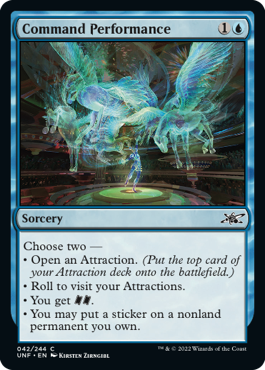
Command Performance (eternal)
{1}{U}
Sorcery
Choose two —
• Open an Attraction. (Put the top card of your Attraction deck onto the battlefield.)
• Roll to visit your Attractions.
• You get {TK}{TK}.
• You may put a sticker on a nonland permanent you own.
- No matter which two modes you choose, you always follow the instructions in the order they're written. You'll open an Attraction before rolling to visit them, if applicable, and similarly you'll get tickets before you may put a sticker on a nonland permanent you own.
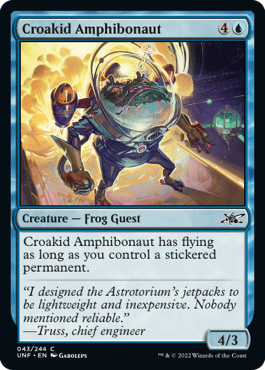
Croakid Amphibonaut (eternal)
{4}{U}
Creature — Frog Guest
4/3
Croakid Amphibonaut has flying as long as you control a stickered permanent.
- The stickered permanent could be Croakid Amphibonaut itself or another permanent you control.
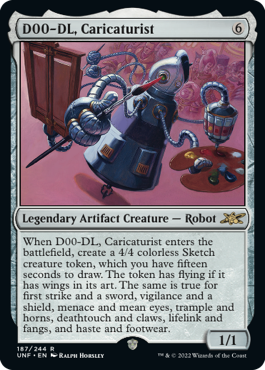
D00-DL, Caricaturist (acorn)
{6}
Legendary Artifact Creature — Robot
1/1
When D00-DL, Caricaturist enters the battlefield, create a 4/4 colorless Sketch creature token, which you have fifteen seconds to draw. The token has flying if it has wings in its art. The same is true for first strike and a sword, vigilance and a shield, menace and mean eyes, trample and horns, deathtouch and claws, lifelink and fangs, and haste and footwear.
- The fifteen seconds starts as the ability starts resolving and you start drawing. Someone should be ready to time you before you create the token.
- Whatever you use to represent the token doesn't necessarily have to be blank, but only what you draw within the fifteen seconds will count toward determining what its abilities are.
- I can't explain to you what mean eyes are exactly, but you'll know them when you see them. Oh, you'll know.
- If you go a little Picasso and all players can't agree on what some parts of your drawing are, you may consult an outside person for a final determination.
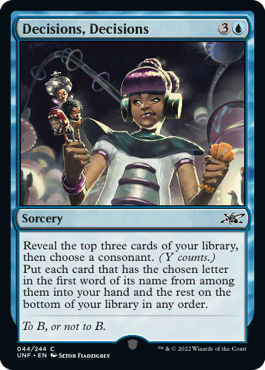
Decisions, Decisions (acorn)
{3}{U}
Sorcery
Reveal the top three cards of your library, then choose a consonant. (Y counts.) Put each card that has the chosen letter in the first word of its name from among them into your hand and the rest on the bottom of your library in any order.
- In case you're wondering, we've chosen to allow Y to be both a consonant and a vowel, depending on what the card cares about. Y? Because we're nice, and because Y has a great legal team.
- For each card you reveal, use that card's printed name (including any stickers) to determine the first word of its name. You may not use its Oracle text or its name in other languages.
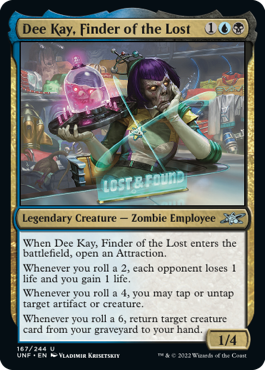
Dee Kay, Finder of the Lost (eternal)
{1}{U}{B}
Legendary Creature — Zombie Employee
1/4
When Dee Kay, Finder of the Lost enters the battlefield, open an Attraction.
Whenever you roll a 2, each opponent loses 1 life and you gain 1 life.
Whenever you roll a 4, you may tap or untap target artifact or creature.
Whenever you roll a 6, return target creature card from your graveyard to your hand.
- It doesn't matter why you rolled a die or how many sides that die has: if you roll a 2, a 4, or a 6, the corresponding ability will trigger.
- If you roll more than one die at a time, Dee Kay's abilities will trigger for each corresponding result. For example, if I roll 2, 2, and 4 on three six-sided dice, her second ability will trigger twice and her third ability will trigger once.
- If you roll a 2, a 4, or a 6 while rolling to visit your attractions, and one or more visit abilities also trigger from that roll, you choose the order in which those abilities and Dee Kay's ability go on the stack. You can have Dee Kay's ability resolve before those visit abilities, after them, or in between any of them.
- If the spell or ability that caused you to roll a die includes any effects due to the result, resolve those effects before putting Dee Kay's triggered abilities on the stack.
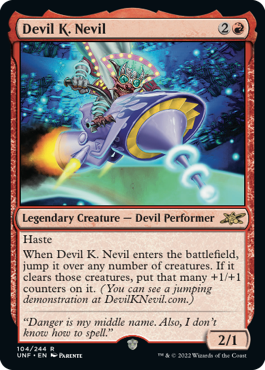
Devil K. Nevil (acorn)
{2}{R}
Legendary Creature — Devil Performer
2/1
Haste
When Devil K. Nevil enters the battlefield, jump it over any number of creatures. If it clears those creatures, put that many +1/+1 counters on it. (You can see a jumping demonstration at DevilKNevil.com.)
- In case the video doesn't clarify what jumping Devil K. Nevil over any number of creatures means, perhaps a lengthy text explanation will help. First, place Devil K. Nevil at the edge of the table such that about half the card vertically is sticking over the edge of the table. Then take any number of creatures on the battlefield and place them side-by-side on the table in front of Devil K. Nevil. Those creature cards should be horizontal to Devil K. Nevil's vertical from your perspective (unless they're not cards—see below). Ideally, the first creature card should be as close to Devil K. Nevil as it can be without touching it, but if you'd like to make the jump more difficult, we're not going to stop you. To execute the jump, flick Devil K. Nevil from underneath to cause it to fly up into the air and forward, majestically flying over the line of creatures. You can't just flick him horizontally. Devil craves hang time. If Devil comes to rest completely past the creatures without touching any of them, it has cleared those creatures and will earn those +1/+1 counters. If it touches any of the creatures during the jump, that's okay, as long as Devil comes to rest past the creatures, not touching any of them. All of Devil K. Nevil must be past the farthest creature for the jump to be successful. If Devil veers off to the side and doesn't get farther than the last creature, the jump is unsuccessful, even if it comes to rest not touching any of the creatures. An unsuccessful jump has no consequences other than shame. Shame and no +1/+1 counters.
- You may use any creatures on the battlefield except Devil K. Nevil itself for the jump, including your opponent's creatures. You are limited to the number of other creatures on the battlefield for the jump attempt.
- For anything involved in the jump that's a token, including Devil K. Nevil itself, use a Magic card-sized card as a substitute. Magic cards are the most Magic card-sized thing we can think of.
- For any card involved in the jump, the card sleeve it's in is considered part of the card.
- You may choose to jump over no creatures—and thus not attempt a jump—if you want. If there are no other creatures on the battlefield as the enters-the-battlefield ability resolves, Devil K. Nevil is a stunt devil without a stunt and there won't be a jump.
- The jump is considered attempted if your hand makes contact with Devil K. Nevil and it moves. You can't use anything other than your hand to flick Devil K. Nevil. If you're wearing gloves (which are basically card sleeves for hands), those count as part of your hand.
- If Devil K. Nevil is in a card sleeve, you may take it out of the sleeve if you'd like (assuming you own the card; ask permission if you don't). However, no other modifications are allowed to the card. You can't put anything into the sleeve to make it heavier, for example. You also can't bend, fold, or do anything else to the card that would make it unplayable in your deck.
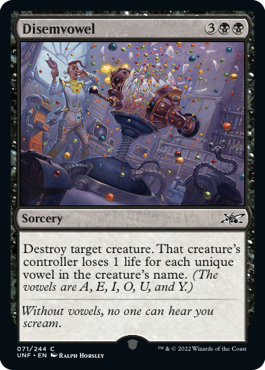
Disemvowel (acorn)
{3}{B}{B}
Sorcery
Destroy target creature. That creature's controller loses 1 life for each unique vowel in the creature's name. (The vowels are A, E, I, O, U, and Y.)
- If the creature's name doesn't have an A, E, I, O, U, or Y, its controller loses no life. Some languages are going to have an easier time with this than others.
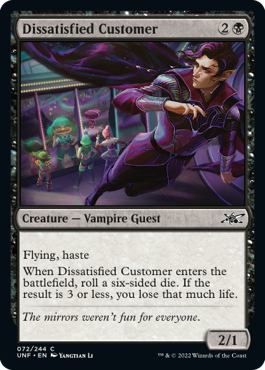
Dissatisfied Customer (eternal)
{2}{B}
Creature — Vampire Guest
2/1
Flying, haste
When Dissatisfied Customer enters the battlefield, roll a six-sided die. If the result is 3 or less, you lose that much life.
- If the result is 0 or less, because of modifications to the result, you won't lose any life. You also won't gain any life if the result is somehow negative.
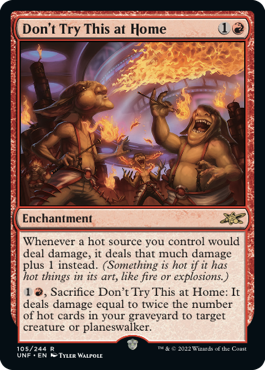
Don't Try This at Home (acorn)
{1}{R}
Enchantment
If a hot source you control would deal damage to a player or permanent, it deals that much damage plus 1 instead. (Something is hot if it has hot things in its art, like fire or explosions.)
{1}{R}, Sacrifice Don't Try This at Home: It deals damage equal to twice the number of hot cards in your graveyard to target creature or planeswalker.
- Don't Try This at Home has received a minor update to its rules text. The first ability is a replacement effect, not a triggered ability. The updated wording appears above.
- Hot refers to temperature, not physical attractiveness, internet trendiness, or any other non-temperature-related meanings. Hot items may include objects that are traditionally hot, such as flames or the sun, or they may also include objects that are shown to be hot, such as a magic sword melting the item it's touching.
- The hot thing doesn't need to be the focus of the illustration, nor does it need to be the actual card being depicted. It just needs to be somewhere in the art. It could even be a sticker.
- The additional 1 damage is dealt by the same source as the original source of damage. The damage isn't dealt by Don't Try This at Home unless it is the original source of damage. Note that while it is the source of damage for its activated ability, it won't be on the battlefield as that ability resolves and its first ability won't increase the damage it deals. (However, if it's still in the graveyard at that time, it will count itself, as it is very much a hot card.)
- If another effect modifies how much damage your hot source would deal, including preventing some of it, the player being dealt damage or the controller of the permanent being dealt damage chooses an order in which to apply those effects. If all of the damage is prevented, Don't Try This at Home's effect no longer applies.
- If damage dealt by a hot source you control is being divided or assigned among multiple permanents an opponent controls or among an opponent and one or more permanents they control, divide the original amount before adding 1. For example, if you attack with a 5/5 hot creature with trample and your opponent blocks with a 2/2 creature, you can assign 2 damage to the blocker and 3 damage to the defending player. These amounts are then modified to 3 and 4, respectively.
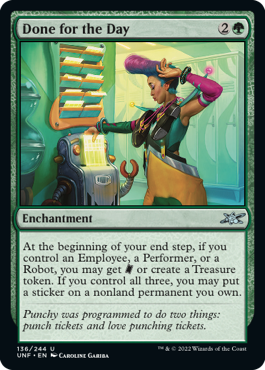
Done for the Day (eternal)
{2}{G}
Enchantment
At the beginning of your end step, if you control an Employee, a Performer, or a Robot, you may get {TK} or create a Treasure token. If you control all three, you may put a sticker on a nonland permanent you own.
- Done for the Day's ability will trigger only if you control at least one of the three as your end step begins. If you don't, the ability won't trigger at all. If you do, the ability will check again as it tries to resolve. If you control none of the three at that time, the ability won't resolve and you'll get nothing. If you still control at least one, you'll get the ticket or the Treasure (if you want). Then if you control all three, you'll also have the chance to place a sticker.
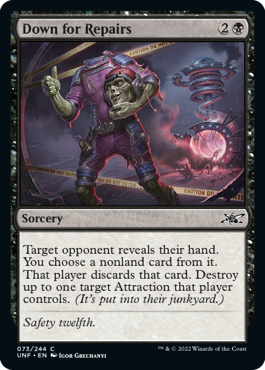
Down for Repairs (eternal)
{2}{B}
Sorcery
Target opponent reveals their hand. You choose a nonland card from it. That player discards that card. Destroy up to one target Attraction that player controls. (It's put into their junkyard.)
- Down for Repairs targets both the opponent and the Attraction, if any. You choose both targets if you cast the spell. If only one of those targets is legal as the spell resolves, you'll still do as much as you can to the remaining legal target. The illegal target will be unaffected. If both targets become illegal, the spell won't resolve and none of its effects will happen.
- If an Attraction that is not normally an Attraction (probably because it's a copy of an Attraction) is destroyed, it will go to its owner's graveyard as normal, not their junkyard.
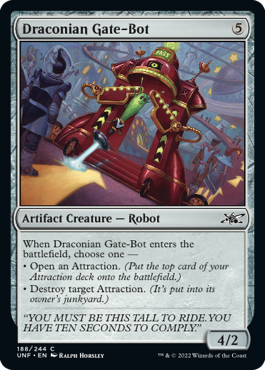
Draconian Gate-Bot (eternal)
{5}
Artifact Creature — Robot
4/2
When Draconian Gate-Bot enters the battlefield, choose one —
• Open an Attraction. (Put the top card of your Attraction deck onto the battlefield.)
• Destroy target Attraction. (It's put into its owner's junkyard.)
- If an Attraction that is not normally an Attraction (probably because it's a copy of an Attraction) is destroyed, it will go to its owner's graveyard as normal, not their junkyard.
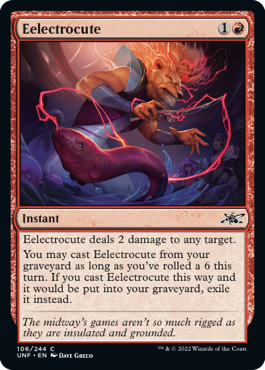
Eelectrocute (eternal)
{1}{R}
Instant
Eelectrocute deals 2 damage to any target.
You may cast Eelectrocute from your graveyard as long as you've rolled a 6 this turn. If you cast Eelectrocute this way and it would be put into your graveyard, exile it instead.
- If you cast Eelectrocute from your graveyard, you still pay its costs.
- If you cast Eelectrocute from your graveyard using another permission, you won't exile it instead (unless that permission also states that you exile it).
- For the last ability, it doesn't matter how many pips the die you rolled a 6 on had, whether that was a six-sided die or a d20. As long as you rolled a 6 on any die that turn, you may cast Eelectrocute from your graveyard.
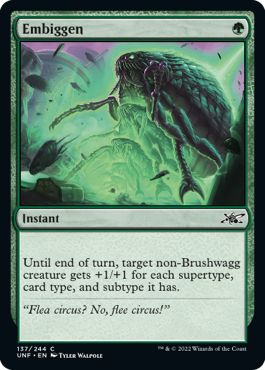
Embiggen (eternal)
{G}
Instant
Until end of turn, target non-Brushwagg creature gets +1/+1 for each supertype, card type, and subtype it has.
- The bonus is calculated as Embiggen resolves. After that point, the bonus doesn't change no matter what happens to the creature's types.
- All subtypes count, including those that aren't creature types. Good news for the Artifact Creature — Treasure Dogs out there.
- Token is not a type, supertype, or subtype, so it won't ever count toward Embiggen's effect.
- Brushwaggs know what they did.
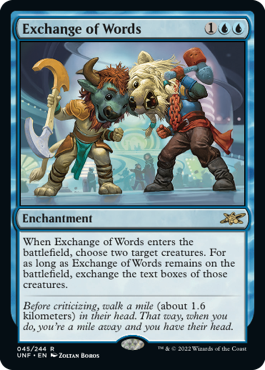
Exchange of Words (eternal)
{1}{U}{U}
Enchantment
When Exchange of Words enters the battlefield, choose two target creatures. For as long as Exchange of Words remains on the battlefield, exchange the text boxes of those creatures.
- Exchanging two creatures' text boxes means that each one loses its rules text and replaces it with the rules text the other one had. In Un- games, this also means the text boxes themselves are exchanged, including the flavor text and watermarks in those text boxes. In both cases, this is a text-changing effect.
- Notably, ability stickers (and other granted abilities) aren't part of the rules text that get exchanged. Any ability stickers on either of the two permanents continue to apply to the permanent they are on.
- If Exchange of Words leaves the battlefield before its enters-the-battlefield ability resolves, the text boxes are never exchanged. Neither creature is ever affected. The same is true if either of the two creatures becomes an illegal target before the enters-the-battlefield ability resolved.
- Once the exchange has happened, either of the two creatures leaving the battlefield has no effect on the other creature's text box. The exchange will only end once Exchange of Words is no longer on the battlefield. Similarly, further changes to either creature's text box won't change the other's text box.
- If Exchange of Words has lost its own abilities (or perhaps its text box), the effect will still only end once it is no longer on the battlefield.
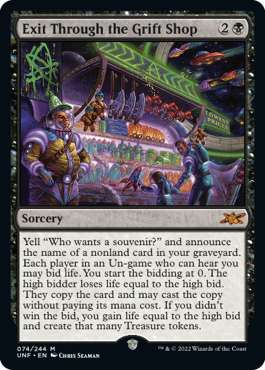
Exit Through the Grift Shop (acorn)
{2}{B}
Sorcery
Yell "Who wants a souvenir?" and announce the name of a nonland card in your graveyard. Each player in an Un- game who can hear you may bid life. You start the bidding at 0. The high bidder loses life equal to the high bid. They copy the card and may cast the copy without paying its mana cost. If you didn't win the bid, you gain life equal to the high bid and create that many Treasure tokens.
- Players may bid in any order. If two or more players try to place the same bid at the same time, you choose which of them does so. Bidding continues until no one places additional bids and the high bid stands. Players may bid at any time while bidding is in progress. End the bidding in a reasonable time frame and don't drag the bidding on for too long.
- Players can't bid more life than they have.
- The winning bidder casts the copy while Exit Through the Grift Shop is resolving.
- If the copy is a permanent spell, it enters the battlefield as a token.
- If there are stickers on the card, the copy won't have any of those stickers.
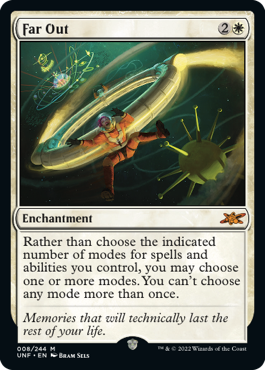
Far Out (acorn)
{2}{W}
Enchantment
Rather than choose the indicated number of modes for spells and abilities you control, you may choose one or more modes. You can't choose any mode more than once.
- Far Out applies only to modal spells and abilities. These include two or more options in a bulleted list preceded by instructions to choose a number of those options, such as "Choose one —" or similar. Each of those options is a mode. Older cards didn't include the bulleted lists, but they have received updates to their Oracle texts and will be affected by Far Out.
- The effects of modal spells and abilities always happen in the order the modes are printed on the card. The first mode will always happen before the second, which happens before the third, and so on.
- Some spells have text that allows you to choose the same mode more than once. If you cast such a spell and choose to apply Far Out's effect to it, you won't be able to choose any single mode more than once.
- If a mode requires a target, you must be able to choose a legal target in order to choose that mode.
- Okay, so Outlaws' Merriment and similar cards are weird. Far Out, even. For cards with mutually exclusive modes like Outlaws' Merriment, you get all of the benefits of the modes you chose, combined as best you can. For Outlaws' Merriment, that means you create a single red and white creature token with all the characteristics from every mode you chose. Powers get added together and toughnesses get added together. If you choose two modes (and why would you?), they're still random. If you much more sensibly choose all three modes, you get a 6/4 Human Warrior Cleric Rogue with trample, lifelink, haste, and "When this creature enters the battlefield, it deals 1 damage to any target."
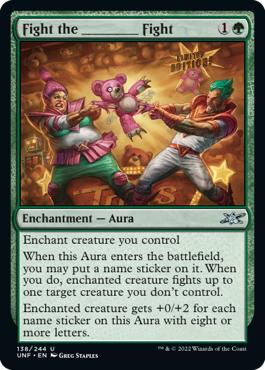
Fight the ________ Fight (eternal)
{1}{G}
Enchantment — Aura
Enchant creature you control
When this Aura enters the battlefield, you may put a name sticker on it. When you do, enchanted creature fights up to one target creature you don't control.
Enchanted creature gets +0/+2 for each name sticker on this Aura with eight or more letters.
- If you choose not to put a name sticker on this Aura as its enters-the-battlefield ability resolves, the reflexive trigger that causes the fight won't trigger. Putting a name sticker on this Aura after that point won't cause it to trigger.

Finishing Move (eternal)
{2}{G}
Sorcery
You get {TK}{TK}, then you may put a sticker on a nonland permanent you own. Target creature you control deals damage equal to its power to target creature you don't control.
- You must choose a creature you control and a creature you don't control as targets to cast Finishing Move.
- The nonland permanent you put a sticker on, if any, isn't a target of the spell and is chosen as the spell resolves. It can be the creature that's about to deal damage, but it doesn't have to be.
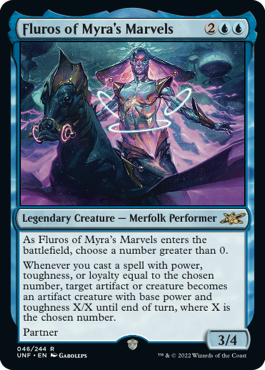
Fluros of Myra's Marvels (acorn)
{2}{U}{U}
Legendary Creature — Merfolk Performer
3/4
As Fluros of Myra's Marvels enters the battlefield, choose a number greater than 0.
Whenever you cast a spell with power, toughness, or loyalty equal to the chosen number, target artifact or creature becomes an artifact creature with base power and toughness X/X until end of turn, where X is the chosen number.
Partner
- Fluros's middle ability triggers only once if you cast a creature or Vehicle spell with power and toughness both equal to the chosen number.
- Fluros's middle ability will overwrite any previous effects that set the target's power and toughness (if any) to specific numbers. Effects that otherwise modify its power and toughness will still apply no matter when they took effect. The same is true for +1/+1 counters.
- If Fluros's middle ability causes a Vehicle to become an artifact creature, it doesn't count as "crewing" that Vehicle for any ability that would trigger off of a Vehicle becoming crewed. That Vehicle will become an X/X artifact creature, not whatever its printed power/toughness is.
- Even in an Un- game, you must choose 0 or a positive integer. This is a change from previous Un- rules.
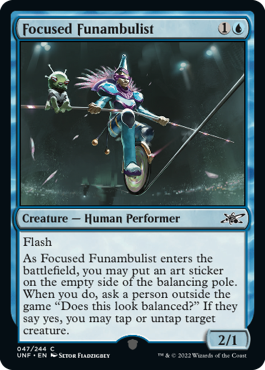
Focused Funambulist (acorn)
{1}{U}
Creature — Human Performer
2/1
Flash
As Focused Funambulist enters the battlefield, you may put an art sticker on the empty side of the balancing pole. When you do, ask a person outside the game "Does this look balanced?" If they say yes, you may tap or untap target creature.
- You have to think spatially and ignore the wire in the foreground.
- It mostly doesn't matter where on the right side of the balancing pole you place the sticker, but the outside person may take your placement into account when judging if it looks balanced or not.
- The outside person will have to decide for themselves how heavy they think the alien is.
- Placing an art sticker is optional. If you don't, the reflexive triggered ability doesn't trigger. You won't ask an outside person to decide if your clearly unbalanced pole looks balanced.
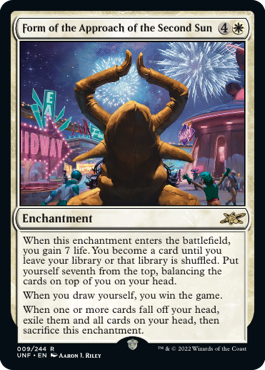
Form of the Approach of the Second Sun (acorn)
{4}{W}
Enchantment
When this enchantment enters the battlefield, you gain 7 life. You become a card until you leave your library or that library is shuffled. Put yourself seventh from the top, balancing the cards on top of you on your head.
When you draw yourself, you win the game.
When one or more cards fall off your head, exile them and all cards on your head, then sacrifice this enchantment.
- As long as you're still in your library, you'll remain a card even if Form of the Approach of the Second Sun leaves the battlefield.
- If you put yourself into your hand (ow) without drawing yourself, such as with a "tutor" effect, you'll just stop being a card. The ability that has you win the game won't trigger.
- While in your library, you are a planeswalker card, but you don't have a mana cost or any other characteristics. If instructed to search for a planeswalker card or for any card, you could find yourself (literally as well as spiritually).
- If you put yourself somewhere else in your library without shuffling, all cards on top of you should be balanced on your head. This is also true if cards are put on top of your library while you're in that library.
- To balance cards on top of your head, the cards must be above your head and physically connected to your head in some way, held up only by gravity. The cards don't have to be touching your head, so they can be balanced on top of a hat, for example, but you can't put something on top of them or use adhesives to keep them in place. A good test to see if you're balancing them properly is that the cards should be able to fall off if you tilt your head until it is horizontal.
- No player may physically interfere with you or touch you in any way to try and get the cards on top of you to fall. If another player is instructed to touch your library while you are a card, communicate with them to follow the instructions safely and comfortably. For example, if an opponent is instructed to look at the top card of your library, you should hand them that card, and so on.
- If you're on top of your library, and the top card of your library is revealed, this should have no effect on what you're wearing.
- If Form of . . . you know . . . leaves the battlefield, there will be no consequence for cards falling off your head. Just put the cards back and try not to knock your library over in the middle of the game. Of course, you won't win the game for drawing yourself either. You'll just stop being a card and the game will continue.
- If you draw yourself, you stop being a card, but you don't immediately draw another card to replace yourself.
- As clever as it may be, drawing a picture of yourself doesn't count as drawing yourself in this context.
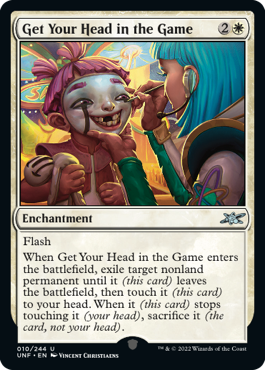
Get Your Head in the Game (acorn)
{2}{W}
Enchantment
Flash
When Get Your Head in the Game enters the battlefield, exile target nonland permanent until it (this card) leaves the battlefield, then touch it (this card) to your head. When it (this card) stops touching it (your head), sacrifice it (the card, not your head).
- Anywhere on your head is good—chin, cheek, ears, forehead, other cheek—it all works.
- The card doesn't have to balanced on your head. It simply must be in contact with your head.
- Get Your Head in the Game stops touching your head once contact with your head is broken.
- No other player may physically interfere with you to remove Get Your Head in the Game from your head. Touching other players without permission is unsporting conduct.
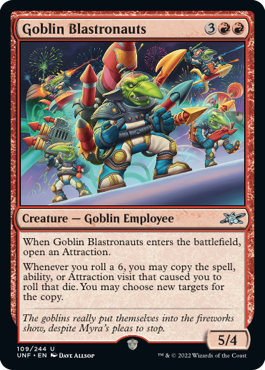
Goblin Blastronauts (acorn)
{3}{R}{R}
Creature — Goblin Employee
5/4
When Goblin Blastronauts enters the battlefield, open an Attraction.
Whenever you roll a 6, you may copy the spell, ability, or Attraction visit that caused you to roll that die. You may choose new targets for the copy.
- If you copy a spell or ability, the spell or ability will include instructions to roll more dice. You don't automatically carry the 6 from the original roll over to the copy. On the plus side, this gives you the chance to roll more 6s!
- If you copy an Attraction visit, roll another six-sided die and visit Attractions based on the result as you normally would. If you roll another 6, that will trigger Goblin Blastronauts's last ability again, which can let you roll another 6. You can keep visiting Attractions this way until your luck runs out or you get sick of the rides.
- If you roll multiple 6s, Goblin Blastronauts's ability will trigger for each 6 you rolled, allowing you to copy the spell or ability that caused the die roll that many times. (Attraction visits always include only a single die roll.)
- Activated and triggered abilities can be copied. Other abilities can't. If the roll happened because of a replacement effect as part of a static ability (for example, the ability that sets Vedalken Squirrel-Whacker's base power and toughness), that ability isn't copied. Mana abilities also can't be copied.
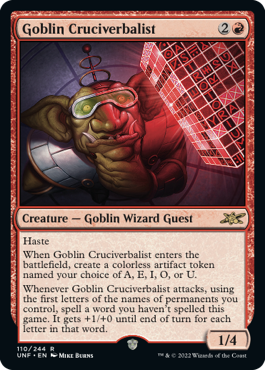
Goblin Cruciverbalist (acorn)
{2}{R}
Creature — Goblin Wizard Guest
1/4
Haste
When Goblin Cruciverbalist enters the battlefield, create a colorless artifact token named your choice of A, E, I, O, or U.
Whenever Goblin Cruciverbalist attacks, using the first letters of the names of permanents you control, spell a word you haven't spelled this game. It gets +1/+0 until end of turn for each letter in that word.
- The token will have one of five names: A, E, I, O, or U. It won't be named "your choice of A, E, I, O, or U."
- The token doesn't have any abilities and doesn't usually do much except give you a vowel to work with when spelling words.
- When determining the first letter of a name, ignore all spaces and punctuation, including blank lines.
- Each time you spell a word, you can use the first letter of each permanent you control only once in that word. For example, if you control three permanents starting with A, B, and N, you can spell out the words "Ban" or "Nab," but you can't spell out "Banana" unless you gain control of two more A's and another N.
- "Haven't spelled this game" means for any game reason, including previous Goblin Cruciverbalists you controlled but not including words you just spelled for fun, like . . . um, people do. Keep track of the words you spell if you expect remembering them to be challenging.
- You may consult a dictionary if not all players agree that you have chosen a cromulent word.

Goblin Girder Gang (acorn)
{3}{R}
Creature — Goblin Employee
0/4
Reach
Whenever you roll a die, if the result isn't stored on Goblin Girder Gang, you may store that result on it. When you do, Goblin Girder Gang deals 1 damage to any target without a hat.
Goblin Girder Gang gets +1/+0 for each result stored on it.
- Goblin Girder Gang has received a minor update to its triggered ability. Specifically, the ability will check both as it triggers and as it tries to resolve to see if the result is stored on Goblin Girder Gang. For example, if 3 is not stored on Goblin Girder Gang and you roll two 3s, the ability will trigger twice. If you store the first 3 on it, the second ability won't resolve as it will see that 3 is now stored on Goblin Girder Gang.
- To store a result means to lock the result and save it on Goblin Girder Gang. Once a certain result is stored on Goblin Girder Gang, it remains stored until Goblin Girder Gang leaves the battlefield.
- You can store any result of a die roll on Triple G, including numbers lower than 1, numbers higher than 6, and even numbers higher than 20. You can even store non-numbers such as blank faces or CHAOS by rolling the planar die.
- A target is "without a hat" if they don't meet the criteria for "having a hat." (You probably don't need to look that up. It means what you think it means.)
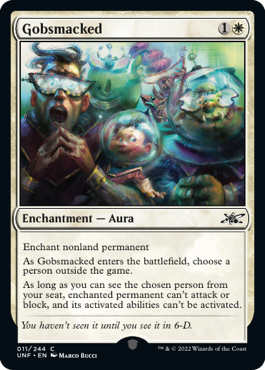
Gobsmacked (acorn)
{1}{W}
Enchantment — Aura
Enchant nonland permanent
As Gobsmacked enters the battlefield, choose a person outside the game.
As long as you can see the chosen person from your seat, enchanted permanent can't attack or block, and its activated abilities can't be activated.
- You don't have to be always looking at the person in order for the last ability to function. It just needs to be possible for you to see them from your seat. This isn't a gotcha game where your opponent waits for you to blink and then quickly activates abilities.
- If the person leaves the room, or otherwise obscures themselves from your view, the last ability will stop having any effect. If they return to your view, the last ability will function once again. They don't even need to know that they've been chosen; you can tell them if you'd like, but they may take that as a sign to get up and go for a walk.
- If the person leaves the room, you can't pick up your seat and follow them. Your seat stays with the game with you in it.
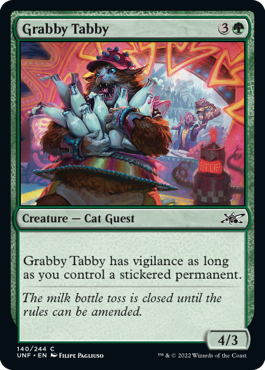
Grabby Tabby (eternal)
{3}{G}
Creature — Cat Guest
4/3
Grabby Tabby has vigilance as long as you control a stickered permanent.
- The stickered permanent could be Grabby Tabby itself or another permanent you control.
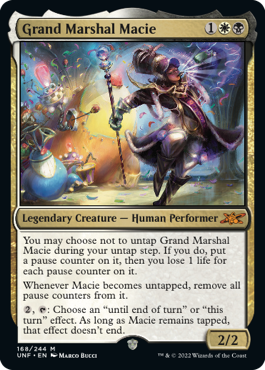
Grand Marshal Macie (acorn)
{1}{W}{B}
Legendary Creature — Human Performer
2/2
You may choose not to untap Grand Marshal Macie during your untap step. If you do, put a pause counter on it, then you lose 1 life for each pause counter on it.
Whenever Macie becomes untapped, remove all pause counters from it.
{2}, {T}: Choose an "until end of turn" or "this turn" effect. As long as Macie remains tapped, that effect doesn't end.
- The chosen effect can be from any source, including one controlled by an opponent.
- You may choose to untap Macie during your untap step. If you do, the chosen effect will immediately end if its scheduled duration has already elapsed. This also happens if Macie becomes untapped some other way at some other time or if Macie leaves the battlefield.
- If Macie becomes untapped or leaves the battlefield and the chosen effect's scheduled duration hasn't already elapsed, the effect will continue until that time. You can use Macie's last ability again to make sure it doesn't end during the cleanup step.
- If Macie becomes untapped before her last ability resolves, you won't choose any effect to not end.
- Removing pause counters from Macie won't cause her to untap and won't cause the chosen effect to end.
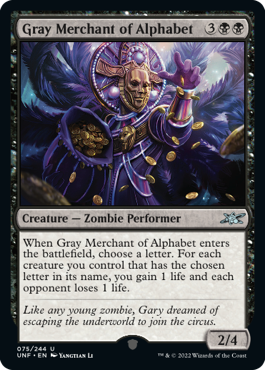
Gray Merchant of Alphabet (acorn)
{3}{B}{B}
Creature — Zombie Performer
2/4
When Gray Merchant of Alphabet enters the battlefield, choose a letter. For each creature you control that has the chosen letter in its name, you gain 1 life and each opponent loses 1 life.
- The chosen letter needn't be in the English alphabet.
- It doesn't matter how many times the chosen letter appears in the creature's name as long as it appears at least once. It's 1 life per creature, not per letter.
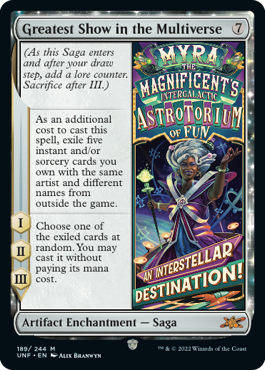
Greatest Show in the Multiverse (acorn)
{7}
Artifact Enchantment — Saga
As this Saga enters and after your draw step, add a lore counter. Sacrifice after III.)
As an additional cost to cast this spell, exile five instant and/or sorcery cards you own with the same artist and different names from outside the game.
I, II, III — Choose one of the exiled cards at random. You may cast it without paying its mana cost.
- Cards have the same artist if there's an artist in common among them. For example, you could exile four cards illustrated by Zoltan Boros and one card illustrated by Zoltan Boros & Gabor Szikszai. However, you could not exile two cards illustrated by Zoltan Boros, two by Gabor Szikszai, and one by both of them, as those five cards don't have a single artist in common across all of them.
- You choose whether to cast the chosen card as part of the chapter ability's resolution. If you choose not to cast it at that time, or if you can't cast it (perhaps because it requires a target and there are no legal targets available), you won't be able to cast it later. But maybe a later chapter will randomly choose the card again! Hope springs eternal under the big top.
- In Un- games, you can choose any applicable cards from outside the game, even if they're not part of your Draft or Sealed pool or part of your Constructed sideboard.
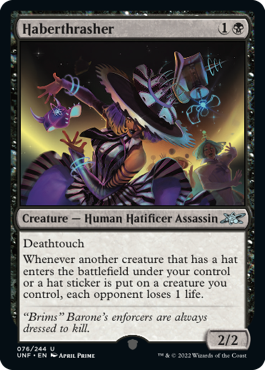
Haberthrasher (acorn)
{1}{B}
Creature — Human Hatificer Assassin
2/2
Deathtouch
Whenever another creature that has a hat enters the battlefield under your control or a hat sticker is put on a creature you control, each opponent loses 1 life.
- If a creature you control enters the battlefield with a hat sticker on it, Haberthrasher's triggered ability will trigger twice.
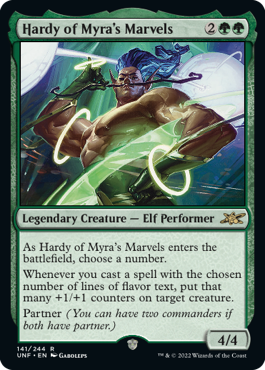
Hardy of Myra's Marvels (acorn)
{2}{G}{G}
Legendary Creature — Elf Performer
4/4
As Hardy of Myra's Marvels enters the battlefield, choose a number.
Whenever you cast a spell with the chosen number of lines of flavor text, put that many +1/+1 counters on target creature.
Partner (You can have two commanders if both have partner.)
- Even in an Un- game, you must choose 0 or a positive integer. This is a change from previous Un- rules.
- If you choose 0 and cast a spell with no flavor text, Hardy's triggered ability will trigger and you'll put zero +1/+1 counters on target creature. Congrats. You did it.

Hat Trick (acorn)
{1}{W}
Instant
Target blocking or blocked creature you control gets +1/+1 and gains first strike until end of turn. If it has a hat, it gains double strike until end of turn. If you and that creature each have a hat, the creature gains triple strike until end of turn.
- A creature with triple strike deals combat damage up to three times per combat: once along with other creatures with first strike (or double strike or triple strike), again with creatures without those abilities, and again along with creatures with last strike (an Un- game exclusive). The creature must survive each combat damage step in order to deal combat damage in the next one.
- Additional hats won't give the creature more "strikes," but we like your spirit.
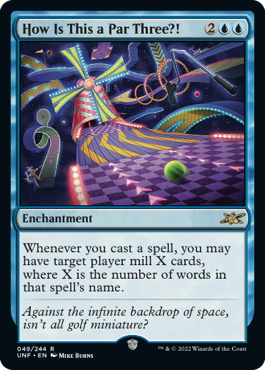
How Is This a Par Three?! (acorn)
{2}{U}{U}
Enchantment
Whenever you cast a spell, you may have target player mill X cards, where X is the number of words in that spell's name.
- If X is greater than the number of cards in the targeted player's library, you can't choose to have them mill any cards. This is because if you are given a choice and one of the options is impossible, you can't choose the impossible option. (That means you should make sure to cast Our Market Research Shows That Players Like Really Long Card Names So We Made this Card to Have the Absolute Longest Card Name Ever Elemental before their library gets too small.)

Icing Manipulator (acorn)
{1}{G}
Creature — Human Employee
1/3
Each +1/+1 counter on a creature you control is also a Food token. (It's an artifact with "{2}, {T}, Sacrifice this artifact: You gain 3 life.")
{3}{G}, {T}: Roll two six-sided dice. For each odd result, put a +1/+1 counter on a creature of your choice. Activate only as a sorcery.
- The +1/+1 counters that are also Food tokens are still +1/+1 counters. They should stay on whatever permanent they were on, even though they become permanents themselves. That acorn symbol at the bottom of the card isn't messing around here.
- The +1/+1 counters/Food tokens are artifacts, so anything that counts artifacts will count them. They can be tapped, untapped, sacrificed, and so on. They can even attack and block if you find a way to make them creatures.
- +1/+1 counters aren't "attached" to the creatures they're on like an Aura or Equipment is, so a +1/+1 counter/Food token that becomes a creature stays on the creature its on. It still gives that creature a +1/+1 bonus. It doesn't give itself a +1/+1 bonus. Note that +1/+1 counters/Food tokens don't have a mana cost, so their mana value is 0. Many ways of turning them into creatures will turn them into 0/0 creatures, so unless something else is raising their toughness, they'll immediately spoil . . . er, die.
- The activated ability doesn't target any creature. You choose which creatures get counters after you roll the dice. If you roll two odd numbers, you may put both +1/+1 counters on the same creature.
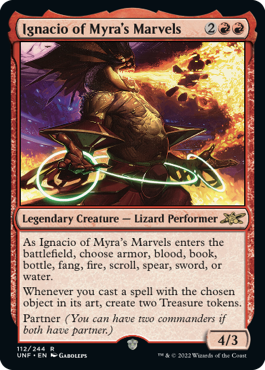
Ignacio of Myra's Marvels (acorn)
{2}{R}{R}
Legendary Creature — Lizard Performer
4/3
As Ignacio of Myra's Marvels enters the battlefield, choose armor, blood, book, bottle, fang, fire, scroll, spear, sword, or water.
Whenever you cast a spell with the chosen object in its art, create two Treasure tokens.
Partner (You can have two commanders if both have partner.)
- Armor is a covering worn on the body to protect against damage. It is typically metal or leather, although it can be made from anything. It can't be a natural part of the creature.
- Blood is a liquid, usually red, that comes from within a creature's circulatory system. If the blood isn't with its previous owner—say it's in a pool on the floor—the previous owner doesn't need to be in the art. The blood does need to contextually be blood. Red liquid in a goblet might not be blood. Red liquid in a goblet held by a vampire? Blood. Red anything at a wedding for a pair of ancient vampires? Take a wild guess.
- A book is any bound pages of writing, usually with a spine of some sort. Scrolls are not books. They are scrolls. See: Scroll.
- A bottle is a device intended to hold liquid or small objects. It is usually made of glass. Bottles typically have necks and are designed to pour their contents. The bottle may be empty, but it should clearly be designed to hold something.
- A fang is a tooth, typically longer than a creature's other teeth, and typically used to puncture enemies, often to drink their blood. The presence of non-fang teeth is important to establish that what you see are fangs and the creature just doesn't have very long teeth.
- Fire is combustion or burning, whereby substances combine chemically with oxygen from the air and typically give out bright light, heat, and smoke. Fire is usually red, orange, or yellow, but it can be other colors. Note that being a hot thing doesn't necessarily make something fire. Magma and lava, for example, are not inherently fire, although they may cause fire.
- A scroll is one or more pages or parchments, usually designed to be rolled up. Scrolls can be open or closed. Books are not scrolls. They are books. See: Book.
- A spear is the recommended serving size of pickle. It is also a pole with a pointed blade on one end. It is traditionally a weapon. For our purposes, the spear can be thrown (javelins are okay), as long the weapon's general shape clearly implies spear. It can be sticking out of a body.
- A sword is a bladed weapon with a handle. If a creature is wearing a scabbard with a sword in it, and all you can see is the handle, that counts.
- Water is a liquid found in lakes, oceans, pools, wells, rivers, and glasses both half-empty and half-full. The liquid must contextually be water. Rain counts. Note that you must see the water. A well wouldn't count if you couldn't see the water inside, for example, even if the water is implied.
- If all players can't agree on what's in the art, you may consult an outside person for a final determination.
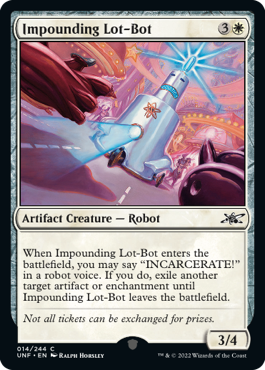
Impounding Lot-Bot (acorn)
{3}{W}
Artifact Creature — Robot
3/4
When Impounding Lot-Bot enters the battlefield, you may say "INCARCERATE!" in a robot voice. If you do, exile another target artifact or enchantment until Impounding Lot-Bot leaves the battlefield.
- There are many different kinds of robots, so you can determine what "robot voice" means to you, though it should probably sound different from your regular voice (unless you're a robot, I suppose, in which case I for one welcome our new robot overlords).
- If Impounding Lot-Bot leaves the battlefield before its enters-the-battlefield ability resolves, the target artifact or enchantment won't be exiled, even if you say INCARCERATE! You should say it anyway though.
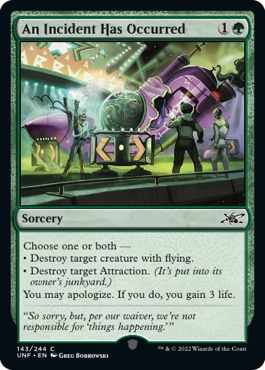
An Incident Has Occurred (acorn)
{1}{G}
Sorcery
Choose one or both —
• Destroy target creature with flying.
• Destroy target Attraction. (It's put into its owner's junkyard.)
You may apologize. If you do, you gain 3 life.
- You may apologize no matter which modes you chose.
- Only you know what's in your heart, but you need to at least sound sincere while apologizing.
- Your opponent doesn't need to accept your apology. You gain 3 life either way.
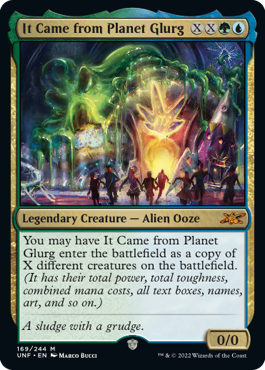
It Came from Planet Glurg (acorn)
{X}{X}{G}{U}
Legendary Creature — Alien Ooze
0/0
You may have It Came from Planet Glurg enter the battlefield as a copy of X different creatures on the battlefield. (It has their total power, total toughness, combined mana costs, all text boxes, names, art, and so on.)
- It Came from Planet Glurg copies exactly what was printed on the original creatures and nothing more (unless any of those creatures are copying something else or is a token; see below). It doesn't copy whether that creature is tapped or untapped, whether it has any counters or stickers on it, and Auras or Equipment attached to it, or any non-copy effects that have changed its power, toughness, types, color, and so on.
- If an effect needs information about the creature's name, it looks at all its names to determine that information. For example, if It Came from Planet Glurg becomes a copy of both Blorbian Buddy and Rat in the Hat, it has six words in its name. The first letters of its name are B and R. A creature with alpha strike whose name came before Rat in the Hat alphabetically would have first strike while in combat with it.
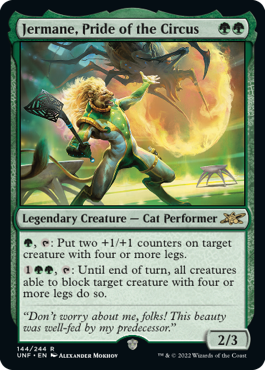
Jermane, Pride of the Circus (acorn)
{G}{G}
Legendary Creature — Cat Performer
2/3
{G}, {T}: Put two +1/+1 counters on target creature with four or more legs.
{1}{G}{G}, {T}: Until end of turn, all creatures able to block target creature with four or more legs do so.
- Generally, you look at the art of a creature card to determine whether it has four legs or not.
- If the creature is known to have more than four legs—say, it's a spider—but not all its legs are visible, it still has four or more legs. It's a legal target for either activated ability.
- Creature type alone isn't always enough to tell you whether a creature has four legs or not. For example, leonin have only two legs, while tigers have four legs, but both are Cats.
- If there are multiple creatures in the art, only compare the one that represents the actual creature on the card. For example, Tarmogoyf (MMA) has the tarmogoyf itself and an elk in the art, and you need only consider the tarmogoyf.
- If there are multiple creatures in the art that each match what the card is representing, then that creature has four or more legs as long as any one of the matching creatures in the art has four or more legs. For example, Llanowar Elves (M19) has three figures in its art, all of whom are Llanowar elves. However, none of those figures has four or more legs, so Llanowar Elves is not a valid target for Jermane's abilities. If even one of the figures had four or more legs, then the creature would be a valid target.
- If a creature the defending player controls can't block the creature targeted by the last ability for any reason (such as being tapped), then it doesn't block that creature. If there's a cost associated with having a creature block the attacking creature, the defending player isn't forced to pay that cost, so it doesn't have to block in that case either.
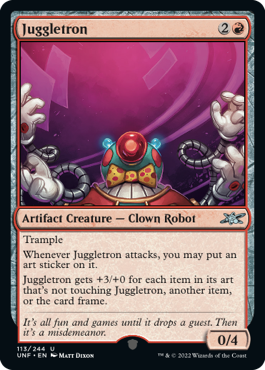
Juggletron (acorn)
{2}{R}
Artifact Creature — Clown Robot
0/4
Trample
Whenever Juggletron attacks, you may put an art sticker on it.
Juggletron gets +3/+0 for each item in its art that's not touching Juggletron, another item, or the card frame.
- In order to count toward Juggletron's power bonus, a sticker must be completely within Juggletron's art, such that no part of the sticker is touching the frame, another sticker, or Juggletron itself. This includes the entire sticker, including the white border.
- Additionally, the stickers must depict tangible items, so sound effects, thought bubbles, and the like won't count.
- If you put name, ability, or power and toughness stickers in Juggletron's art, they'll do what they're supposed to do as stickers, but they aren't items Juggletron can juggle.
- Counters are also items that Juggletron can't juggle. They're not part of the art, and Juggletron just can't get a grasp on them.
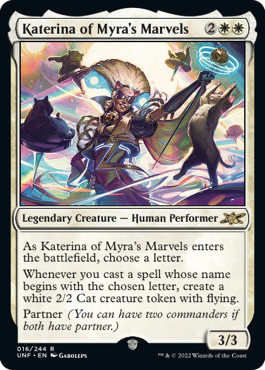
Katerina of Myra's Marvels (acorn)
{2}{W}{W}
Legendary Creature — Human Performer
3/3
As Katerina of Myra's Marvels enters the battlefield, choose a letter.
Whenever you cast a spell whose name begins with the chosen letter, create a white 2/2 Cat creature token with flying.
Partner (You can have two commanders if both have partner.)
- When determining what a name begins with, ignore all spaces and punctuation, including blank lines.
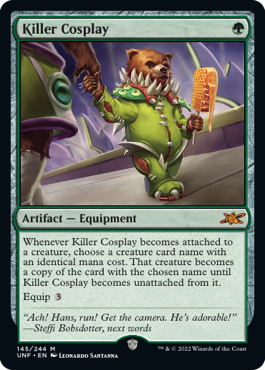
Killer Cosplay (acorn)
{G}
Artifact — Equipment
Whenever Killer Cosplay becomes attached to a creature, choose a creature card name with an identical mana cost. That creature becomes a copy of the card with the chosen name until Killer Cosplay becomes unattached from it.
Equip {3}
- An identical mana cost includes color. For example, if Killer Cosplay becomes attached to a creature with mana cost {3}{G}{G}, you couldn't name a creature card with mana cost {4}{G} or {3}{g/u}{g/u}.
- You can choose the name of any creature card that matches the condition. It does not have to be a legal card in the format you're playing or a part of your Draft or Sealed pool.
- You can choose a creature card name you've already chosen. Not getting all the style points you could, but it's allowed.
- In most cases, the equipped creature will gain all the usual copiable values of the creature card with the chosen name—that is, it will have its name, types, abilities, power, and toughness. However, if you can produce the actual card you've named, the equipped creature will also have that card's art, watermarks, and flavor text.
- An Equipment can't become attached to a creature if it's already attached to it. That is, you can activate the equip ability targeting the creature Killer Cosplay's already attached to, but that ability resolving won't do anything. Killer Cosplay's triggered ability won't trigger.
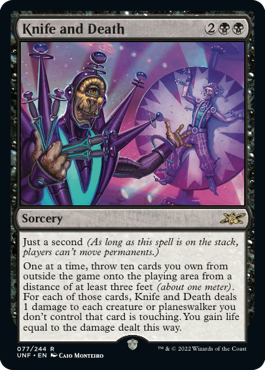
Knife and Death (acorn)
{2}{B}{B}
Sorcery
Just a second (As long as this spell is on the stack, players can't move permanents.)
One at a time, throw ten cards you own from outside the game onto the playing area from a distance of at least three feet (about one meter). For each of those cards, Knife and Death deals 1 damage to each creature or planeswalker you don't control that card is touching. You gain life equal to the damage dealt this way.
- Just a second is a variant of split second. Announcing Knife and Death instantly locks all permanents in place on the battlefield. As long as Knife and Death is on the stack, players can't cast spells, activate abilities, or move their permanents.
- The ten cards must be traditionally sized Magic cards. They can be in card sleeves if you'd like, but not otherwise modified. They must be thrown onto the battlefield from at least three feet (about one meter) away horizontally.
- No player may interfere with the throwing of the ten cards, including while they're in flight.
- Card sleeves are considered part of the card. If a thrown card (or its own card sleeve) is touching another card's sleeve, it is considered touching that card.
- If one of the cards ends up touching the object used to represent a creature or planeswalker token an opponent controls, Knife and Death will deal damage to it.
- Knife and Death considers only the creatures and planeswalkers any of the ten cards are touching after you have thrown the tenth card and all cards stop moving. It's possible that a card will land touching a creature but then will be knocked off that creature by a later throw. That is, assess damage only after all knives . . . er, cards have been thrown.
- If a thrown card ends up touching more than one creature or planeswalker you don't control, Knife and Death will deal 1 damage to each of them. You'll gain 1 life for each of them. Knife and Death won't deal damage to creatures or planeswalkers you control that get hit, and you won't gain life for them either.
- The thrown cards never actually enter the game. After Knife and Death finishes resolving, they return from whence they came, to thine sideboard or collection.
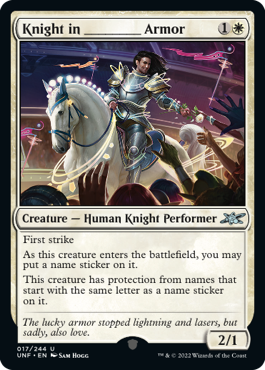
Knight in ________ Armor (acorn)
{1}{W}
Creature — Human Knight Performer
2/1
First strike
As this creature enters the battlefield, you may put a name sticker on it.
This creature has protection from names that start with the same letter as a name sticker on it.
- When determining what a name starts with, ignore all spaces and punctuation, including blank lines.
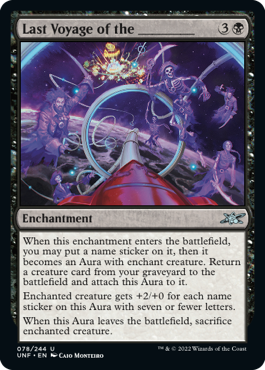
Last Voyage of the ________ (eternal)
{3}{B}
Enchantment
When this enchantment enters the battlefield, you may put a name sticker on it, then it becomes an Aura with enchant creature. Return a creature card from your graveyard to the battlefield and attach this Aura to it.
Enchanted creature gets +2/+0 for each name sticker on this Aura with seven or fewer letters.
When this Aura leaves the battlefield, sacrifice enchanted creature.
- This enchantment will become an Aura whether you put a name sticker on it or not. "Last Voyage of the ________" is kind of a disappointing name though.
- If the Aura can't become attached to the creature (for example, if the creature has protection from black), the Aura will be placed into its owner's graveyard as a state-based action. The creature will remain on the battlefield.
- Similarly, if the enchantment leaves the battlefield before its enters-the-battlefield ability resolves, you won't be able to put a name sticker on it. However, you will be able to return a creature card from your graveyard to the battlefield.
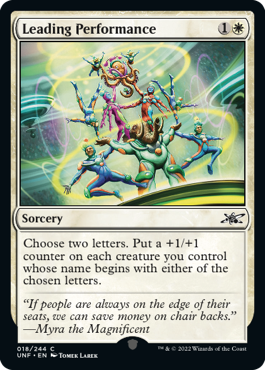
Leading Performance (acorn)
{1}{W}
Sorcery
Choose two letters. Put a +1/+1 counter on each creature you control whose name begins with either of the chosen letters.
- You must choose two different letters.
- When determining what a name begins with, ignore all spaces and punctuation, including blank lines.
- If a creature has multiple names, and each of the chosen letters is the first letter of one of its names, you'll put only one +1/+1 counter on it. This can happen with cards like It Came from Planet Glurg.
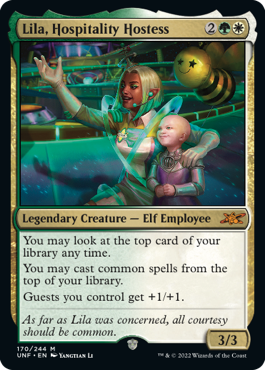
Lila, Hospitality Hostess (acorn)
{2}{G}{W}
Legendary Creature — Elf Employee
3/3
You may look at the top card of your library any time.
You may cast common spells from the top of your library.
Guests you control get +1/+1.
- Lila's middle ability doesn't change when you may cast those spells. You still pay all costs for those spells as well.
- Common cards have black expansion symbols. Cards from before Exodus don't have expansion symbols; their rarities can be found on their Gatherer entries. (Cards with the land rarity, including basic lands, also have black expansion symbols, but Lila doesn't let you play lands, so this hardly seems worth mentioning. Oh, sorry.)
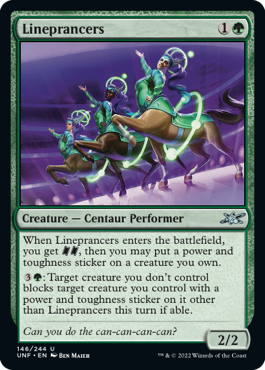
Lineprancers (eternal)
{1}{G}
Creature — Centaur Performer
2/2
When Lineprancers enters the battlefield, you get {TK}{TK}, then you may put a power and toughness sticker on a creature you own.
{3}{G}: Target creature you don't control blocks target creature you control with a power and toughness sticker on it other than Lineprancers this turn if able.
- Activating the last ability doesn't mean you have to attack with the target creature you control.
- If the creature you control does attack, and the creature you don't control can't block it for any reason (such as being tapped), then it doesn't block. If there's a cost associated with having it block the creature, its controller isn't forced to pay that cost, so it doesn't have to block in that case either. That creature is then free to block another creature or to not block at all.
- If a creature is required to block a creature with menace, another creature must also block that creature if able. If none can, the creature that's required to block can block another creature or not block at all.
- Creatures other than the first target creature may also block the second target creature.
- Once the activated ability resolves, the blocking requirement is set, even if the second target creature loses its power and toughness sticker before blockers are declared.
- If either target of the activated ability is illegal as the ability tries to resolve, it will have no effect. If both targets become illegal, the ability won't resolve at all.
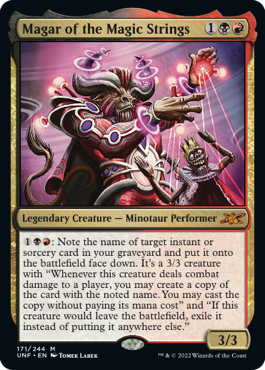
Magar of the Magic Strings (eternal)
{1}{B}{R}
Legendary Creature — Minotaur Performer
3/3
{1}{B}{R}: Note the name of target instant or sorcery card in your graveyard and put it onto the battlefield face down. It's a 3/3 creature with "Whenever this creature deals combat damage to a player, you may create a copy of the card with the noted name. You may cast the copy without paying its mana cost" and "If this creature would leave the battlefield, exile it instead of putting it anywhere else."
- The face-down creature has no characteristics other than the ones given to it by Magar's ability. It has no name, no mana cost, no creature types, and no abilities other than the two Magar gives it. The creature is colorless and has a mana value of 0.
- You may look at face-down permanents you control at any time.
- If a face-down permanent you control leaves the battlefield, or if the game ends or you leave the game while you control it, you must reveal it to all players (even though in this case, everyone saw it before it entered).
- If a creature enters the battlefield as a copy of a face-down creature (or if a token is created that's a copy of one), that copy has the same characteristics as the face-down creature (in this case, it's a 3/3 creature with the two abilities and no other characteristics), even though the copy is face up. Importantly, the noted name is not part of the face-down creature's copiable values, so copies of the face-down creature won't know the noted name. If one deals combat damage to a player, its controller won't create a copy of any card.
- You must ensure that your face-down spells and permanents can easily be differentiated from each other. You're not allowed to mix up the cards that represent them on the battlefield to confuse other players. The order they entered the battlefield should remain clear. Common methods for indicating this include using markers or dice, or simply placing them in order on the battlefield. You must also track how each became face down (Magar's ability, cast face down using the morph ability, and so on).
- There are no cards in this set that would turn a face-down instant or sorcery card on the battlefield face up, but some older cards can try to do this. If something tries to turn a face-down instant or sorcery card on the battlefield face up, reveal that card to show all players it's an instant or sorcery card. The permanent remains on the battlefield face down. Abilities that trigger when a permanent turns face up won't trigger, because even though you revealed the card, it never turned face up.
- If an effect tries to "blink" a face-down instant or sorcery card—that is, exile it and then return it to the battlefield—the card is exiled and remains in exile.
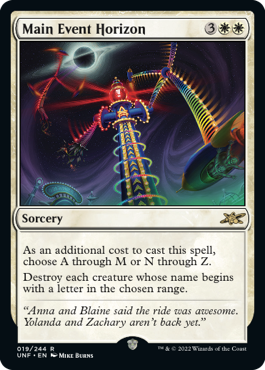
Main Event Horizon (acorn)
{3}{W}{W}
Sorcery
As an additional cost to cast this spell, choose A through M or N through Z.
Destroy each creature whose name begins with a letter in the chosen range.
- Because choosing a half of the alphabet is an additional cost, players will know which creatures are fated to be destroyed while pondering responses.
- When determining what a name begins with, ignore all spaces and punctuation, including blank lines.
- Creatures in languages that don't use an alphabet that includes the letters A through M or N through Z are safe from Main Event Horizon. They won't be destroyed no matter which of the alphabet was chosen.

Make a ________ Splash (eternal)
{2}{U}
Enchantment
Flash
When this enchantment enters the battlefield, you may put a name sticker on it.
Whenever you put a sticker on this enchantment, tap up to X target creatures, where X is the number of u's in name stickers on this enchantment.
- The last ability will trigger whenever you put any kind of sticker on this enchantment, not just name stickers, although only u's in name stickers will count toward the number of targets. Notably, u's in ability and art stickers won't count.
- Once the last ability triggers and targets are chosen, changing the number of u's in name stickers on this enchantment won't change the number of targets.
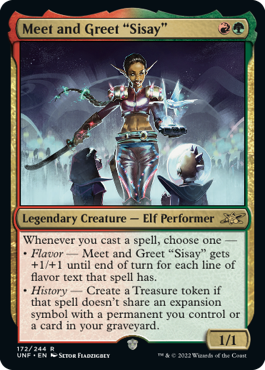
Meet and Greet "Sisay" (acorn)
{R}{G}
Legendary Creature — Elf Performer
1/1
Whenever you cast a spell, choose one —
• Flavor — Meet and Greet "Sisay" gets +1/+1 until end of turn for each line of flavor text that spell has.
• History — Create a Treasure token if that spell doesn't share an expansion symbol with a permanent you control or a card in your graveyard.
- Expansion symbols of different rarities (colors) are considered the same symbol. Essentially, the spell must be from a different expansion than every permanent you control and card in your graveyard to get the Treasure token.
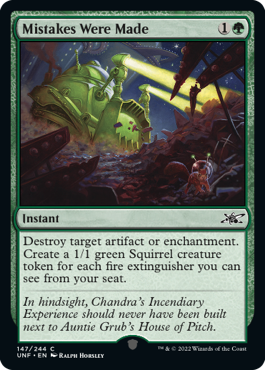
Mistakes Were Made (acorn)
{1}{G}
Instant
Destroy target artifact or enchantment. Create a 1/1 green Squirrel creature token for each fire extinguisher you can see from your seat.
- You must remain in your seat while looking around the room. No, you can't pick up your seat and walk around to get more Squirrels.
- To count, it must be a real fire extinguisher, a portable device that discharges water, foam, gas, or other material to extinguish a fire. It can't be, say, a glass of water.
- You can't bring your own fire extinguishers. They must be natural to the room you're in.
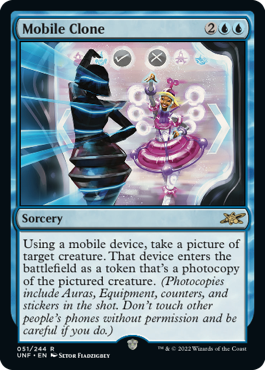
Mobile Clone (acorn)
{2}{U}{U}
Sorcery
Using a mobile device, take a picture of target creature. That device enters the battlefield as a token that's a photocopy of the pictured creature. (Photocopies include Auras, Equipment, counters, and stickers in the shot. Don't touch other people's phones without permission and be careful if you do.)
- If you don't have a mobile device capable of taking a picture, you are allowed to draw a photocopy. The drawing then enters the battlefield as a token that's a photocopy of the pictured creature.
- Nothing in the photocopy can leave the photocopy. Auras and Equipment can't be destroyed, attached to other creatures, and so on. Counters can't be moved. Stickers are stuck. These are memories frozen in time, people. Except these memories can attack and block.
- The photocopy will not only be unable to copy any non-copy effects that affected the target creature, it will also be unable to copy any copy effects that it can't see. If you take a picture of a Clone that's copying another creature, the photocopy will just be a Clone. Fortunately for you, the Clone entering the battlefield still has the ability to enter as a copy of another creature, but it won't automatically be a copy of what the original Clone was copying like a normal copy would.
- Everything in a photocopy on the battlefield is copiable. If you play a Clone copying a photocopy, the Clone would be a copy of the creature in the picture, with all the Auras, Equipment, counters, and stickers in the shot.
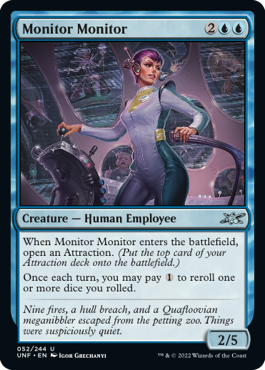
Monitor Monitor (eternal)
{2}{U}{U}
Creature — Human Employee
2/5
When Monitor Monitor enters the battlefield, open an Attraction. (Put the top card of your Attraction deck onto the battlefield.)
Once each turn, you may pay {1} to reroll one or more dice you rolled.
- You decide whether to use Monitor Monitor's ability right after you monitor the result of the die roll. You can't wait and use it to reroll that die later.
- If you roll multiple dice at the same time, paying {1} will let you reroll any number of those dice. You don't have to pay {1} per die.
- If you control multiple Monitor Monitors, you may use each of them once each turn. You may use multiple Monitor Monitors on the same die roll if you wish.
- You can use Monitor Monitor's reroll ability on any die roll, including a roll of the planar die in a Planechase game.
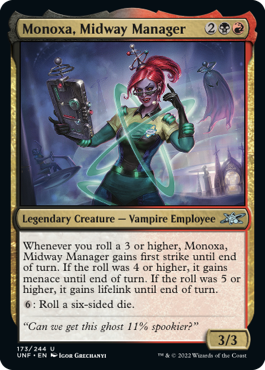
Monoxa, Midway Manager (eternal)
{2}{B}{R}
Legendary Creature — Vampire Employee
3/3
Whenever you roll a 3 or higher, Monoxa, Midway Manager gains first strike until end of turn. If the roll was 4 or higher, it gains menace until end of turn. If the roll was 5 or higher, it gains lifelink until end of turn.
{6}: Roll a six-sided die.
- The die roll caused by the activated ability has no inherent effect: you just roll a six-sided die, but any ability that triggers whenever you roll a die will trigger. Abilities that trigger whenever you roll a specific result, such as Monoxa's first ability, may also trigger.
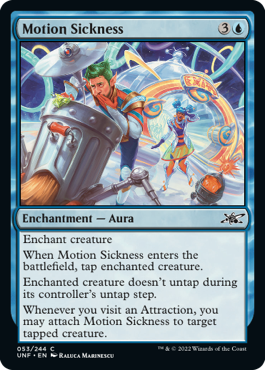
Motion Sickness (eternal)
{3}{U}
Enchantment — Aura
Enchant creature
When Motion Sickness enters the battlefield, tap enchanted creature.
Enchanted creature doesn't untap during its controller's untap step.
Whenever you visit an Attraction, you may attach Motion Sickness to target tapped creature.
- If the target creature has become untapped as the last ability tries to resolve, Motion Sickness stays attached to the creature it's already on.
- Taking a break and looking at the horizon is said to help those suffering with motion sickness. It won't remove the enchantment, but it can't really hurt either.
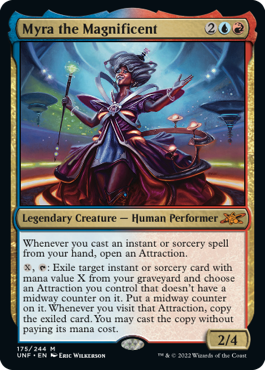
Myra the Magnificent (eternal)
{2}{U}{R}
Legendary Creature — Human Performer
2/4
Whenever you cast an instant or sorcery spell from your hand, open an Attraction.
{X}, {T}: Exile target instant or sorcery card with mana value X from your graveyard and choose an Attraction you control that doesn't have a midway counter on it. Put a midway counter on it. Whenever you visit that Attraction, copy the exiled card. You may cast the copy without paying its mana cost.
- Myra's activated ability targets only the instant or sorcery card in your graveyard. It doesn't target the Attraction. You choose the Attraction as the ability is resolving.
- Myra's activated ability creates a delayed triggered ability that will trigger whenever you visit the chosen Attraction. This ability will continue to trigger as long as the Attraction is on the battlefield and the exiled card remains exiled, even if Myra leaves the battlefield, loses her abilities, or changes controllers. It will also continue to trigger if the Attraction somehow loses the midway counter.
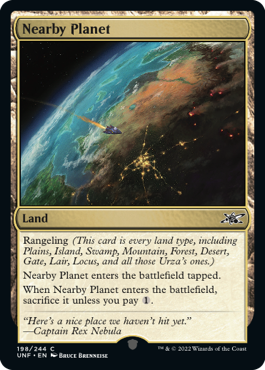
Nearby Planet (acorn)
Land
Rangeling (This card is every land type, including Plains, Island, Swamp, Mountain, Forest, Desert, Gate, Lair, Locus, and all those Urza's ones.)
Nearby Planet enters the battlefield tapped.
When Nearby Planet enters the battlefield, sacrifice it unless you pay {1}.
- The full list of land types (for now) is: Desert, Forest, Gate, Island, Lair, Locus, Mine, Mountain, Plains, Power-Plant, Swamp, Tower, and Urza's.
- Because Nearby Planet is a Plains, it has "{T}: Add {W}." The same is true for the other four basic land types and their corresponding colors of mana. None of the other land types it has gives it any mana abilities. Notably, Nearby Planet can't be tapped for {C}.
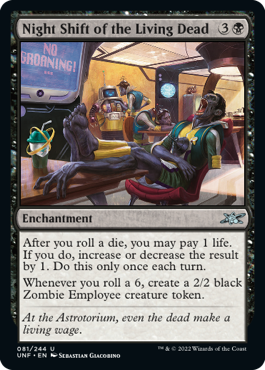
Night Shift of the Living Dead (eternal)
{3}{B}
Enchantment
After you roll a die, you may pay 1 life. If you do, increase or decrease the result by 1. Do this only once each turn.
Whenever you roll a 6, create a 2/2 black Zombie Employee creature token.
- The first ability can affect only one die, even if you roll multiple dice at the same time. However, you do get to see all the results before deciding whether to use it, and if so, which result to shift.
- If you roll the planar die in a Planechase game, you can pay 1 life, but you can't alter the result of the roll. This would still "use up" the ability for the turn.
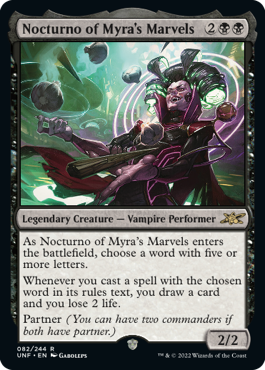
Nocturno of Myra's Marvels (acorn)
{2}{B}{B}
Legendary Creature — Vampire Performer
2/2
As Nocturno of Myra's Marvels enters the battlefield, choose a word with five or more letters.
Whenever you cast a spell with the chosen word in its rules text, you draw a card and you lose 2 life.
Partner (You can have two commanders if both have partner.)
- Only an exact match with the chosen word would cause Nocturno's triggered ability to trigger. For example, if you chose "attack," casting a spell with "attacks," "attacking," or "attacked" in the rules text wouldn't cause the ability to trigger.

Non-Human Cannonball (eternal)
{2}{R}
Artifact Creature — Clown Robot
4/3
When Non-Human Cannonball dies, roll a six-sided die. If the result is 4 or less, Non-Human Cannonball deals that much damage to you.
- If the result is somehow negative because of effects that modify the die roll, Non-Human Cannonball deals 0 damage to you.
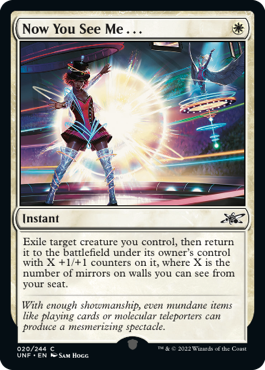
Now You See Me . . . (acorn)
{W}
Instant
Exile target creature you control, then return it to the battlefield under its owner's control with X +1/+1 counters on it, where X is the number of mirrors on walls you can see from your seat.
- You must remain in your seat while looking around the room. No, you can't pick up your seat and walk around to get more counters.
- Count only actual mirrors, not images of mirrors. If two mirrors are facing each other, you put two +1/+1 counters on the creature, not an infinite number.
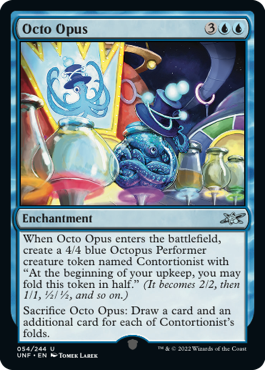
Octo Opus (acorn)
{3}{U}{U}
Enchantment
When Octo Opus enters the battlefield, create a 4/4 blue Octopus Performer creature token named Contortionist with "At the beginning of your upkeep, you may fold this token in half." (It becomes 2/2, then 1/1, ½/½, and so on.)
Sacrifice Octo Opus: Draw a card and an additional card for each of Contortionist's folds.
- To represent the token, you have three choices: (1) Use the printed token included in some Unfinity booster packs, (2) use another printed Magic card or token as a substitute, or (3) use anything else, read the next ruling, and be slightly sad.
- If you're not using a printed token or another Magic card to represent the token, you can't fold it in half. Its power, toughness, and the number of folds it has (zero) remains the same.
- Sacrificing Octo Opus has no effect on Contortionist. It will still have the ability to fold in half at the beginning of your upkeep, but doing so is optional.
- If you control more than one creature named Contortionist as the last ability resolves, perhaps because you created a copy of the token or created more than one to begin with, choose one of them and use its number of folds to determine how many cards to draw.
- If Contortionist is no longer on the battlefield, you may still sacrifice Octo Opus to draw a card.
- Creatures in Un- games with power between 0 and 1 still deal damage equal to their power, and players can have fractional life totals. For example, if a ½/½ creature deals combat damage to a player with 10 life, the player will go to 9 ½ life.
- If an effect instructs you to do something based on Contortionist's power or toughness that can only be done in whole numbers, such as draw cards, and Contortionist's power or toughness isn't a whole number, ignore that instruction. You can't draw half a card, mill a quarter of a card, etc.
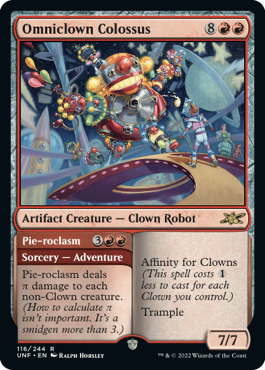
Omniclown Colossus (acorn)
{8}{R}{R}
Artifact Creature — Clown Robot
7/7
Affinity for Clowns (This spell costs {1} less to cast for each Clown you control.)
Trample
//ADV//
Pie-roclasm
{3}{R}{R}
Sorcery — Adventure
Pie-roclasm deals π damage to each non-Clown creature. (How to calculate π isn't important. It's a smidgen more than 3.)
- Only the Omniclown Colossus has affinity for Clowns. Pie-roclasm is indifferent toward Clowns and will not cost {1} less for each Clown you control.
- A single Pie-roclasm will destroy all non-Clown creatures with toughness 3 or less. Two will destroy all non-Clown creatures with toughness 6 or less. Three, with toughness 9 or less. Four, with toughness 12 ½ or less. That's a lot of pie.
- If damage from Pie-roclasm gets redirected to a player, just use 3.14.
- All the rulings from this point on are about how to play with Adventures. If you are an experienced adventurer, you can venture forth.
- An adventurer card is a permanent card in every zone except the stack, as well as while on the stack if not cast as an Adventure. Ignore its alternative characteristics in those cases. For example, while it's in your graveyard, Omniclown Colossus is a red artifact creature card whose mana value is 10.
- When casting a spell as an Adventure, use the alternative characteristics and ignore all of the card's normal characteristics. The spell's color, mana cost, mana value, and so on are determined by only those alternative characteristics. If the spell leaves the stack, it immediately resumes using its normal characteristics.
- If a spell is cast as an Adventure, its controller exiles it instead of putting it into its owner's graveyard as it resolves. For as long as it remains exiled, that player may cast it as a permanent spell. If an Adventure spell leaves the stack in any way other than resolving (Pie-roclasm doesn't require targets, so most likely by being countered), that card won't be exiled and the spell's controller won't be able to cast it as a creature later.
- If an adventurer card ends up in exile for any other reason than by exiling itself while resolving, it won't give you permission to cast it as a creature spell.
- You must still follow any timing restrictions and permissions for the creature spell you cast from exile. Normally, you'll be able to cast it only during your main phase while the stack is empty.
- If an effect copies an Adventure spell, that copy is exiled as it resolves. It ceases to exist as a state-based action; it's not possible to cast the copy as a creature.
- If an object becomes a copy of an object that has an Adventure, the copy also has an Adventure. If it changes zones, it will either cease to exist (if it's a token) or cease to be a copy (if it's a nontoken permanent), and so you won't be able to cast it as an Adventure.
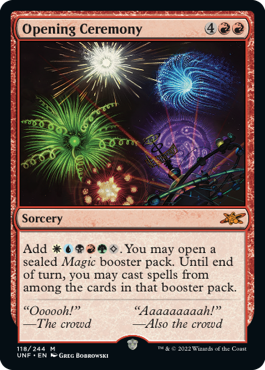
Opening Ceremony (acorn)
{4}{R}{R}
Sorcery
Add {W}{U}{B}{R}{G}{C}. You may open a sealed Magic booster pack. Until end of turn, you may cast spells from among the cards in that booster pack.
- You can use any unopened, official Magic booster pack, including promotional booster packs.
- You must still pay all costs and follow all normal timing rules when casting spells from among the cards in the booster pack.
- The spells you cast this way are cast from outside the game. Casting a card brings it into the game. After the spell leaves the stack, it will go to the battlefield, the graveyard, exile, or wherever it's supposed to go depending on what type of spell it is. Remove the card from your deck after the game ends.
- Opening Ceremony has four lines of flavor text.
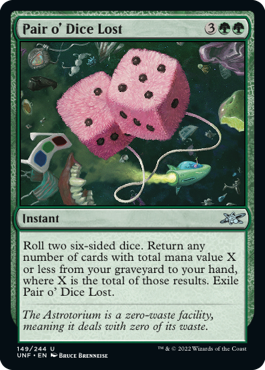
Pair o' Dice Lost (eternal)
{3}{G}{G}
Instant
Roll two six-sided dice. Return any number of cards with total mana value X or less from your graveyard to your hand, where X is the total of those results. Exile Pair o' Dice Lost.
- Pair o' Dice Lost doesn't target any of the cards in the graveyard. You choose which cards you're returning to your hand, if any, after rolling the dice.
- You can return any number of cards with mana value 0 (such as land cards) from your graveyard to your hand regardless of the results.
- If Pair o' Dice Lost resolves, it will be exiled, even if you don't return any cards to your hand.
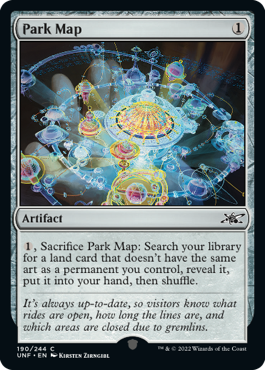
Park Map (acorn)
{1}
Artifact
{1}, Sacrifice Park Map: Search your library for a land card that doesn't have the same art as a permanent you control, reveal it, put it into your hand, then shuffle.
- A card has the same art as another card if it has the same illustration by the same artist. If a card is modified with an art sticker, its art is no longer the same art as its original card. But other stickers that happen to be placed over the art do not modify the art. Modifications to the art that have been made outside of game effects (for example, signatures, your doodles, the occasional haiku) do not modify art.
- Ignores things like frame differences and printing variations when determining whether a land card has the same art as other cards. For example, a land card and the extended-art version of that same land card have the same art, even though the latter shows more of the art.
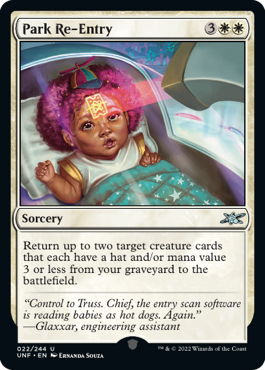
Park Re-Entry (acorn)
{3}{W}{W}
Sorcery
Return up to two target creature cards that each have a hat and/or mana value 3 or less from your graveyard to the battlefield.
- Park Re-Entry targets up to two creature cards. Each of them must have a hat, or have a mana value of 3 or less, or both.
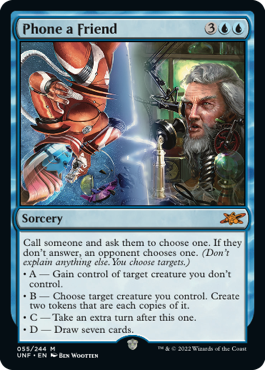
Phone a Friend (acorn)
{3}{U}{U}
Sorcery
Call someone and ask them to choose one. If they don't answer, an opponent chooses one. (Don't explain anything else. You choose targets.)
• A — Gain control of target creature you don't control.
• B — Choose target creature you control. Create two tokens that are each copies of it.
• C — Take an extra turn after this one.
• D — Draw seven cards.
- If you don't have a phone, you are allowed to ask a person outside the game who's there. However, that person isn't allowed to look at your game. Texting is also fine, but no matter how they are contacted, the person needs to respond in a timely manner. (And if your friends are anything like mine, I would not let my success depend on them responding promptly to my text messages.)
- Whichever way you "phone" a friend should be open to all players so their choice can be verified. Use speakerphone, show everyone the text, etc.
- You are allowed to read each mode in full. The letters are there to make it more like a game show.
- "If they don't answer" means you failed to contact anyone or the person you contacted didn't make a choice in a reasonable amount of time.
- If they choose A or B, and there are no legal targets available, ask them to choose another mode. You can't cast Phone a Friend with an illegal mode chosen. Yes, you could just eliminate modes that can't be chosen from the beginning, but what fun is that? If an opponent ends up choosing the mode, they also must choose a legal mode.
- You can set up the general context of the call ("I'm in a Magic game and I need someone outside the game to make a choice"), but you shouldn't explain anything that's going on in the game or what the consequences of their choice may be.
- The friend you phone can be someone who doesn't play Magic. If so, inform them that they can learn to play at a local game store near them (refer to rule 100.6b in the Magic Comprehensive Rules for details), or they can head to MTGArena.com and download today!
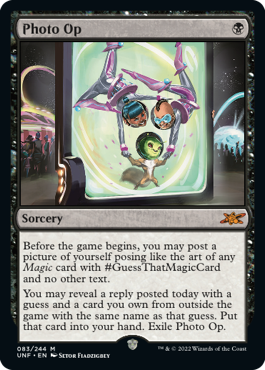
Photo Op (acorn)
{B}
Sorcery
Before the game begins, you may post a picture of yourself posing like the art of any Magic card with #GuessThatMagicCard and no other text.
You may reveal a reply posted today with a guess and a card you own from outside the game with the same name as that guess. Put that card into your hand. Exile Photo Op.
- You may post to any social media site you like. You may post on main or go incognito.
- You can't reveal the name of the card you're posing as in the photo or any of the captions or comments, even if you find a clever way to do it without text.
- You can encourage people to respond to your post, but don't just tell them what card to guess. That's way less fun.
- Although the posing post must be made before the game, the post with the guess can be made any time before Photo Op resolves.
- In Un- games, you can put any card you own from outside the game into your hand, even if it's not part of your Draft or Sealed pool or part of your Constructed sideboard.
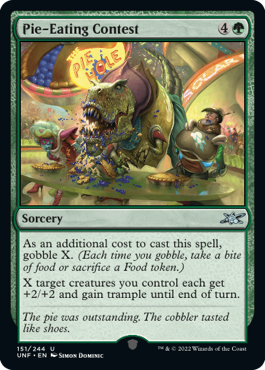
Pie-Eating Contest (acorn)
{4}{G}
Sorcery
As an additional cost to cast this spell, gobble X. (Each time you gobble, take a bite of food or sacrifice a Food token.)
X target creatures you control each get +2/+2 and gain trample until end of turn.
- You choose the value of X as you're casting Pie-Eating Contest.
- All Food tokens are sacrificed at the same time. All bites of food are taken one at a time. (Can you even take two bites of food at the same time? Isn't that just a larger bite?) You are allowed to swallow between bites. In fact, we encourage it!
- Gum isn't food. Trust us on this one.
- If you cast Pie-Eating Contest without paying its mana cost, you can still choose any value for X and choose targets accordingly because the X isn't in the mana cost.
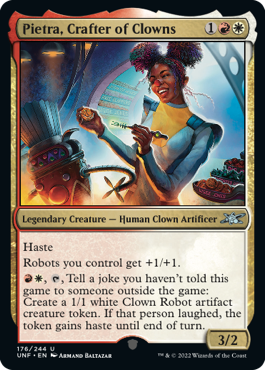
Pietra, Crafter of Clowns (acorn)
{1}{R}{W}
Legendary Creature — Human Clown Artificer
3/2
Haste
Robots you control get +1/+1.
{R}{W}, {T}, Tell a joke you haven't told this game to someone outside the game: Create a 1/1 white Clown Robot artifact creature token. If that person laughed, the token gains haste until end of turn.
- Robot is a creature type. There may be creatures that appear to be robotic in nature that don't have the Robot creature type. They won't get +1/+1 from Pietra's second ability. That ability affects all Robots you control, not only the tokens created by the last ability.
- Each joke you tell should be appropriate for the audience, keeping in mind that not everyone in attendance may be aware of your personal comedic stylings.
- While you must use a new joke each time you activate Pietra's ability, you may choose the same person as the audience, especially if they think you're funny.
- You may read the joke from an outside source if you need to.
- Each Pietra you control knows what jokes you've told that game, even if that Pietra wasn't under your control when you told that joke.
- Pietra keeps a list of jokes for every player. If another player gains control of Pietra, they can tell a joke you've already told, as long as they haven't told that joke yet.
- Even the mildest laugh counts. A giggle, a guffaw, a chortle . . . they all give the Clown Robot haste.
- You may find yourself drawing quite the crowd as your joke-telling skills become legend. Make sure you identify one specific person outside the game before your joke. Only their laughter (or lack thereof) matters, even if others are rolling on the proverbial or literal floor.
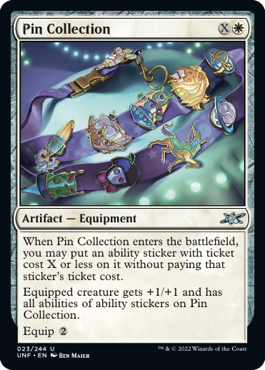
Pin Collection (eternal)
{X}{W}
Artifact — Equipment
When Pin Collection enters the battlefield, you may put an ability sticker with ticket cost X or less on it without paying that sticker's ticket cost.
Equipped creature gets +1/+1 and has all abilities of ability stickers on Pin Collection.
Equip {2}
- Pin Collection will also have the abilities of the ability stickers that are on it. If one of them is an activated ability, both the instance on Pin Collection and the instance the equipped creature has can be activated. If one of them is a triggered ability, each of the two instances (Pin Collection's and equipped creature's) will trigger separately.
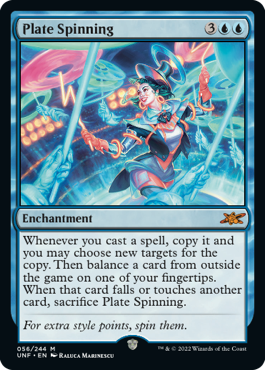
Plate Spinning (acorn)
{3}{U}{U}
Enchantment
Whenever you cast a spell, copy it and you may choose new targets for the copy. Then balance a card from outside the game on one of your fingertips. When that card falls or touches another card, sacrifice Plate Spinning.
- You can't use tape or other outside assistance to keep the card on your finger.
- You can use the fingers on both of your hands. Good luck.
- You must balance the cards from outside the game on your own fingertips, but you are allowed to get outside assistance to handle your other cards in game.
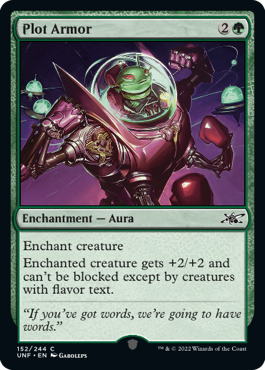
Plot Armor (acorn)
{2}{G}
Enchantment — Aura
Enchant creature
Enchanted creature gets +2/+2 and can't be blocked except by creatures with flavor text.
- Stickers can't add flavor text, even if they include words. Maybe in the sequel 2Unfinity&Beyond.
- Stickers can't remove flavor text, even if they are physically covering the flavor text.
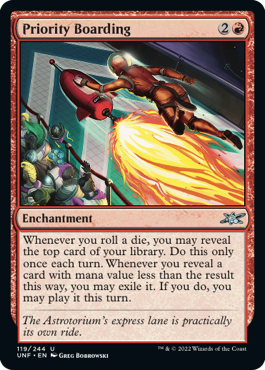
Priority Boarding (eternal)
{2}{R}
Enchantment
Whenever you roll a die, you may reveal the top card of your library. Do this only once each turn. Whenever you reveal a card with mana value less than the result this way, you may exile it. If you do, you may play it this turn.
- If you roll several dice at the same time, that will trigger the ability once for each roll. You can choose which result you want to reveal a card for.
- Once you choose to reveal the top card of your library during the resolution of Priority Boarding's ability, that ability won't trigger again that turn, no matter how many more dice you roll. This is true even if the card you reveal has a mana value too great to be exiled or you reveal a card you could exile but choose not to.
- Priority Boarding doesn't change when you can play the exiled card. For example, if you exile a sorcery card, you can cast it only during your main phase when the stack is empty. If you exile a land card, you can play it only during your main phase and only if you have an available land play remaining.
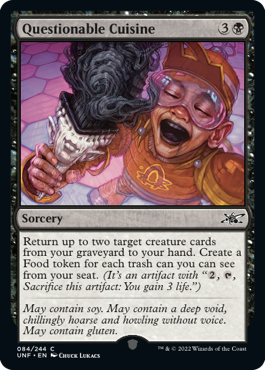
Questionable Cuisine (acorn)
{3}{B}
Sorcery
Return up to two target creature cards from your graveyard to your hand. Create a Food token for each trash can you can see from your seat. (It's an artifact with "{2}, {T}, Sacrifice this artifact: You gain 3 life.")
- You must remain in your seat while looking around the room. No, you can't pick up your seat and walk around to get more Food.
- Trash cans are receptacles whose main purpose is storing garbage. They are often lined with garbage bags. A bag by itself isn't a trash can. A can isn't a trash can if storing garbage is not its primary purpose, even if it contains trash (e.g. a soda can with gum wrappers inside).
- You can't bring your own trash cans. They must be native to the room you're in.
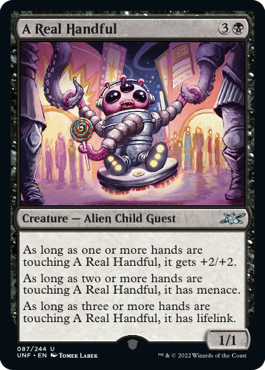
A Real Handful (acorn)
{3}{B}
Creature — Alien Child Guest
1/1
As long as one or more hands are touching A Real Handful, it gets +2/+2.
As long as two or more hands are touching A Real Handful, it has menace.
As long as three or more hands are touching A Real Handful, it has lifelink.
- Generally, only hands attached to humans count for these abilities. Hands of cards don't count, nor do hands of clocks, hands of dolls, and so on. Every hand that touches A Real Handful must do so willingly.
- The same hand can be touching multiple A Real Handfuls at the same time.
- Bonuses will turn on and off as the number of hands touching A Real Handful changes. Touching A Real Handful isn't a game action, so it doesn't use the stack. You can just do it at any time.
- Pay attention to whether the +2/+2 bonus is applying or not. Damage can suddenly become lethal if A Real Handful loses the bonus after damage has been dealt to it.
- Menace matters only as blockers are being declared. If A Real Handful doesn't have menace and is blocked by one creature, giving it menace won't change or undo that block.
- Lifelink matters only as damage is dealt.
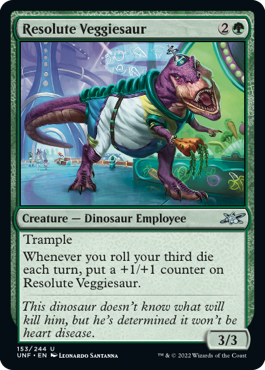
Resolute Veggiesaur (eternal)
{2}{G}
Creature — Dinosaur Employee
3/3
Trample
Whenever you roll your third die each turn, put a +1/+1 counter on Resolute Veggiesaur.
- If you roll multiple dice at the same time, and one of them is your third die roll that turn, Resolute Veggiesaur's ability will trigger. It's not necessary (or, in some cases, possible) to identify which roll was the third.
- Remember that if a die is rerolled, that counts only as a single roll. The original roll doesn't count. Similarly, any die roll that's ignored doesn't count.
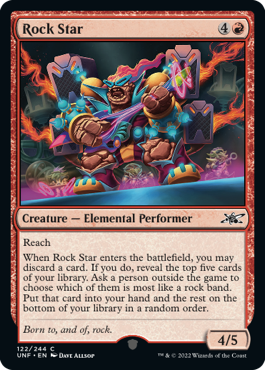
Rock Star (acorn)
{4}{R}
Creature — Elemental Performer
4/5
Reach
When Rock Star enters the battlefield, you may discard a card. If you do, reveal the top five cards of your library. Ask a person outside the game to choose which of them is most like a rock band. Put that card into your hand and the rest on the bottom of your library in a random order.
- You can't influence their decision. You must simply present the options, ask the question, and let them decide.
- The outside person's pick is final. It's a subjective call, and it doesn't matter if they're clearly wrong.
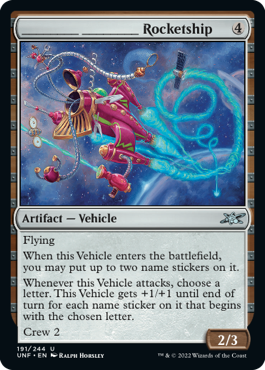
______ ______ Rocketship (eternal)
{4}
Artifact — Vehicle
2/3
Flying
When this Vehicle enters the battlefield, you may put up to two name stickers on it.
Whenever this Vehicle attacks, choose a letter. This Vehicle gets +1/+1 until end of turn for each name sticker on it that begins with the chosen letter.
Crew 2
- When determining what a name begins with, ignore all spaces and punctuation, including blank lines.
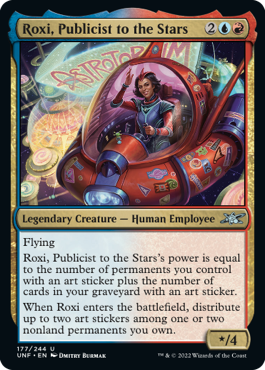
Roxi, Publicist to the Stars (eternal)
{2}{U}{R}
Legendary Creature — Human Employee
*/4
Flying
Roxi, Publicist to the Stars's power is equal to the number of permanents you control with an art sticker plus the number of cards in your graveyard with an art sticker.
When Roxi enters the battlefield, distribute up to two art stickers among one or two nonland permanents you own.
- The ability that defines Roxi's power functions in all zones, not just the battlefield. If Roxi is on the battlefield or in your graveyard and it has an art sticker, it counts toward the total.
- Roxi's enters-the-battlefield ability allows you to put two art stickers on a single permanent you own or one art sticker on each of two permanents you own.
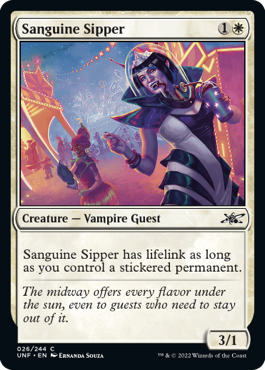
Sanguine Sipper (eternal)
{1}{W}
Creature — Vampire Guest
3/1
Sanguine Sipper has lifelink as long as you control a stickered permanent.
- The stickered permanent could be Sanguine Sipper itself or another permanent you control.

Saw in Half (eternal)
{2}{B}
Instant
Destroy target creature. If that creature dies this way, its controller creates two tokens that are copies of that creature, except their base power is half that creature's power and their base toughness is half that creature's toughness. Round up each time.
- If the creature isn't destroyed (perhaps because it has indestructible), its controller doesn't create any tokens. The same is true if the creature is destroyed but instead of going to its owner's graveyard, a replacement effect moves it elsewhere, such as exile.
- Use the power and toughness of the creature from when it was last on the battlefield to determine the power and toughness of the tokens.
- Except for power and toughness, the token copies exactly what was printed on the original creature and nothing else (unless that creature was copying something else or it's a token; see below). It doesn't copy whether that creature was tapped or untapped, whether it had any counters on it or Auras and Equipment attached to it, and so on.
- If the original creature had a characteristic-defining ability that determined its power and/or toughness, that ability is not copied.
- If the copied creature had {X} in its mana cost, X is considered to be 0.
- If the chosen creature was a token, the new tokens copy the original characteristics of that token as stated by the effect that created the token, plus the listed exceptions.
- If the copied creature was copying something else, then the tokens enter the battlefield as whatever that creature copied, with the exceptions noted above.
- Any enters-the-battlefield abilities of the copied creature will trigger when the tokens enter the battlefield. Any "as [this creature] enters the battlefield" or "[this creature] enters the battlefield with" abilities of the chosen creature will also work.
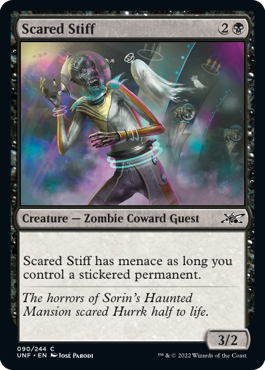
Scared Stiff (eternal)
{2}{B}
Creature — Zombie Coward Guest
3/2
Scared Stiff has menace as long you control a stickered permanent.
- The stickered permanent could be Scared Stiff itself or another permanent you control.
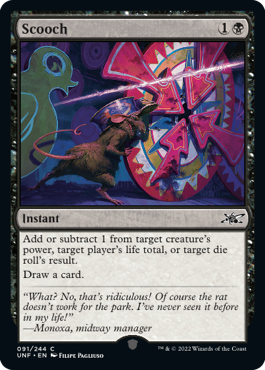
Scooch (acorn)
{1}{B}
Instant
Add or subtract 1 from target creature's power, target player's life total, or target die roll's result.
Draw a card.
- Adding or subtracting 1 to a creature's power will give it +1/+0 or -1/0, respectively. Note that this effect doesn't have a duration and will last until the creature leaves the battlefield.
- Adding or subtracting 1 from a player's life total will cause that player to gain or lose 1 life, respectively.
- Targeting a die roll requires some Un- magic. Just after a die roll, during the time when die roll modifications are allowed, announce you're casting Scooch. It goes on the stack and can be responded to. If the card you draw is another Scooch, or if we don't learn from this and it's some other card that's castable mid-die roll, you get . . . priority? Sure, priority! You can cast that card. This all happens while the spell, ability, Attraction visit, or replacement effect (?!) that prompted the original die roll is resolving. Un- magic!
- You can change a result to something normally not possible on the die in question, such as a 0 or a 7 on a six-sided die.
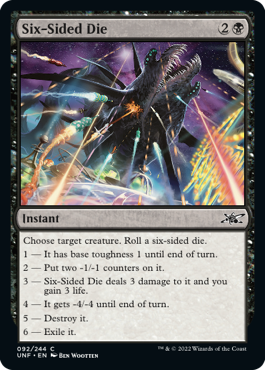
Six-Sided Die (eternal)
{2}{B}
Instant
Choose target creature. Roll a six-sided die.
1 — It has base toughness 1 until end of turn.
2 — Put two -1/-1 counters on it.
3 — Six-Sided Die deals 3 damage to it and you gain 3 life.
4 — It gets -4/-4 until end of turn.
5 — Destroy it.
6 — Exile it.
- You choose the target creature as you cast Six-Sided Die. You don't roll the die until the spell begins resolving. At that point, it's too late for players to respond.
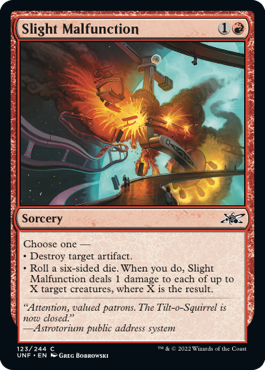
Slight Malfunction (eternal)
{1}{R}
Sorcery
Choose one —
• Destroy target artifact.
• Roll a six-sided die. When you do, Slight Malfunction deals 1 damage to each of up to X target creatures, where X is the result.
- If you choose the second mode, Slight Malfunction goes on the stack without any targets. As it resolves, you roll a six-sided die. This causes the reflexive triggered ability trigger. You choose the targets for that ability as it goes on the stack.
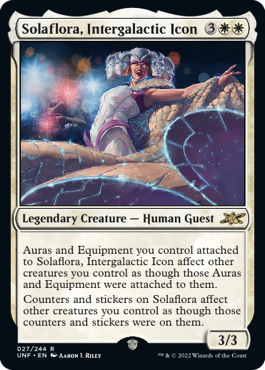
Solaflora, Intergalactic Icon (acorn)
{3}{W}{W}
Legendary Creature — Human Guest
3/3
Auras and Equipment you control attached to Solaflora, Intergalactic Icon affect other creatures you control as though those Auras and Equipment were attached to them.
Counters and stickers on Solaflora affect other creatures you control as though those counters and stickers were on them.
- Although the Auras and Equipment attached to Solaflora will affect other creatures you control as though they were the enchanted or equipped creatures, those creatures aren't actually enchanted or equipped. For example, if an effect refers to equipped creatures you control, it wouldn't count another creature you control that doesn't have an Equipment attached to it, even if Solaflora is equipped.
- The same is true with respect to counters and stickers. Other creatures will get the benefits (or, occasionally, drawbacks) of those things, but other creatures don't have counters or stickers on them unless they actually do.
- If a name sticker is on Solaflora, the word it adds to the name is also added to each other creature's name, and it's added in the same spot in that name. For example, if it is added after the first and second word in her name, it will be added just after the first word in each other creature's name.
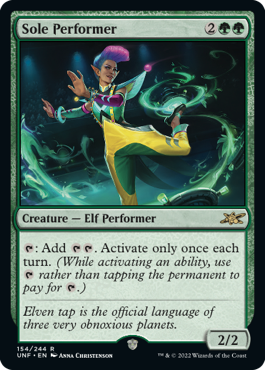
Sole Performer (acorn)
{2}{G}{G}
Creature — Elf Performer
2/2
{T}: Add {T}{T}. Activate only once each turn. (While activating an ability, use {T} rather than tapping the permanent to pay for {T}.)
- Sole Performer turns {T} into a resource you can add, much like mana. You spend {T} to pay for that symbol appearing in the costs of activated abilities. If you spend a {T} you have, you don't have to tap the permanent that has the ability.
- For example, say you control Prize Wall, which has "{U}, {T}: You get {TK}." You activate Sole Performer to get {T}{T}. You then activate Prize Wall, spending {U} and one of the {T}s you got from Sole Performer. You could then activate Prize Wall again, spending another {U} and the other {T}. Prize Wall itself is still untapped at this point. You can then activate Prize Wall a third time, spending a third {U} and finally actually tapping Prize Wall.
- You lose unused {T} as steps and phases end, at the same time you lose unspent mana.
- Although {T} acts in many ways like mana, it is not mana. An ability that triggers from a creature tapping to add mana wouldn't trigger when you activate Sole Performer's ability, for example.
- Spending {T} allows you to activate the tap ability of a creature that's already tapped. Normally, you couldn't pay the cost of tapping the creature because it's already tapped. With Sole Performer, you don't have to worry about that. You have {T}!
- Spending {T} rather than tapping the permanent doesn't let you activate abilities of creatures that have "summoning sickness." That is, if a creature's ability has {T} in the cost, and it hasn't been under your control since the beginning of your most recent turn, you can't activate the ability (unless the creature has haste), even if you intend to spend {T} rather than tap the creature.
- You can't spend {T} to have a creature attack without tapping. You also can't use it to pay the cost of an ability that taps a creature without using the {T} symbol. For example, you can't activate an ability that says "Tap an untapped creature you control: [Do something]" with {T}.
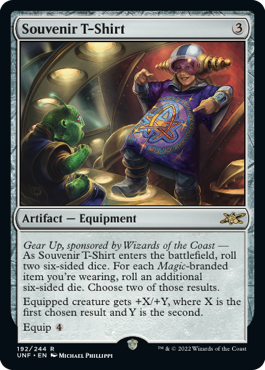
Souvenir T-Shirt (acorn)
{3}
Artifact — Equipment
Gear Up, sponsored by Wizards of the Coast — As Souvenir T-Shirt enters the battlefield, roll two six-sided dice. For each Magic-branded item you're wearing, roll an additional six-sided die. Choose two of those results.
Equipped creature gets +X/+Y, where X is the first chosen result and Y is the second.
Equip {4}
- A "Magic-branded item" is an article of clothing or wearable accessory (jewelry, etc.) that includes a Magic logo, symbols, artwork, or other brand-identifying markings. Anything that's usually paired (socks, earrings, and so on) count as one item.
- You choose which result applies to power and which applies to toughness.
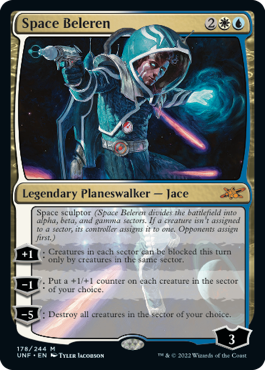
Space Beleren (eternal)
{2}{W}{U}
Legendary Planeswalker — Jace
3
Space sculptor (Space Beleren divides the battlefield into alpha, beta, and gamma sectors. If a creature isn't assigned to a sector, its controller assigns it to one. Opponents assign first.)
+1: Creatures in each sector can be blocked this turn only by creatures in the same sector.
−1: Put a +1/+1 counter on each creature in the sector of your choice.
−5: Destroy all creatures in the sector of your choice.
- Any time Space Beleren is on the battlefield, the battlefield is divided into three sectors: alpha, beta, and gamma. All creatures will be assigned to one of the three sectors.
- The sectors are essentially designations that change how Space Beleren's other abilities will affect creatures on the battlefield. The sectors have no other effect on gameplay. Specifically, unless Space Beleren's first loyalty ability has been activated, sector assignments have no effect on combat. A creature in one sector can block an attacking creature in another sector.
- A creature can never be in more than one sector. If Space Beleren is on the battlefield, another Space Beleren coming under a player's control won't affect any creature's sector assignment.
- While Space Beleren is on the battlefield, any time there are creatures on the battlefield that aren't assigned to a sector, those creatures are assigned to a sector by their controllers as a state-based action. First, all players who don't control a Space Beleren (or another permanent with space sculptor, but come on) in turn order assign their creatures. Then all players who do control a Space Beleren in turn order assign their creatures.
- As soon as there are no permanents with space sculptor on the battlefield, all sector assignments are lost. Notably, this means that if Space Beleren's +1 ability has been activated earlier in the turn, creatures are no longer restricted from blocking, so watch out! If another (or the same) Space Beleren returns to the battlefield, creatures on the battlefield at that time will once again be assigned to sectors, but their new sector assignments are not influenced by any previous sector assignments they may have had.
- A creature that changes controllers maintains its sector assignment: its new controller can't give it a new one.
- Sector assignment isn't copiable. If a creature enters the battlefield as a copy of a creature in alpha sector, for example, its controller may assign it to any sector.
- For the last two abilities, you choose the sector as the ability resolves.
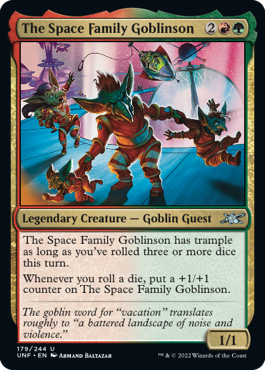
The Space Family Goblinson (eternal)
{2}{R}{G}
Legendary Creature — Goblin Guest
1/1
The Space Family Goblinson has trample as long as you've rolled three or more dice this turn.
Whenever you roll a die, put a +1/+1 counter on The Space Family Goblinson.
- Remember that if a die is rerolled, that counts only as a single roll. The original roll doesn't count. Similarly, any die roll that's ignored doesn't count.
- If you roll more than one die at a time, however, that does count as multiple die rolls.
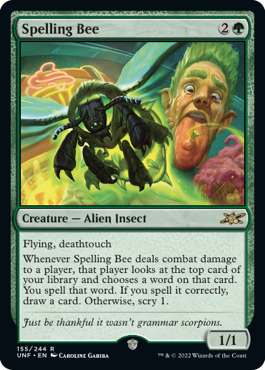
Spelling Bee (acorn)
{2}{G}
Creature — Alien Insect
1/1
Flying, deathtouch
Whenever Spelling Bee deals combat damage to a player, that player looks at the top card of your library and chooses a word on that card. You spell that word. If you spell it correctly, draw a card. Otherwise, scry 1.
- The player looking at the top card of your library can choose any word from the card's name, type line, or text box. Notably, they can't choose a word that's only in the artwork or artist credit. It doesn't have to be a real word from a dictionary; Astroquarium is a perfectly cromulent word, for example.
- If you spell the word correctly, the card you draw will be the card that includes the word. If you don't, the card you look at to scry 1 will be that card.
- If a redirection effect causes a Spelling Bee you control to deal combat damage to you, you'll look at the top card of your own library and will choose a word to spell. No one else will be able to verify you did it correctly, but we'll give you the benefit of the doubt.
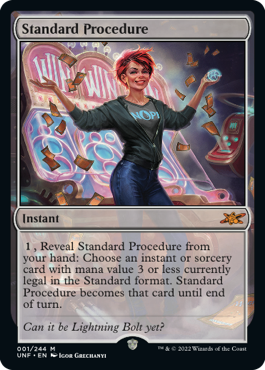
Standard Procedure (acorn)
Instant
{1}, Reveal Standard Procedure from your hand: Choose an instant or sorcery card with mana value 3 or less currently legal in the Standard format. Standard Procedure becomes that card until end of turn.
- At the time of Unfinity's release, the following card sets are permitted in the Standard format: Innistrad: Midnight Hunt, Innistrad: Crimson Vow, Kamigawa: Neon Dynasty, Streets of New Capenna, and Dominaria United. Notably, and thankfully, Unfinity is not Standard-legal. Go to Magic.Wizards.com/Formats for a complete list of formats and their permitted card sets and banned lists.
- Standard Procedure's effect isn't a copy effect. It becomes the chosen card until end of turn. Treat it just as though it were the chosen card. For example, say you chose Lightning Strike. That card is now Lightning Strike. After you cast it, it would go to your graveyard. If it got shuffled into your library, it would still be Lightning Strike. You could then find it while searching your library for a red card, for example. For all intents and purposes, it is the chosen card for the turn no matter what happens to it.
- If you choose a card with {X} in its mana cost, {X} is considered to be 0 when determining whether the card's mana value is 3 or less.
- After activating Standard Procedure's ability, it stays revealed in your hand until the ability resolves. If Standard Procedure is no longer in your hand at that time, it won't become the chosen card.
- The chosen card must be Standard-legal, even if you're playing a different format.
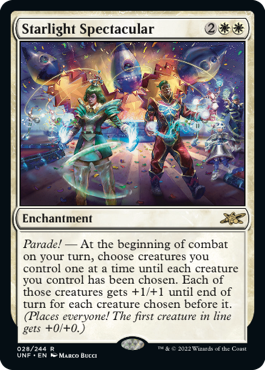
Starlight Spectacular (eternal)
{2}{W}{W}
Enchantment
Parade! — At the beginning of combat on your turn, choose creatures you control one at a time until each creature you control has been chosen. Each of those creatures gets +1/+1 until end of turn for each creature chosen before it. (Places everyone! The first creature in line gets +0/+0.)
- If you control more than one Starlight Spectacular, each one calculates its bonuses separately. For example, if you control three creatures and two Starlight Spectaculars, each Spectacular will give one creature +0/+0, another +1/+1 and the third +2/+2. You could choose a different order for each one though.
- You don't have to line up the creatures in a parade line to get the bonuses, but it would be spectacular if you did.
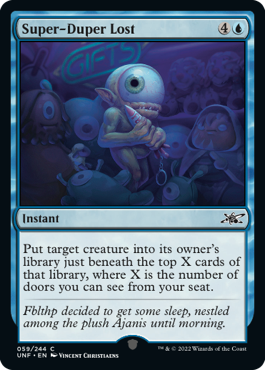
Super-Duper Lost (acorn)
{4}{U}
Instant
Put target creature into its owner's library just beneath the top X cards of that library, where X is the number of doors you can see from your seat.
- You must remain in your seat while looking around the room. No, you can't pick up your seat and go through doors to find more doors to increase the value of X.
- The doors you're looking for are the kind you'd find built into walls. Doors that are parts of other objects, such as cabinet doors, don't count. Car doors don't count.
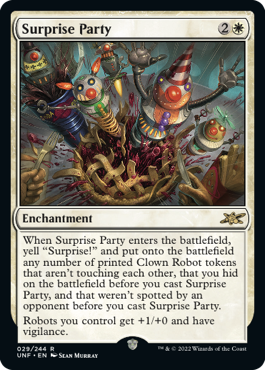
Surprise Party (acorn)
{2}{W}
Enchantment
When Surprise Party enters the battlefield, yell "Surprise!" and put onto the battlefield any number of printed Clown Robot tokens that aren't touching each other, that you hid on the battlefield before you cast Surprise Party, and that weren't spotted by an opponent before you cast Surprise Party.
Robots you control get +1/+0 and have vigilance.
- "Printed Clown Robot tokens" are official printed creature tokens which are both Clowns and Robots. You can use the ones that appear in some Unfinity booster packs, or ones from any other set that happens to include tokens that are both Clowns and Robots.
- You're allowed to hide the tokens anywhere on the battlefield, broadly interpreted as the table where your game is taking place.
- The tokens can be hidden under other cards or objects, face up or face down, as long as they aren't touching each other. No stacks o' Clowns.
- You must hide the tokens while the game is in progress.
- You can't break other rules while hiding the tokens. For example, even if we interpreted your library as part of the battlefield for this purpose, slipping one into the card sleeve of a card in your library during a search effectively marks your deck, and that's not allowed.
- Your opponents may report that they've spotted a Robot Clown token even if they can't literally see it, provided they can identify where it is. That is, you can't just put your hand over it and claim that can't see it. Well, you can claim that, and it might be true, but it didn't work for Entirely Normal Armchair and it won't work this time either.
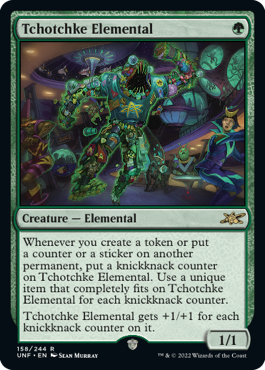
Tchotchke Elemental (acorn)
{G}
Creature — Elemental
1/1
Whenever you create a token or put a counter or a sticker on another permanent, put a knickknack counter on Tchotchke Elemental. Use a unique item that completely fits on Tchotchke Elemental for each knickknack counter.
Tchotchke Elemental gets +1/+1 for each knickknack counter on it.
- A "unique item" can be anything as long as it fits completely on the card and you don't use the same thing twice. Two items are considered the same for this ability (which is to say, one of them is not unique) if they have the same or nearly the same shape, size, and colors. For example, a 2020 U.S. quarter is the same as a 2021 U.S. quarter, but it's not the same as a Canadian quarter or a U.S. nickel. If all players can't agree, you may ask an outside person for a final determination.
- The knickknack counters can touch each other.
- Each knickknack counter must be represented by a different object. You can't use a die to represent multiples, for example. But you could use a six-sided die to represent one and a twenty-sided die to represent another.
- Other counters on Tchotchke Elemental can be represented normally.
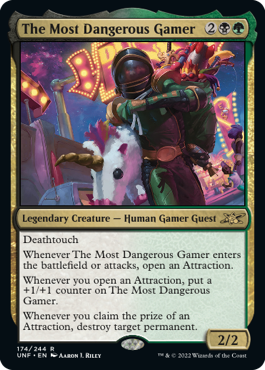
The Most Dangerous Gamer (eternal)
{2}{B}{G}
Legendary Creature — Human Gamer Guest
2/2
Deathtouch
Whenever The Most Dangerous Gamer enters the battlefield or attacks, open an Attraction.
Whenever you open an Attraction, put a +1/+1 counter on The Most Dangerous Gamer.
Whenever you claim the prize of an Attraction, destroy target permanent.
- Only certain Attractions allow you to claim a prize. These will have the text "Prize —" on them.
- Though this card is eternal, there is currently only one eternal Attraction which allows you to claim the prize: Pick-a-Beeble. If you want to take advantage of the last ability, it's best if you're playing an Un- game, unless you want an appropriate level of challenge for someone calling themselves The Most Dangerous Gamer.
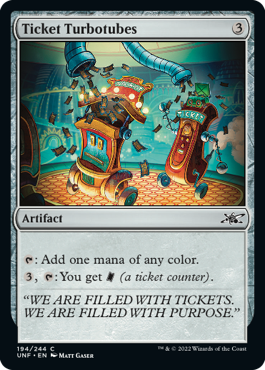
Ticket Turbotubes (eternal)
{3}
Artifact
{T}: Add one mana of any color.
{3}, {T}: You get {TK} (a ticket counter).
- The last ability gives you a ticket counter, but it doesn't enable you to put a sticker on anything. That ticket can be spent if another effect later allows you to put a sticker on something.
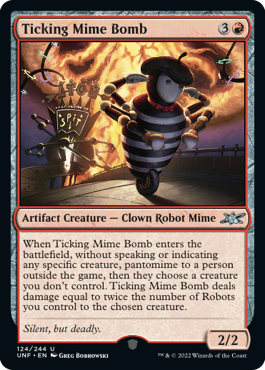
Ticking Mime Bomb (acorn)
{3}{R}
Artifact Creature — Clown Robot Mime
2/2
When Ticking Mime Bomb enters the battlefield, without speaking or indicating any specific creature, pantomime to a person outside the game, then they choose a creature you don't control. Ticking Mime Bomb deals damage equal to twice the number of Robots you control to the chosen creature.
- To pantomime means to act out or express something in an exaggerated fashion without speaking. You're trying to get the outside person to guess the creature based on your expressions and movements. You can't just point to the creature you want them to pick.
- You aren't allowed to speak while pantomiming, but you can explain to the outside person what's going to happen before you begin as long as you don't try to give them hints about which creature to pick.
- If the outside person chooses one of your creatures, consider briefly why you didn't fully explain to the outside person what's going to happen, and ask them to choose a creature you don't control.
- Count the number of Robots you control as the ability resolves to determine how much damage to deal. If Ticking Mime Bomb is still under your control and still a Robot, it will count itself. Quietly.
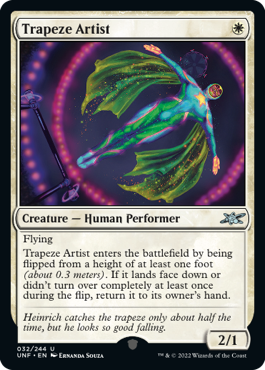
Trapeze Artist (acorn)
{W}
Creature — Human Performer
2/1
Flying
Trapeze Artist enters the battlefield by being flipped from a height of at least one foot (about 0.3 meters). If it lands face down or didn't turn over completely at least once during the flip, return it to its owner's hand.
- To "turn over completely" means to do a full 360° rotation. Trapeze Artist should start with its back facing the table, then at some point midflight its front should face the table, and then its back should once again face the table. That's the minimum for a successful entrance. More flips are optional but encouraged.
- If Trapeze Artist is a token, use a printed token or another Magic card to execute the flip.
- There's no opportunity for any player to do anything between the Trapeze Artist's chaotic, orblike entrance and it returning to its owner's hand if unsuccessful.
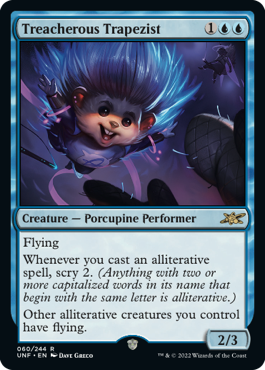
Treacherous Trapezist (acorn)
{1}{U}{U}
Creature — Porcupine Performer
2/3
Flying
Whenever you cast an alliterative spell, scry 2. (Anything with two or more capitalized words in its name that begin with the same letter is alliterative.)
Other alliterative creatures you control have flying.
- The words can be the same word. Casting Decisions, Decisions or Monitor Monitor will cause you to scry 2.
- An alliterative spell or creature can have other words in its name, capitalized or not, as long as it has two or more capitalized words that begin with the same letter. The two words don't even need to be adjacent to one another.
- Questionable Cuisine is not alliterative. Celestial Crusader is. It's true that in the real world, alliteration usually refers to the repetition of sounds at the beginnings of words, but it's also true that porcupines are usually not very aerodynamic, so let's not get hung up on reality, okay?
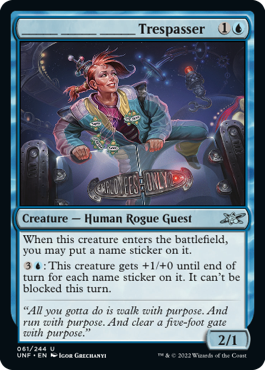
_____ _____ _____ Trespasser (eternal)
{1}{U}
Creature — Human Rogue Guest
2/1
When this creature enters the battlefield, you may put a name sticker on it.
{3}{U}: This creature gets +1/+0 until end of turn for each name sticker on it. It can't be blocked this turn.
- You can activate this creature's last ability even if it doesn't have any name stickers on it.
- Activating the last ability after blockers have been declared won't change or undo any blocks.
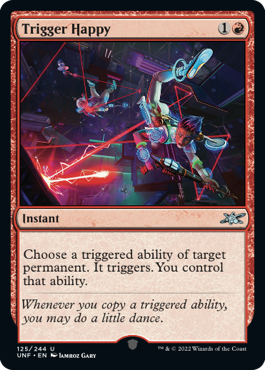
Trigger Happy (acorn)
{1}{R}
Instant
Choose a triggered ability of target permanent. It triggers. You control that ability.
- Triggered abilities are abilities that start with "When", "Whenever", or "At", generally at the start of a paragraph on the permanent. You can't choose reflexive or delayed triggered abilities; these are triggered abilities that occur in the middle of a paragraph, usually after some kind of action or choice.
- You can choose triggered abilities which are represented by keywords, such as exalted. Most of those keywords will have "When", "Whenever", or "At" in their reminder texts. The visit ability of an Attraction is a triggered ability, so you can choose it. However, the "Prize" section on an Attraction is not a triggered ability, so that can't be chosen separately. Nevertheless, you'll get the prize if you choose the visit ability on that Attraction and successfully claim the prize.
- If a triggered ability is triggered with this spell, you ignore its trigger event—typically all the text between "When", "Whenever", or "At" until the first comma—and only consider the remaining text in that ability. For example, Complains Clerk has "Whenever you roll a 1, create a 1/1 white Clown Robot artifact creature token." If you choose that ability, you ignore everything up to the first comma, ending up with "Create a 1/1 white Clown Robot artifact creature token."
- Some triggered abilities have an "intervening if" clause—that is, they are written in the form of "When/Whenever/At [trigger event], if [condition], [effect]." If you choose such an ability with Trigger Happy, you ignore the trigger event, and the ability will go on the stack even if the intervening if condition is not fulfilled, but the ability will still check the intervening if condition as the ability tries to resolve. If the condition is not fulfilled at that time, then the ability won't resolve. For example, Tatyova, Steward of Tides has the ability "Whenever a land enters the battlefield under your control, if you control seven or more lands, [effect]." If you choose that ability, it will go on the stack regardless of how many lands you control. However, as the ability tries to resolve, if you don't control seven or more lands, the ability fails to resolve and the effect doesn't happen.
- Because you control the ability, you choose any targets it requires.
- You can use Trigger Happy to cause abilities to trigger at unusual times. Sometimes that will make sense and be great. Sometimes it won't.
- The ability that triggered will think that it triggered at the normal time and for the normal reason. It may refer to attacking creatures you control, except it's your opponent's end step. It may be looking for a card in the graveyard after a dies trigger, but the creature is still sitting on the battlefield. It may be looking for the spell that caused it to trigger, but there was no spell. If the triggered ability can't determine the information it needs, or if it can't find the objects it expects to find in certain zones, those parts of the effect just do nothing.
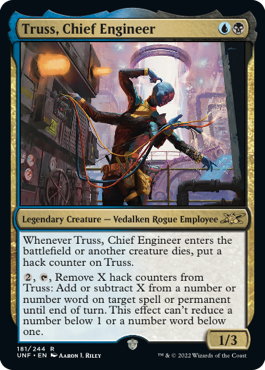
Truss, Chief Engineer (acorn)
{U}{B}
Legendary Creature — Vedalken Rogue Employee
1/3
Whenever Truss, Chief Engineer enters the battlefield or another creature dies, put a hack counter on Truss.
{2}, {T}, Remove X hack counters from Truss: Add or subtract X from a number or number word on target spell or permanent until end of turn. This effect can't reduce a number below 1 or a number word below one.
- Truss's last ability affects a single number or number word on the spell or permanent. It can be anything—power, toughness, something in rules text, the name of a card (Four Wishes, anyone?), collector number, and so on. Mark says you can even change the copyright date, but don't tell the lawyers.
- Note that you're changing numbers, not digits. For example, if you remove two hack counters from Truss, you could change 10 to 12 or 8. You couldn't change it to 30.
- Indefinite articles such as "a" in "draw a card" aren't number words and can't be modified.
- You can't change any instance of X.
- You can change the numeral inside of a mana symbol, but you can't modify the cost of a spell in time to pay less for it. It must already be on the stack to be a valid target for Truss's ability.
- You can change the number of dice rolled for an effect only if the original instruction included a number word to describe how many dice to roll. You can't change the "a" in "roll a six-sided die," but you could change the "two" in "roll two six-sided dice."
- You can change the number of sides on a die. If you don't have any thirteen-sided dice handy, you can use other dice to simulate the rolls.
- You can't use Truss's last ability to change the 1 in Truss's last ability to a 0. Nice try though.
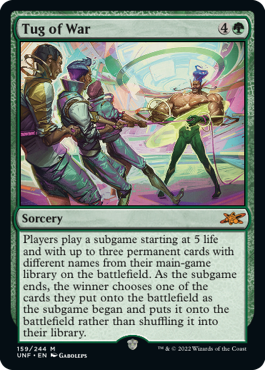
Tug of War (acorn)
{4}{G}
Sorcery
Players play a subgame starting at 5 life and with up to three permanent cards with different names from their main-game library on the battlefield. As the subgame ends, the winner chooses one of the cards they put onto the battlefield as the subgame began and puts it onto the battlefield rather than shuffling it into their library.
- To play a subgame, all players start a new game using their libraries as their decks. Any supplementary decks a player has (for example, an Attraction deck) also get shuffled and brought into the subgame. No other cards, tokens, emblems, or anything else from the main game are included in the subgame unless otherwise specified here or in the effect that created that subgame.
- In a Constructed format, each player selects a new set of sticker sheets at the start of the subgame from among all sticker sheets they have (including the ones in the main game) the same way they do at the start of a normal game of Magic. This doesn't impact the sticker sheets they are allowed to use in the main game.
- In a Limited format, each player selects three sticker sheets at the start of the subgame from among all sticker sheets they opened (including the ones in the main game) the same way they would at the start of a normal game of Magic. This doesn't have any effect on which sticker sheets they are allowed to use in the main game.
- In a Commander game, if a commander is in the command zone, its owner puts it into the command zone of the subgame and removes all stickers from it. After the subgame, each player may put any commanders they own in the subgame into the command zone of the main game. If a commander was in the command zone of the subgame, it automatically moves to the command zone of the main game.
- As players are shuffling their main-game libraries to form their subgame libraries, they should set aside the cards they wish to have on the subgame battlefield as the subgame begins.
- If a player has fewer than seven cards in their main-game library, they'll lose the subgame as it begins, regardless of how many mulligans that player takes.
- After subgame mulligans are complete, the starting player puts the cards they set aside onto the battlefield. Each other player in turn order does the same.
- If any abilities trigger during this process, they'll be put on the stack the next time a player gets priority, usually during the subgame's first upkeep.
- If the subgame is a draw, no player won the subgame, so nobody gets to put a permanent onto the battlefield in the main game.
- After the subgame ends, each player shuffles their cards from the subgame to re-form their main-game library (and Attraction deck, if applicable), and they return to the main game from the point they left off, with Tug of War finishing resolving and the winner of the subgame getting their reward. No counters, stickers, or other effects from the subgame move back into the main game.
- The card that the subgame winner puts onto the main-game battlefield doesn't have to come from the subgame battlefield. It could have died, been shuffled into a library, or anything else during the subgame.

Urza's Fun House (acorn)
Land — Urza's
{T}: Add {C}.
{T}: Add {∞}. Activate only once and only if you control an Urza's Mine, an Urza's Power-Plant, and an Urza's Tower.
{7}, {T}: Head to AskUrza.com and click Urza's Fun House.
- The middle ability can be activated only once. Not once per turn. Once. Okay, maybe more times. If Urza's Fun House leaves the battlefield and returns, it's a new object, so you can activate it again. You know, in case INFINITE MANA wasn't enough the first time.
- The mana added by the middle ability is colorless mana.
- Once you have infinite colorless mana, it doesn't matter how much mana you spend, you will still have infinite colorless mana. You will, however, lose infinite unspent mana as that step or phase ends.
- You can do a lot of cool stuff with infinite mana. And some situations may not be obvious. Rather than rehash everything ad infinitum, perhaps the Gatherer rulings on Infinity Elemental will help.
- The Urza's Mine, Urza's Power-Plant, and Urza's Tower required to activate the middle ability needn't be three separate permanents. If you happen to control a land that has those four land types (or perhaps one that has all land types . . . you know . . . glances up . . . it's a different card in this . . . Nearby Planet!), you can activate the ability.
- AskUrza.com, the web site that powers Urza, Academy Headmaster, has expanded to support Urza's Fun House. On that site you'll find a button that says "ENTER THE FUN HOUSE." As the last ability resolves, click it and find out what you paid seven mana for!
- The last ability works a little differently with respect to targeting. Unlike other abilities, you may have to choose targets while that ability is resolving. If the effect that comes up requires a target and there are no legal targets available, click again until that's not true.
- If an effect comes up that requires a target and there are legal targets available, you must use that effect even though you may not want to. However, the effects are all good for you or bad for your opponent. In some cases, you may not be able to take advantage. For example, if it ends up that creatures you control get +3/+3 until end of turn but you don't control any creatures, you're out of luck. But nothing bad will happen.
- Players can respond to the activation of the last ability, but not after players know what effect is going to happen.
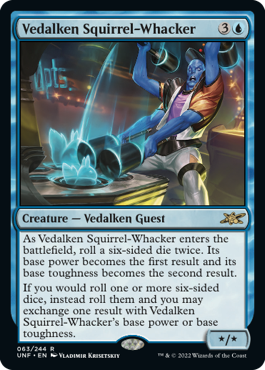
Vedalken Squirrel-Whacker (eternal)
{3}{U}
Creature — Vedalken Guest
*/*
As Vedalken Squirrel-Whacker enters the battlefield, roll a six-sided die twice. Its base power becomes the first result and its base toughness becomes the second result.
If you would roll one or more six-sided dice, instead roll them and you may exchange one result with Vedalken Squirrel-Whacker's base power or base toughness.
- The two die rolls to set initial base power and toughness are separate and sequential. If you want to reroll the first die, you must do so before you roll the second die.
- Vedalken Squirrel-Whacker's second ability functions only while Vedalken Squirrel-Whacker is on the battlefield. Specially, the second ability can't affect rolls of the first ability.
- After rolling one or more six-sided dice and seeing the results, you decide whether you want to make the exchange. You may exchange one result at most, no matter how many dice you rolled. For example, say Vedalken Squirrel-Whacker is a 2/5 and you roll a 3. You could make Vedalken Squirrel-Whacker a 3/5 and change the die roll result to 2, make it a 2/3 and change the die roll result to 5, or leave everything how it was.
- If Vedalken Squirrel-Whacker's base power or toughness changes through some other means, it is possible to exchange a die roll so that it has a result that would normally not be possible for that die, such as, on a six-sided die, a result of 9, or 42, or -3. These are all perfectly reasonable results on a six-sided die.
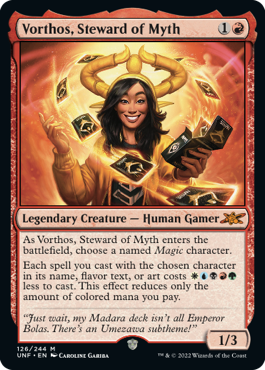
Vorthos, Steward of Myth (acorn)
{1}{R}
Legendary Creature — Human Gamer
1/3
As Vorthos, Steward of Myth enters the battlefield, choose a named Magic character.
Each spell you cast with the chosen character in its name, flavor text, or art costs {W}{U}{B}{R}{G} less to cast. This effect reduces only the amount of colored mana you pay.
- You can choose any Magic character that has ever appeared in any official product or story, including characters that have appeared only in art. You can even choose characters who don't have official names, as long as they're clearly defined characters, like the Wanderer.
- Vorthos's ability applies to any spell in which the chosen character's name appears in any form, whether that's possessive (e.g. Teferi and Teferi's Protection), or a related word (e.g. Avacyn and Avacynian Priest), or a word that's derived from their name (e.g. Niv-Mizzet and Izzet Charm).
- If a character has gone by different names, you may count all versions of that character. For example, choosing Lim-Dûl will offer you a discount on (SPOILERS) The Raven Man. Choosing Urza will offer you a discount on (SPOILERS BUT VERY OLD ONES) Blind Seer.
- As with other acorn cards, Vorthos cares only about the actual printed card you're casting to determine whether the chosen character appears. But would Vorthos want it any other way?
- Vorthos's ability cares whether the chosen character appears in the name, flavor text, or art of the card. It doesn't care about rules text, watermark, set symbol, artist, and so on. No, choosing Maro as your character doesn't let you get a discount on Look at Me, I'm the DCI.
- Unlike most abilities that reduce the costs of spells, Vorthos's ability cannot be applied to generic mana costs. For example, a spell that costs {2}{B}{G} to cast would instead cost {2} to cast. One that costs {4}{U}{U} would instead cost {4}{U}.
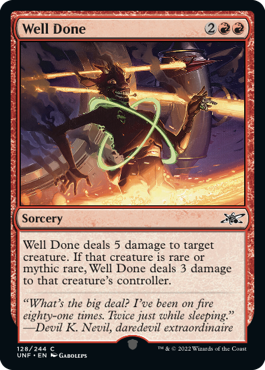
Well Done (acorn)
{2}{R}{R}
Sorcery
Well Done deals 5 damage to target creature. If that creature is rare or mythic rare, Well Done deals 3 damage to that creature's controller.
- Rare cards have gold expansion symbols. Mythic rare cards have orange expansion symbols. Cards from before Exodus don't have expansion symbols; their rarities can be found on their Gatherer entries.
- Many creatures have been printed at multiple rarities, but like all acorn cards, Well Done cares only about the rarity of the actual printed card it's roasting.
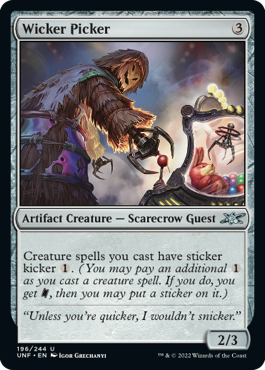
Wicker Picker (eternal)
{3}
Artifact Creature — Scarecrow Guest
2/3
Creature spells you cast have sticker kicker {1}. (You may pay an additional {1} as you cast a creature spell. If you do, you get {TK}, then you may put a sticker on it.)
- Sticker kicker is an optional additional cost that you may pay as you cast a creature spell.
- If you sticker kick a creature spell, you get {TK} and may choose a sticker to put on the creature spell.
- If you cast a creature spell you don't own, you may still choose to sticker kick it. If you do, you'll get the ticket counter, even though you can't put a sticker on a card you don't own.
- You get the ticket counter and the sticker is put on the creature spell just before it's considered cast. Any triggered abilities that trigger whenever you cast a spell with particular qualities will see the spell with the sticker applied.
- Conversely, you can't use sticker kicker to change a spell's name to get around effects that prohibit that spell from being cast (such as Meddling Mage).
- Each Wicker Picker only lets you pay the sticker kicker cost once per spell. If you control multiple Wicker Pickers, then you can pay {1} for each of them, gaining {TK} and a sticker each time.
- If you put a creature onto the battlefield without casting it, you can't sticker kick it.
- If a creature spell has kicker or multikicker and another ability that checks if it was kicked (such as Bog Badger or Phyrexian Missionary), that ability is linked to its own printed kicker or multikicker ability and will apply only if you paid its own kicker or multikicker cost. Sticker kicker won't turn on those effects. However, sticker kicker will work with cards that care about other spells being kicked, such as Elfhame Druid or Verazol, the Split Current.
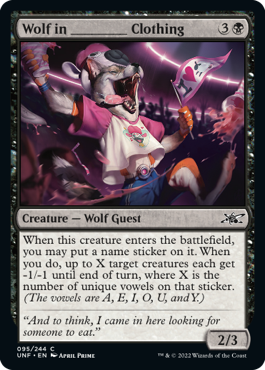
Wolf in ________ Clothing (eternal)
{3}{B}
Creature — Wolf Guest
2/3
When this creature enters the battlefield, you may put a name sticker on it. When you do, up to X target creatures each get -1/-1 until end of turn, where X is the number of unique vowels on that sticker. (The vowels are A, E, I, O, U, and Y.)
- This creature's enters-the-battlefield ability goes on the stack without any targets. As it resolves, you may put a name sticker on this creature. Doing so causes the reflexive triggered ability to trigger. You choose the targets for that ability as it goes on the stack.
- Putting a name sticker on this creature later won't cause the reflexive triggered ability to trigger.
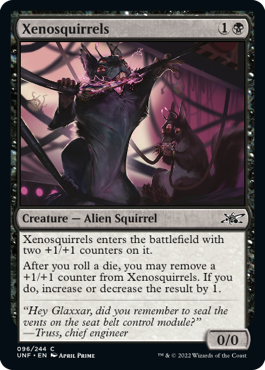
Xenosquirrels (eternal)
{1}{B}
Creature — Alien Squirrel
0/0
Xenosquirrels enters the battlefield with two +1/+1 counters on it.
After you roll a die, you may remove a +1/+1 counter from Xenosquirrels. If you do, increase or decrease the result by 1.
- You can change a result to something normally not possible on the die in question, such as a 0 or a 7 on a six-sided die.
- If you roll the planar die in a Planechase game, you can remove a +1/+1 counter from Xenosquirrels, but you can't alter the result of the roll.
UNFINITY ATTRACTIONS CARD-SPECIFIC NOTES
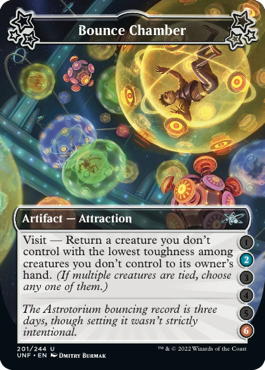

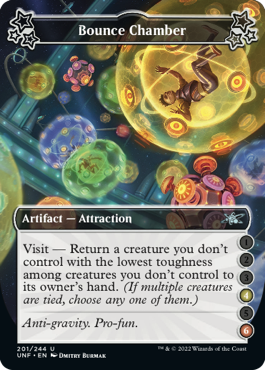
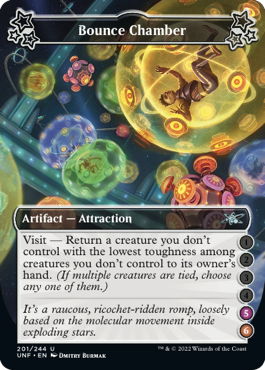
Bounce Chamber (eternal)
Artifact — Attraction
Visit — Return a creature you don't control with the lowest toughness among creatures you don't control to its owner's hand. (If multiple creatures are tied, choose any one of them.)
- Bounce Chamber doesn't target any creature. Whichever creature has the least toughness as the ability resolves is the one that gets bounced. If there's a tie, you choose one of them at that time.
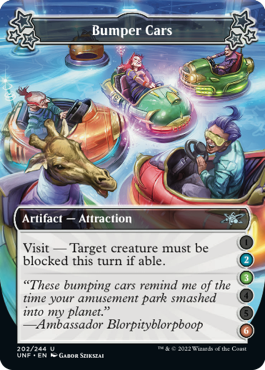
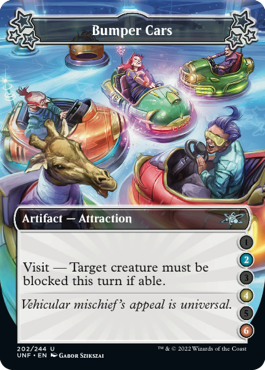
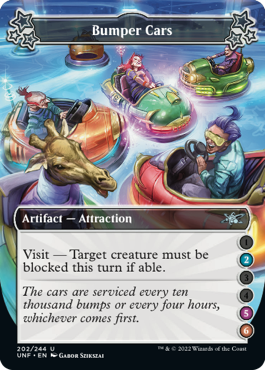
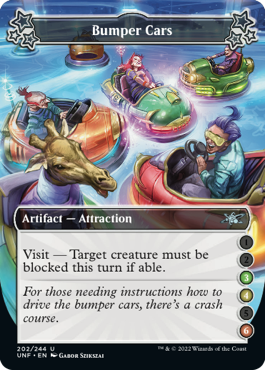
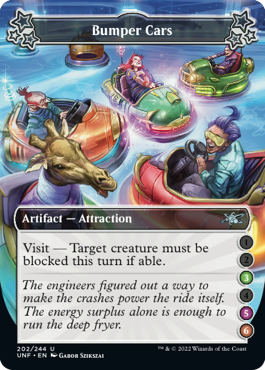
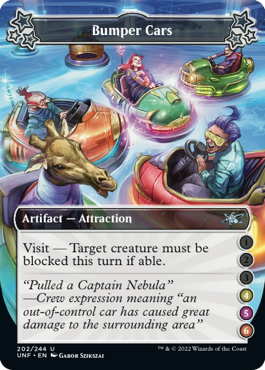
Bumper Cars (eternal)
Artifact — Attraction
Visit — Target creature must be blocked this turn if able.
- During the declare blockers step, the defending player must assign at least one blocker to each creature that must be blocked if that player controls any creatures that could block it.
- If multiple attacking creatures must be blocked, the defending player must assign blockers in such a way that the greatest number of those attacking creatures are blocked.
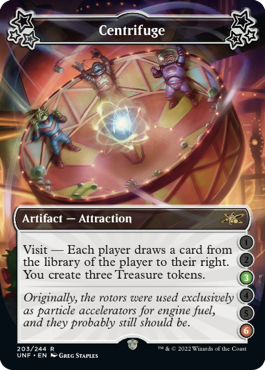
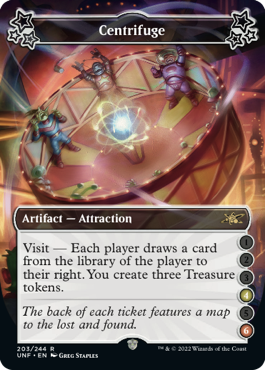
Centrifuge (acorn)
Artifact — Attraction
Visit — Each player draws a card from the library of the player to their right. You create three Treasure tokens.
- Each player draws a card from a library that isn't theirs, another Un- game exclusive. Remember to give the cards back to their owners at the end of the game.
- A card that you drew from another player's library is still owned by that player. You still can't put stickers on it.
- If you play a land or cast a permanent spell that you drew from another player's library, that permanent will enter the battlefield under your control. If you cast an instant or sorcery spell that you took from an opponent, it will go to that player's graveyard.
- If an effect instructs you to shuffle the card into your library (as opposed to "its owner's library"), you can do that. You should sleeve the card with whatever sleeves your library is using, if any.
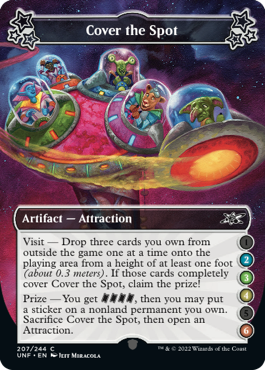
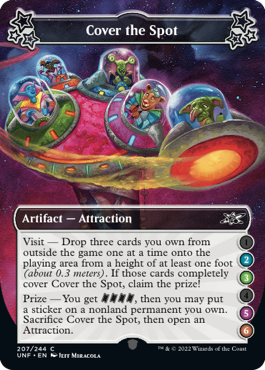
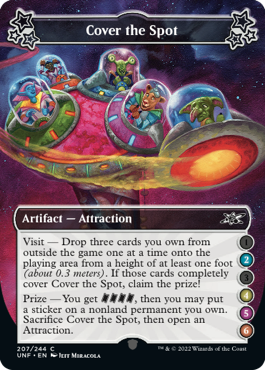
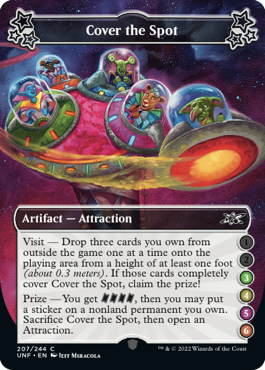
Cover the Spot (acorn)
Artifact — Attraction
Visit — Drop three cards you own from outside the game one at a time onto the playing area from a height of at least one foot (about 0.3 meters). If those cards completely cover Cover the Spot, claim the prize!
Prize — You get {TK}{TK}{TK}{TK}, then you may put a sticker on a nonland permanent you own. Sacrifice Cover the Spot, then open an Attraction.
- The cards you drop must be traditionally sized Magic cards. You can't use plane cards, oversized cards, or those giant cards that are sometimes given away as prizes or at conventions.
- The dropped cards don't have to flip, rotate, or do any other kind of acrobatics.
- Card sleeves are considered part of the card. If Cover the Spot is sleeved, the dropped cards may also be sleeved. If Cover the Spot is not sleeved, the dropped cards can't be either.
- No player may interfere with the dropping of the cards, including while they're in freefall.




Dart Throw (acorn)
Artifact — Attraction
Visit — Throw a card you own from outside the game onto the playing area from a distance of three feet (about one meter). If that card touches Dart Throw, claim the prize!
Prize — Create two 2/2 pink Teddy Bear creature tokens. Sacrifice Dart Throw, then open an Attraction.
- The card you throw must be a traditionally sized Magic card. It can be in a card sleeve if you'd like, but it can't be otherwise modified. It must be thrown onto the battlefield from at least three feet (about one meter) away horizontally.
- No player may interfere with the throwing of the card, including while it's in flight.
- Check whether the thrown card touches Dart Throw after it stops moving. If it touched Dart Throw but came to rest not touching it, that's a miss.
- Card sleeves are considered part of the card. If the thrown card (or its own card sleeve) touches Dart Throw's sleeve, it is considered to be touching Dart Throw.
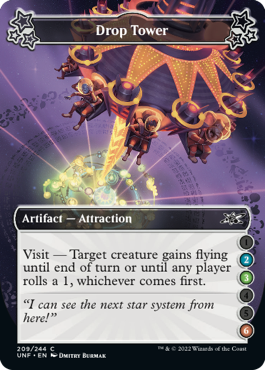
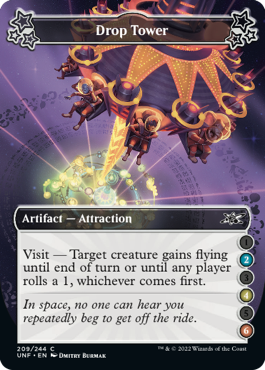
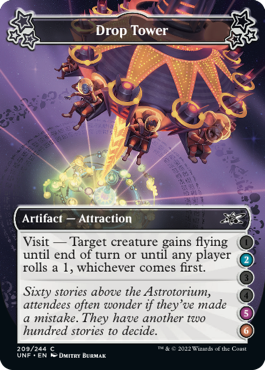
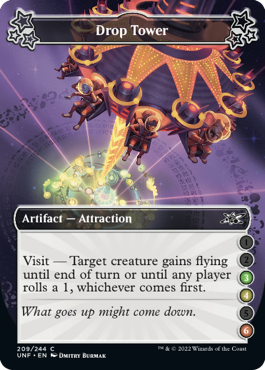
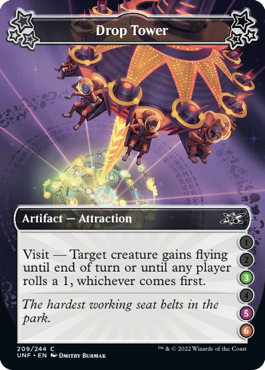
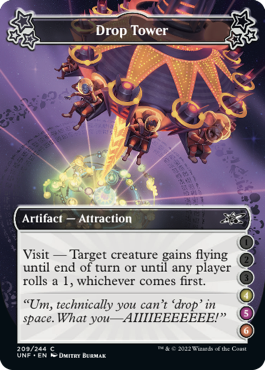
Drop Tower (eternal)
Artifact — Attraction
Visit — Target creature gains flying until end of turn or until any player rolls a 1, whichever comes first.
- As soon as a player rolls a 1, the creature will no longer be granted flying from Drop Tower. No player may take any actions between the result of die roll coming up 1 and the flying effect ending.
- You can choose Drop Tower's effect for Grand Marshal Macie's last ability. If you do, the effect won't end even if a player rolls a 1, though if that happens, the effect will end as soon as Grand Marshal Macie untaps.
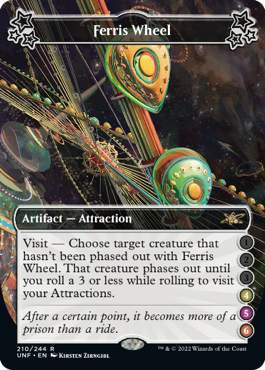
Ferris Wheel (eternal)
Artifact — Attraction
Visit — Choose target creature that hasn't been phased out with Ferris Wheel. That creature phases out until you roll a 3 or less while rolling to visit your Attractions.
- Each Ferris Wheel that comes under your control is a new, exciting experience. Its ability can target creatures that have been phased out in the past by other Ferris Wheels.
- Similarly, if a creature rides the Ferris Wheel, leaves the battlefield, and then returns to the battlefield, it will be a new object with no memory of being phased out by the Ferris Wheel. It is again a legal target.
- If you visit Ferris Wheel and there are no legal targets to choose, the ability is removed from the stack and has no effect. However, if there's at least one legal target, you must choose one, even if it's a creature you don't want to phase out.
- Phased-out permanents are treated as though they don't exist. They can't be the targets of spells or abilities, their static abilities have no effect on the game, their triggered abilities can't trigger, they can't attack or block, and so on.
- As a permanent is phased out, Auras and Equipment attached to it also phase out at the same time. Those Auras and Equipment will phase in at the same time that creature does, and they'll phase in still attached to that permanent.
- Permanents usually phase back in during their controller's untap step, immediately before that player untaps their permanents. But Ferris Wheel isn't so forgiving. The phased-out creatures will stay phased out until a player rolls a 3 or less. If a permanent had counters or stickers on it when it phased out, it will have them when it phases back in.
- An attacking or blocking creature that phases out is removed from combat.
- Phasing out doesn't cause any "leaves the battlefield" abilities to trigger. Similarly, phasing in won't cause any "enters the battlefield" abilities to trigger.
- Any continuous effects with a "for as long as" duration ignore phased-out objects. If ignoring those objects causes the effect's conditions to no longer be met, the duration will expire.
- Choices made for permanents as they entered the battlefield are remembered when they phase in.
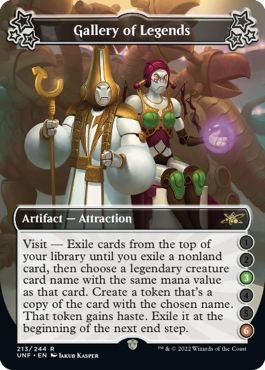
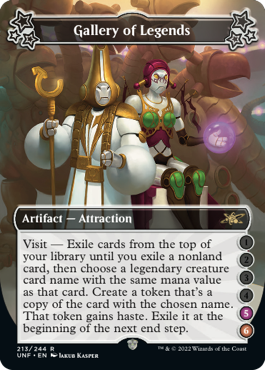
Gallery of Legends (acorn)
Artifact — Attraction
Visit — Exile cards from the top of your library until you exile a nonland card, then choose a legendary creature card name with the same mana value as that card. Create a token that's a copy of the card with the chosen name. That token gains haste. Exile it at the beginning of the next end step.
- You can find a card's official card text in the Gatherer card database at Gatherer.Wizards.com.
- In most cases, the token will have all the usual copiable values of the card with the chosen name—that is, it will have its name, mana cost, types, abilities, power, toughness, and so on. However, if you can produce the actual card you've named, the token will also have that card's art, watermarks, and flavor text.
- If the card with the chosen name has {X} in its mana cost, {X} is 0.
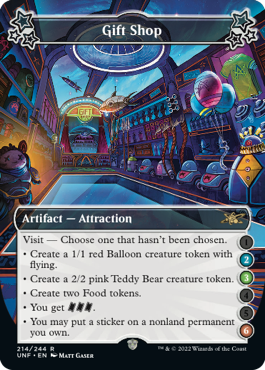
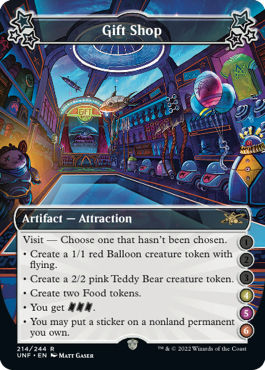
Gift Shop (acorn)
Artifact — Attraction
Visit — Choose one that hasn't been chosen.
• Create a 1/1 red Balloon creature token with flying.
• Create a 2/2 pink Teddy Bear creature token.
• Create two Food tokens.
• You get {TK}{TK}{TK}.
• You may put a sticker on a nonland permanent you own.
- Gift Shop tracks which modes have been chosen, not who chose them. If another player gains control of Gift Shop and then visits it, they won't be able to choose a mode you chose while you controlled it.
- If there are no more modes to choose, the Gift Shop is sold out. The ability is removed from the stack with no effect.
- If you choose the last mode and don't put a sticker on anything, you still chose that mode. It can't be chosen again.
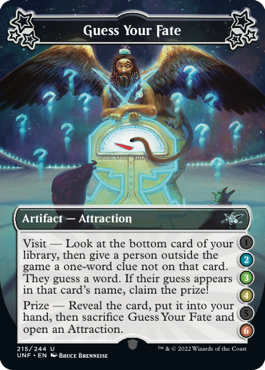
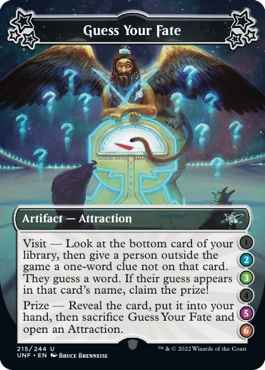
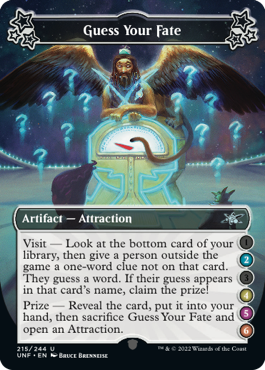
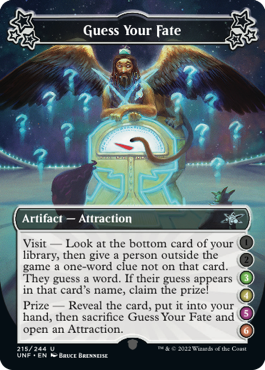
Guess Your Fate (acorn)
Artifact — Attraction
Visit — Look at the bottom card of your library, then give a person outside the game a one-word clue not on that card. They guess a word. If their guess appears in that card's name, claim the prize!
Prize — Reveal the card, put it into your hand, then sacrifice Guess Your Fate and open an Attraction.
- You can choose any word in the card's name.
- Hyphenated words count as one word.
- The outside person gets only one guess per visit. If they guess wrong, the card remains on the bottom of your library.
- If you visit Guess Your Fate again, you may choose the same outside person. That's likely a good idea if it's the same card as they've already heard a clue.
- You can't give a clue that's a homonym of a word on the card. However, if the person outside the game guesses a word that's a homonym of a word in the card's name, you do get to claim the prize. For example, if the card is Riku of Two Reflections, you can't give the word "to" as a clue. However, if the person outside the game guesses "to," that is a homonym of "Two," so you claim the prize.
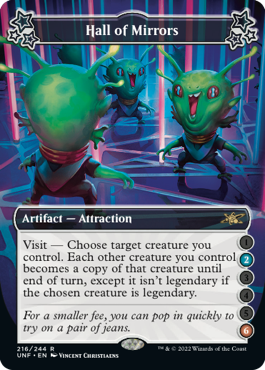
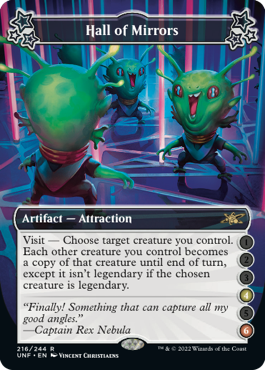
Hall of Mirrors (eternal)
Artifact — Attraction
Visit — Choose target creature you control. Each other creature you control becomes a copy of that creature until end of turn, except it isn't legendary if the chosen creature is legendary.
- Hall of Mirrors copies the printed values of the target creature. It won't copy any counters or stickers on that creature or any effects that have changed its power, toughness, types, color, and so on, and a creature becoming a copy doesn't remove any such counters or effects that are already applying to it. Notably, Hall of Mirrors won't copy any type-changing effects that are currently making the target a creature. For example, if you choose a land that's become a creature, all your other creatures will become noncreature lands until end of turn.
- If the chosen creature is copying something else, other creatures you control become copies of whatever the chosen creature is copying.
- If the target creature is a token, other creatures you control will copy the original characteristics of that token as stated by the effect that created the token. Any of those creatures that aren't tokens won't become tokens in this case. Similarly, if the target creature is a nontoken creature, creature tokens you control won't stop being tokens.
- Hall of Mirrors affects only creatures you control at the time its ability resolves. Creatures that come under your control later in the turn won't be copies of the chosen creature.
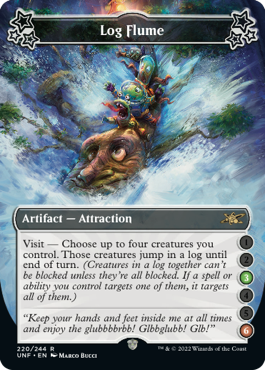
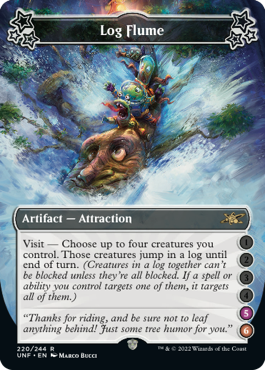
Log Flume (acorn)
Artifact — Attraction
Visit — Choose up to four creatures you control. Those creatures jump in a log until end of turn. (Creatures in a log together can't be blocked unless they're all blocked. If a spell or ability you control targets one of them, it targets all of them.)
- Creatures in the log don't have to attack, but nonattacking creatures don't affect how the attacking logmates can be blocked. Notably, not attacking with one creature in the log doesn't make the others automatically unblockable.
- The defending player(s) don't have to block any of the attacking creatures in the log. They just can't block any of them unless they block all of them.
- If the creatures in the log are attacking multiple defending players, those players declare their blocks in turn order. If any of the defending players declines to block a creature in a log attacking them or a permanent they control, other defending players can't block attacking creatures in that log attacking in their direction.
- If a defending player blocks the creatures in a log attacking in their direction, other defending players aren't obligated to do the same. If they don't, however, the first defending player's blocks are illegal, and the game rewinds and blockers are declared again. Defending players are encouraged to come up with a plan for incoming logs before this happens.
- Log Flume doesn't copy any spells or abilities that target a creature in a log. Those spells and abilities just target each creature in the log.
- If a spell or ability targets multiple creatures in the log, it targets each creature in the log for each instance of "target" that would otherwise target only a single creature in the log.
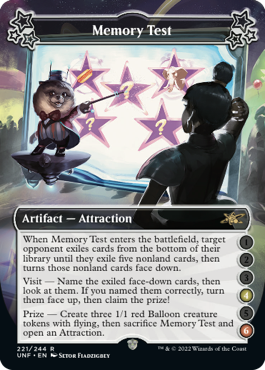
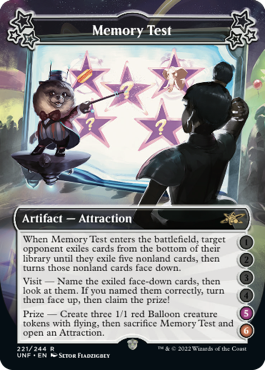
Memory Test (acorn)
Artifact — Attraction
When Memory Test enters the battlefield, target opponent exiles cards from the bottom of their library until they exile five nonland cards, then turns those nonland cards face down.
Visit — Name the exiled face-down cards, then look at them. If you named them correctly, turn them face up, then claim the prize!
Prize — Create three 1/1 red Balloon creature tokens with flying, then sacrifice Memory Test and open an Attraction.
- You get a chance to look at the exiled cards before they're turned face down. You can't take notes though.
- If the opponent exiles two of the same card, you have to name it twice.
- The exiled cards, including the land cards, remain in exile, even after you claim the prize.

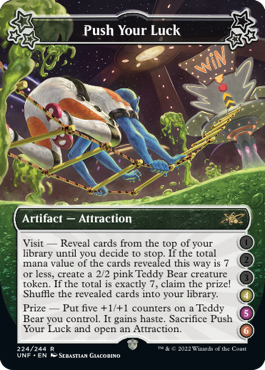
Push Your Luck (acorn)
Artifact — Attraction
Visit — Reveal cards from the top of your library until you decide to stop. If the total mana value of the cards revealed this way is 7 or less, create a 2/2 pink Teddy Bear creature token. If the total is exactly 7, claim the prize! Shuffle the revealed cards into your library.
Prize — Put five +1/+1 counters on a Teddy Bear you control. It gains haste. Sacrifice Push Your Luck and open an Attraction.
- The cards are revealed one at a time. After you see what card you've revealed, you can choose to reveal the next one or stop. You must reveal at least one card, provided your library has cards in it.
- If {X} appears in the mana costs of any of the revealed cards, {X} is 0.
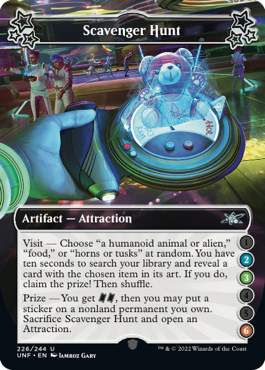
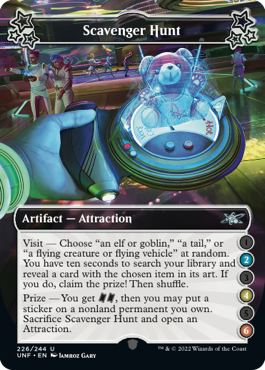
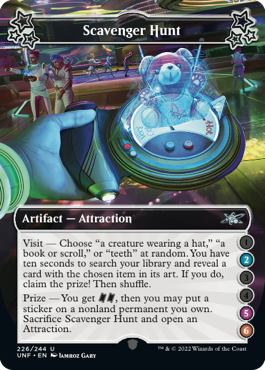
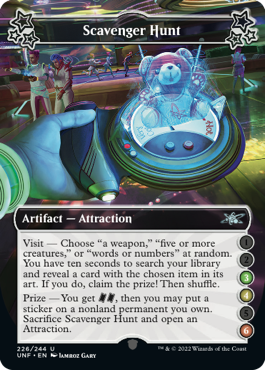
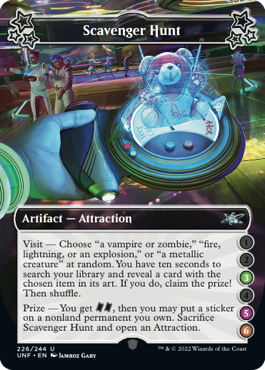
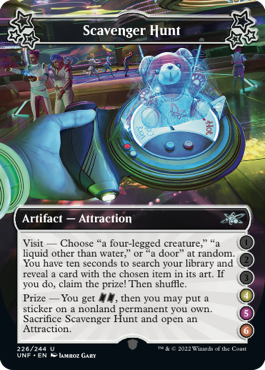
Scavenger Hunt (acorn)
Artifact — Attraction
Visit — Choose "a humanoid animal or alien," "food," or "horns or tusks" at random. You have ten seconds to search your library and reveal a card with the chosen item in its art. If you do, claim the prize! Then shuffle.
Prize — You get {TK}{TK}, then you may put a sticker on a nonland permanent you own. Sacrifice Scavenger Hunt and open an Attraction.
- The time begins once the random category has been chosen. Someone should be ready to time you or count down from ten. You can't start searching your library until the ten seconds has begun.
- You can reveal only one card from your library that has an item from the chosen category in its art.
- You shuffle whether you claim the prize or not.
- If all players can't agree if the card qualifies, you may ask an outside person for a final determination.
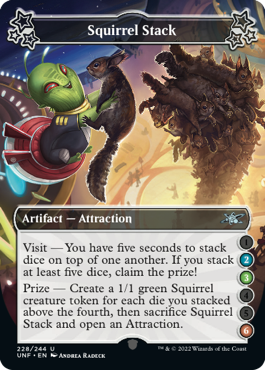
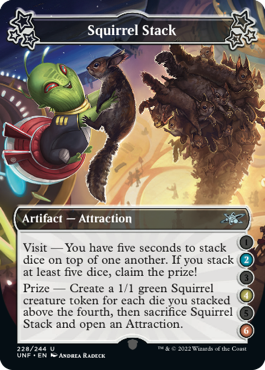
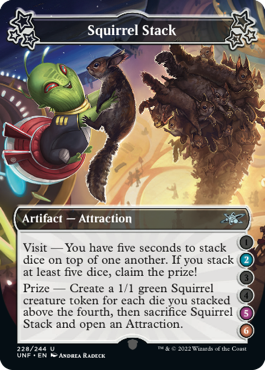
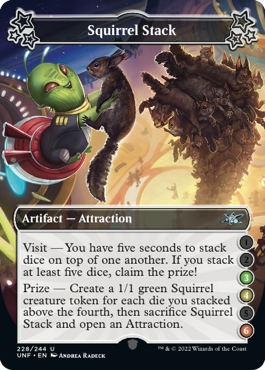
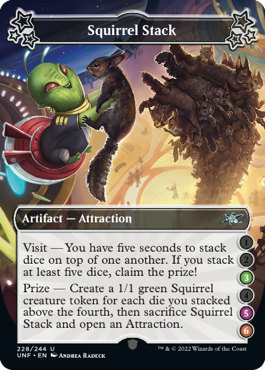
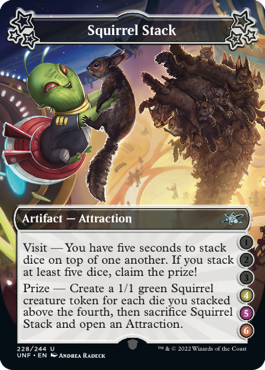
Squirrel Stack (acorn)
Artifact — Attraction
Visit — You have five seconds to stack dice on top of one another. If you stack at least five dice, claim the prize!
Prize — Create a 1/1 green Squirrel creature token for each die you stacked above the fourth, then sacrifice Squirrel Stack and open an Attraction.
- You must use actual dice, although the dice don't have to be six-sided, nor do they all have to be the same size. However, using coins and calling them "two-sided dice" isn't allowed. We recommend against using four-sided dice for this (except maybe at the top).
- The dice must stay stacked for a few seconds after the five seconds have elapsed in order to count. If they're tipping over as time expires but haven't quite fallen yet, it's not a successful stack.
- No other player may interfere with your stacking attempt, including shaking the table.
- The best stack we ever got was nine dice for five Squirrels. Happy stacking!
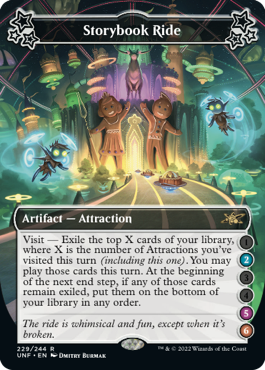
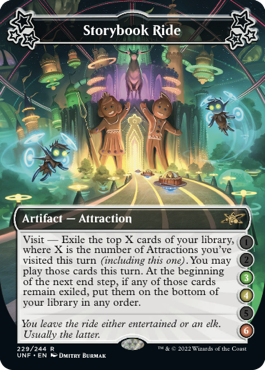
Storybook Ride (eternal)
Artifact — Attraction
Visit — Exile the top X cards of your library, where X is the number of Attractions you've visited this turn (including this one). You may play those cards this turn. At the beginning of the next end step, if any of those cards remain exiled, put them on the bottom of your library in any order.
- Storybook Ride doesn't change when you can play the exiled cards. For example, if you exile a sorcery card, you can cast it only during your main phase when the stack is empty. If you exile a land card, you can play it only during your main phase and only if you have an available land play remaining.
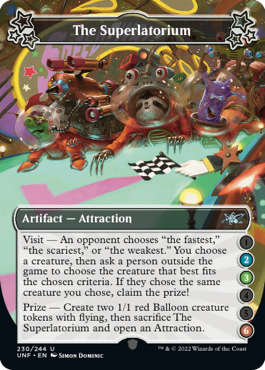
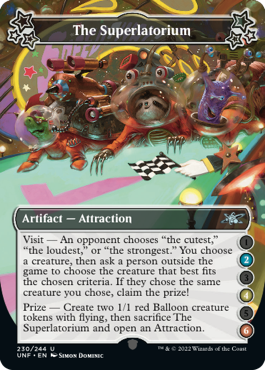
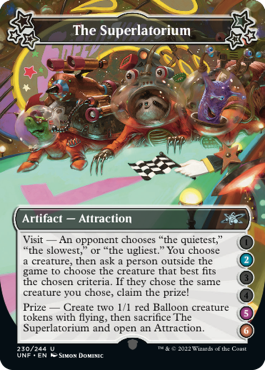
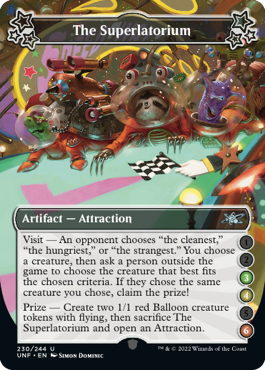
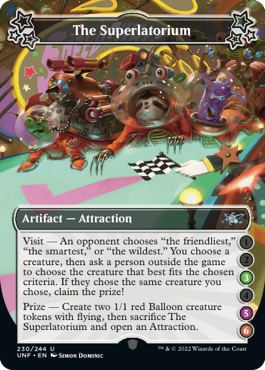
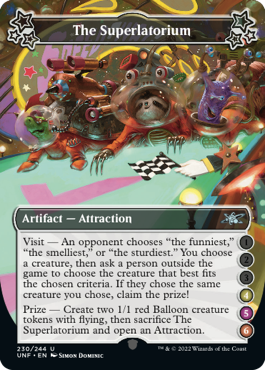
The Superlatorium (acorn)
Artifact — Attraction
Visit — An opponent chooses "the fastest," "the scariest," or "the weakest." You choose a creature, then ask a person outside the game to choose the creature that best fits the chosen criteria. If they chose the same creature you chose, claim the prize!
Prize — Create two 1/1 red Balloon creature tokens with flying, then sacrifice The Superlatorium and open an Attraction.
- The outside person should be told only the category, not which creature you chose. Their decision can't be influenced in any way. They are free to choose whichever creature they feel best fits the category.
- All categories are subjective. If there's a 1/1 Beeble and a 6/6 Elephant on the battlefield, and the outside person chooses the Elephant as "the weakest," so be it.
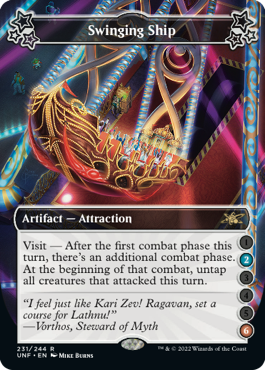
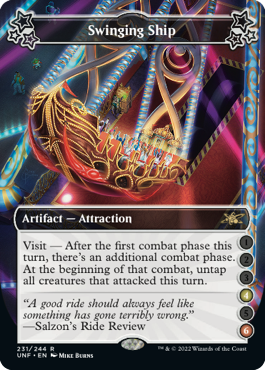
Swinging Ship (eternal)
Artifact — Attraction
Visit — After the first combat phase this turn, there's an additional combat phase. At the beginning of that combat, untap all creatures that attacked this turn.
- Swinging Ship won't untap any creatures that entered the battlefield attacking. Those creatures never attacked, meaning they were never declared as attacking creatures.
- If you visit Swinging Ship multiple times before the first combat phase of a turn has ended, that many additional combat phases will happen, one at a time. At the beginning of each of those combats, any creature that attacked during any combat that turn will untap.
- If you somehow visit Swinging Ship after the first combat phase of a turn has ended, it won't have any effect. No additional combat phase will be created.
- If you somehow visit Swinging Ship during an opponent's turn before their first combat phase ends, they will get an additional combat phase. Their creatures that attacked will untap.
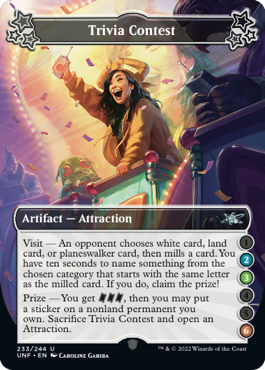
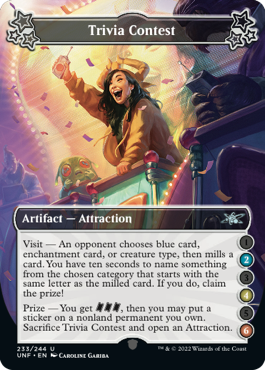
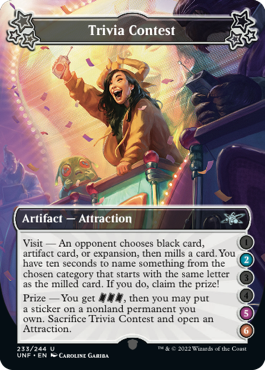
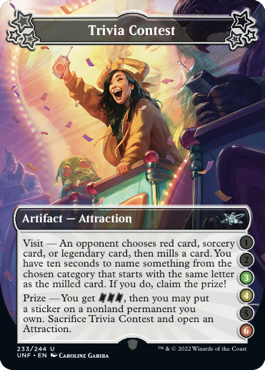
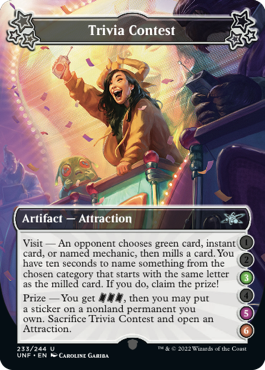
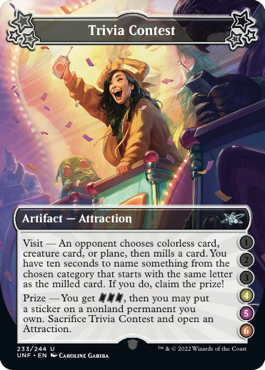
Trivia Contest (acorn)
Artifact — Attraction
Visit — An opponent chooses white card, land card, or planeswalker card, then mills a card. You have ten seconds to name something from the chosen category that starts with the same letter as the milled card. If you do, claim the prize!
Prize — You get {TK}{TK}{TK}, then you may put a sticker on a nonland permanent you own. Sacrifice Trivia Contest and open an Attraction.
- The ten seconds starts once the card is milled. Someone should be ready to start a timer or start counting down from ten.
- You can't look up cards online before naming something, even if you're fast enough to do it within ten seconds. That would be impressive. But also cheating.
- The official card database at Gatherer.Wizards.com is available to settle disputes if players can't agree if the named card fits the chosen category.
- If you're choosing a card name, every name that starts with a letter starts with the same letter as itself. If the milled card fits the chosen category, you can just choose that name.
- You can only name actual Magic cards from products that have been released. Things that have been previewed but not released yet don't count.
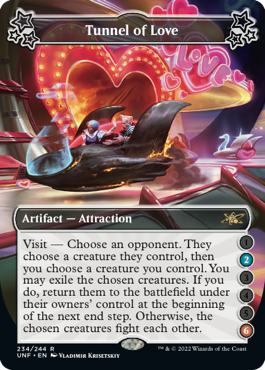
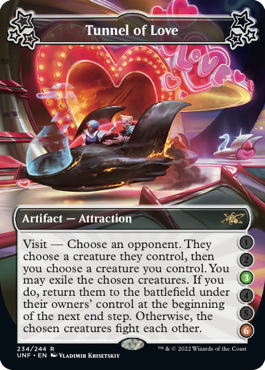
Tunnel of Love (eternal)
Artifact — Attraction
Visit — Choose an opponent. They choose a creature they control, then you choose a creature you control. You may exile the chosen creatures. If you do, return them to the battlefield under their owners' control at the beginning of the next end step. Otherwise, the chosen creatures fight each other.
- If either you or the chosen opponent controls no creatures, the other player still chooses a creature they control. You can exile that creature and return it to the battlefield under its owner's control at the beginning of the next end step. If you don't exile it, nothing happens. It won't fight anything.
©2022 Wizards of the Coast LLC Wizards of the Coast, Magic: The Gathering, their logos, Magic, Unfinity, Adventures in the Forgotten Realms, Exodus, and the WUBRGCT symbols are property of Wizards in the USA and other countries. U.S. Pat. No. RE 37,957.

